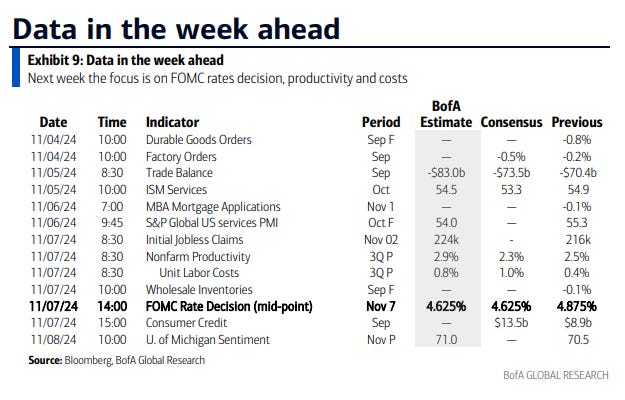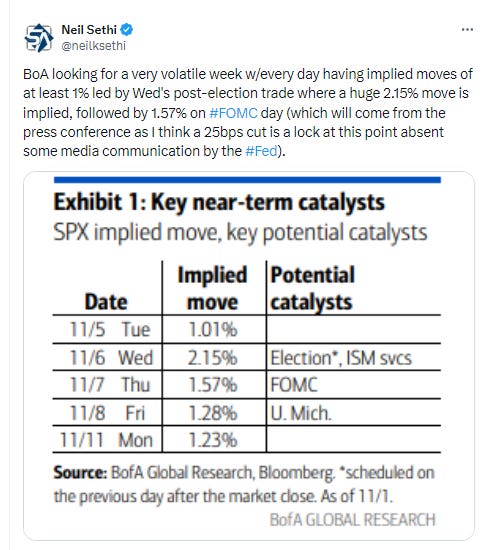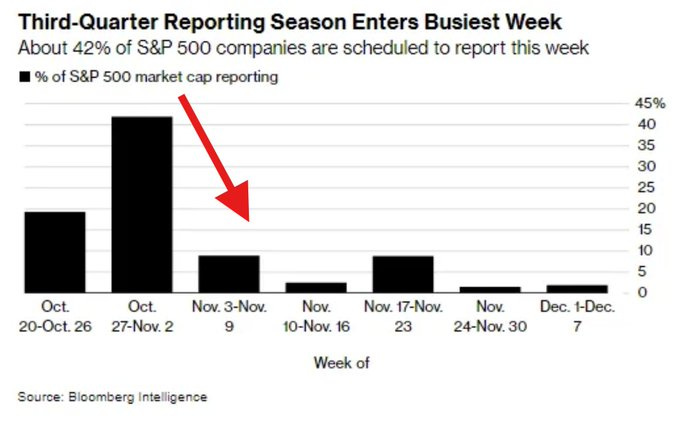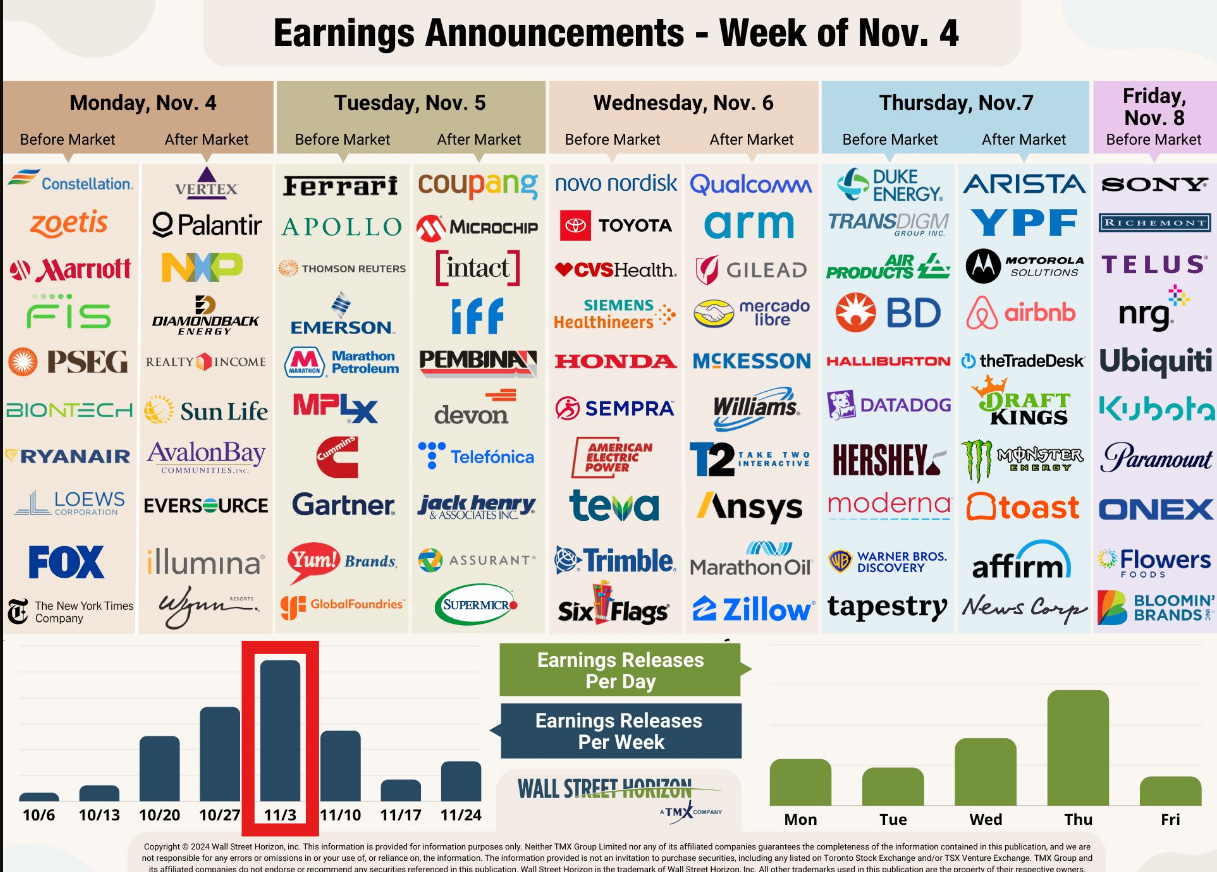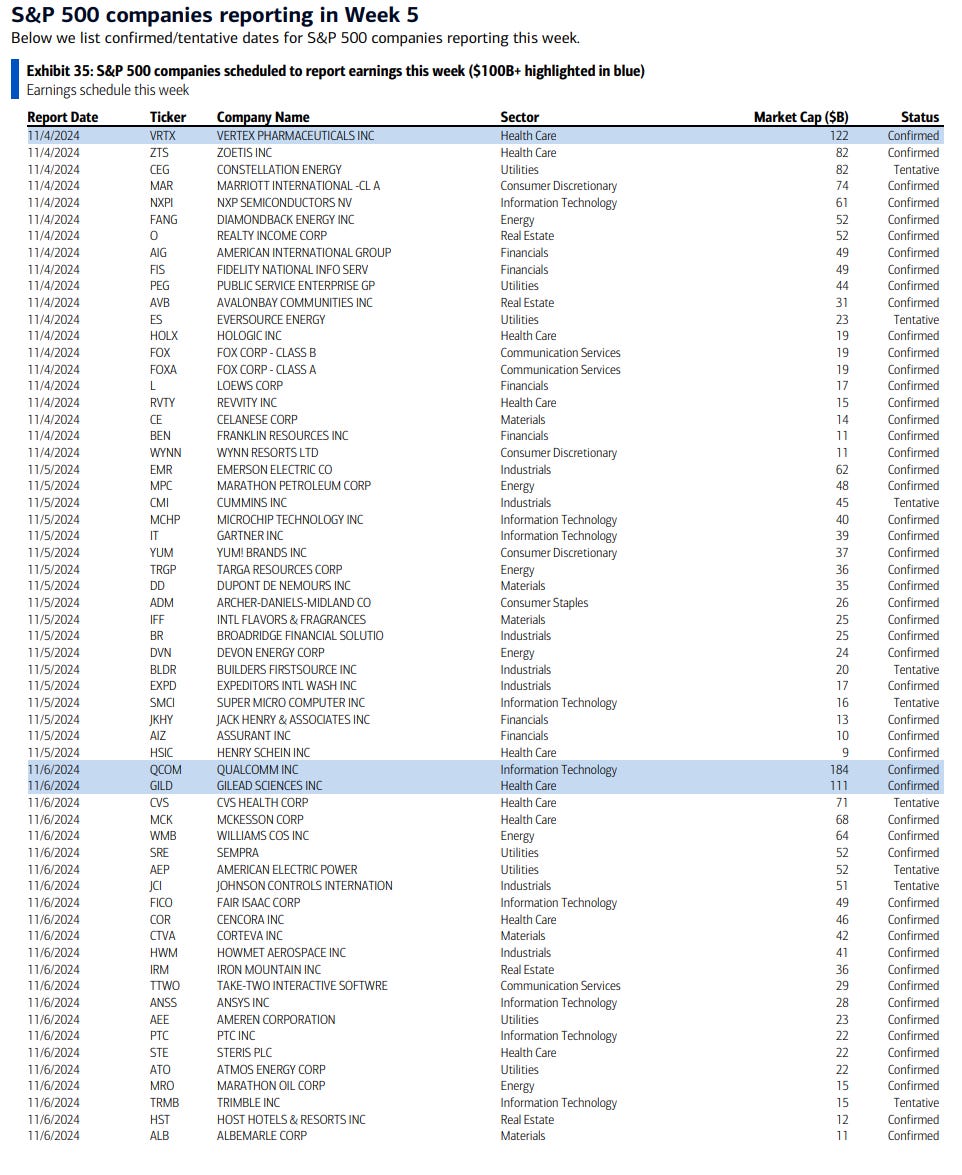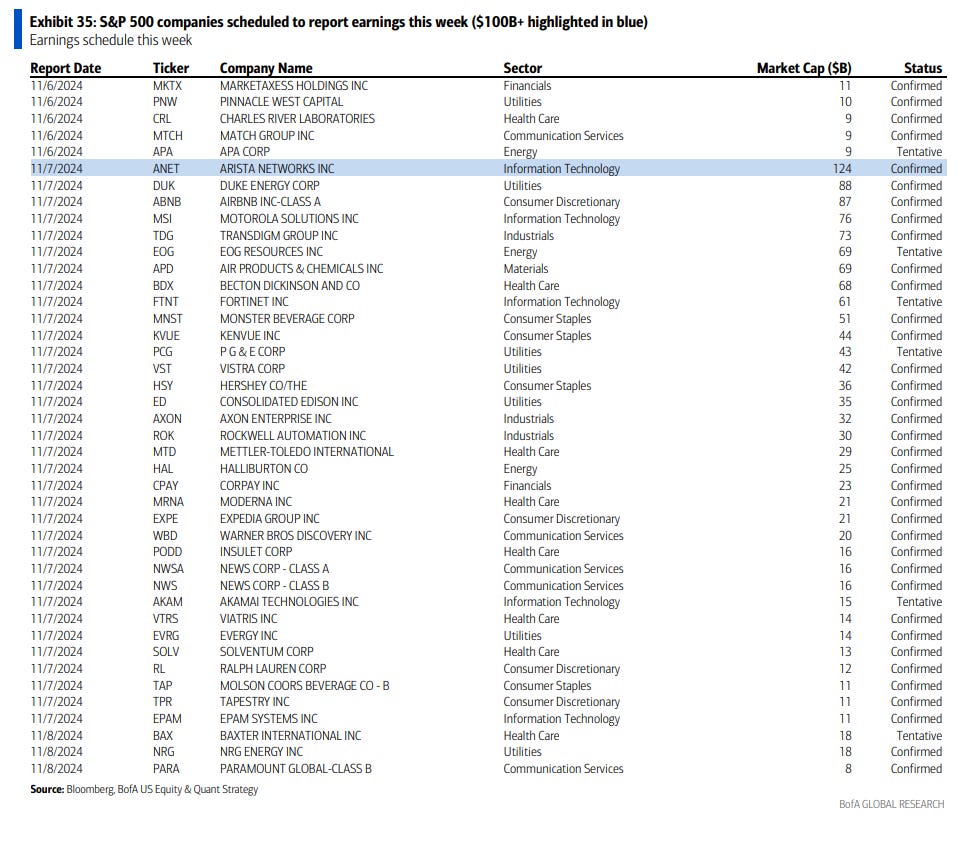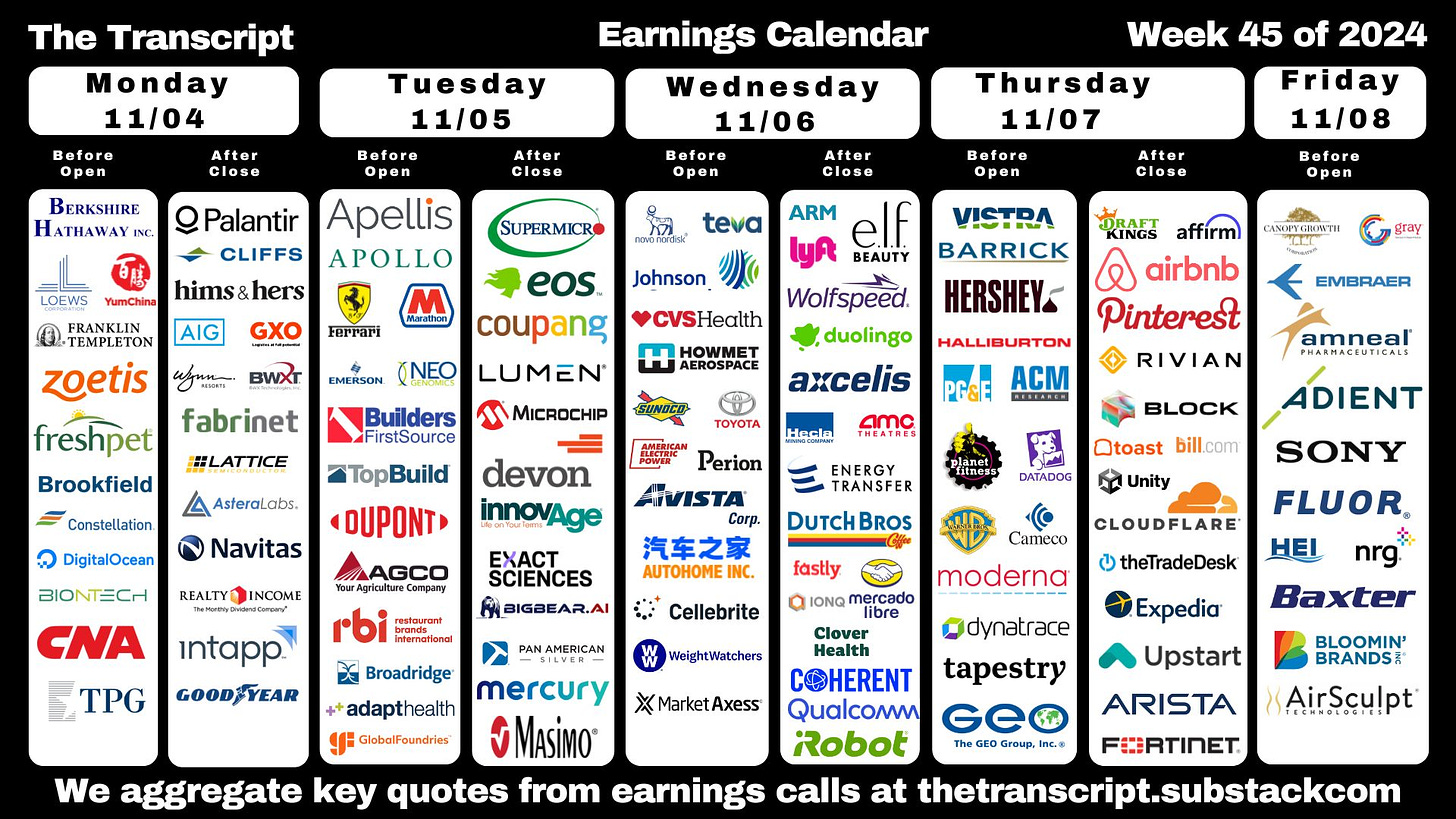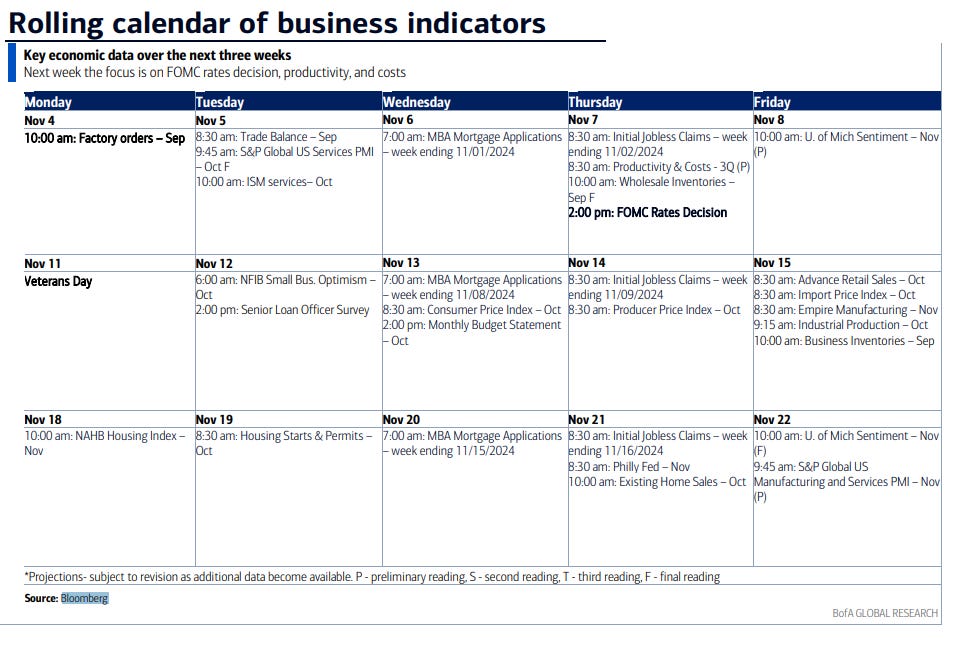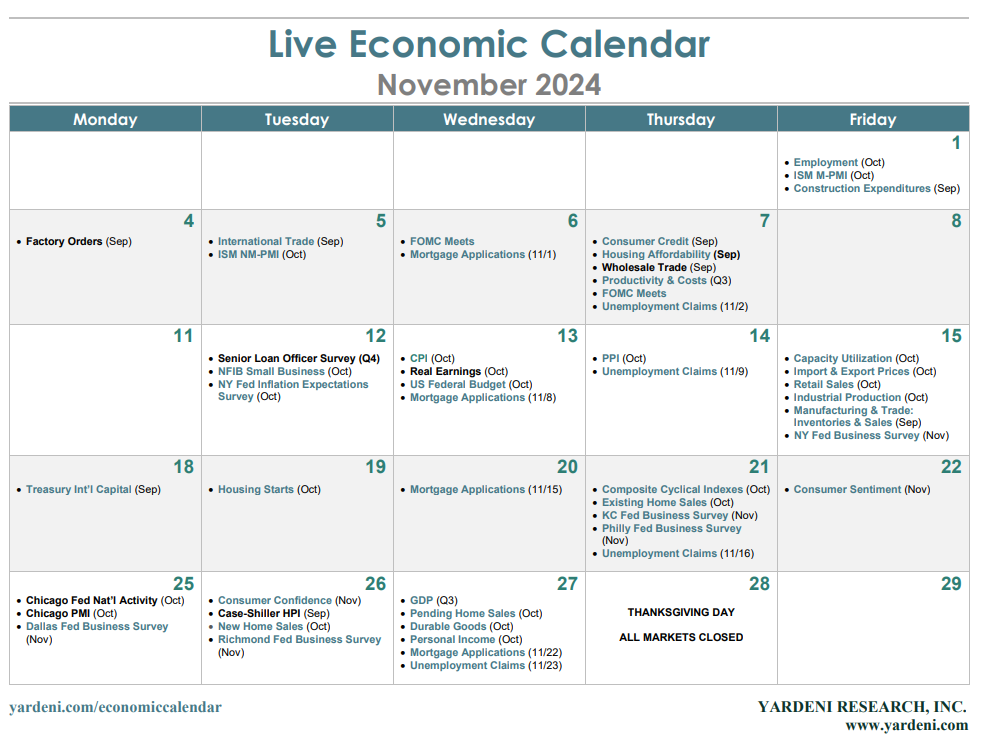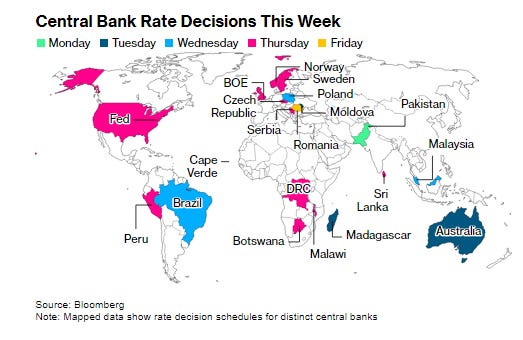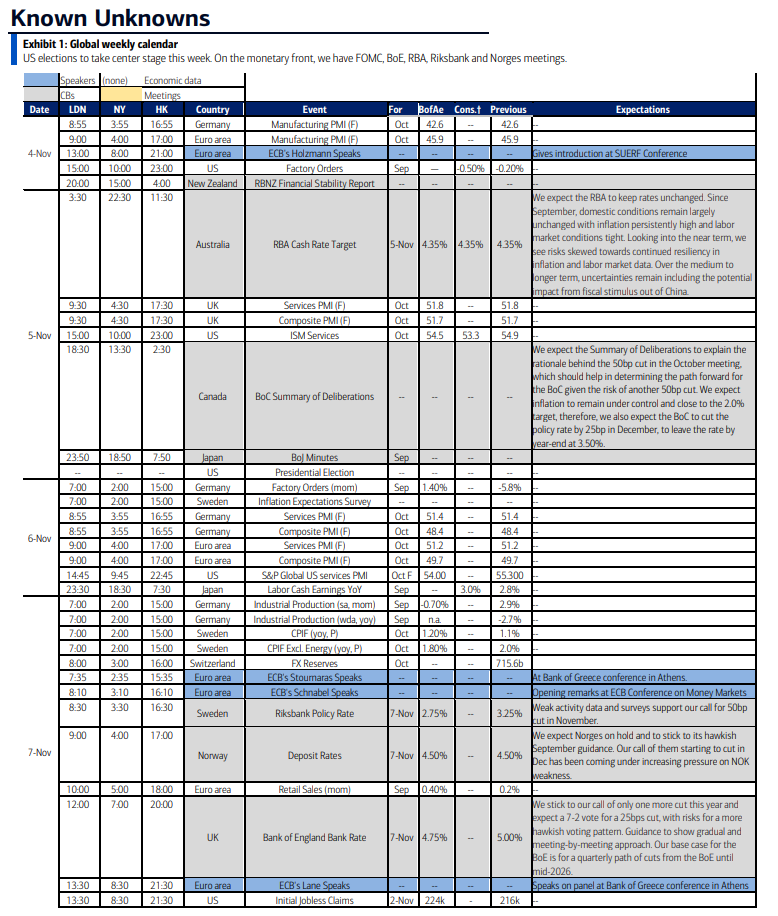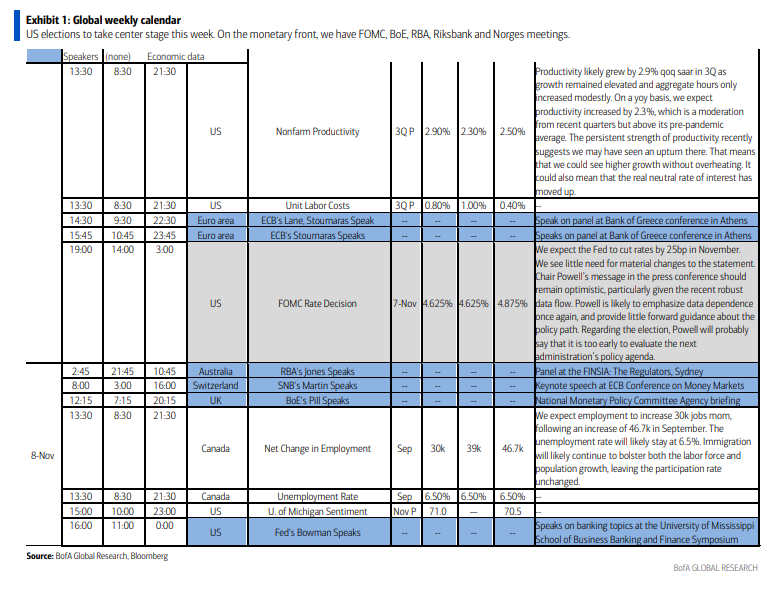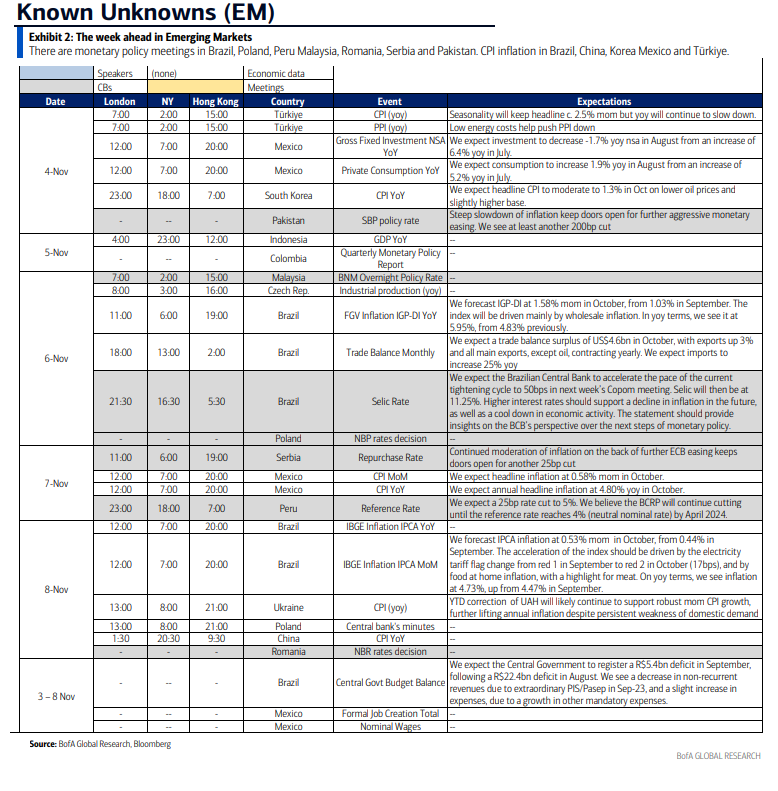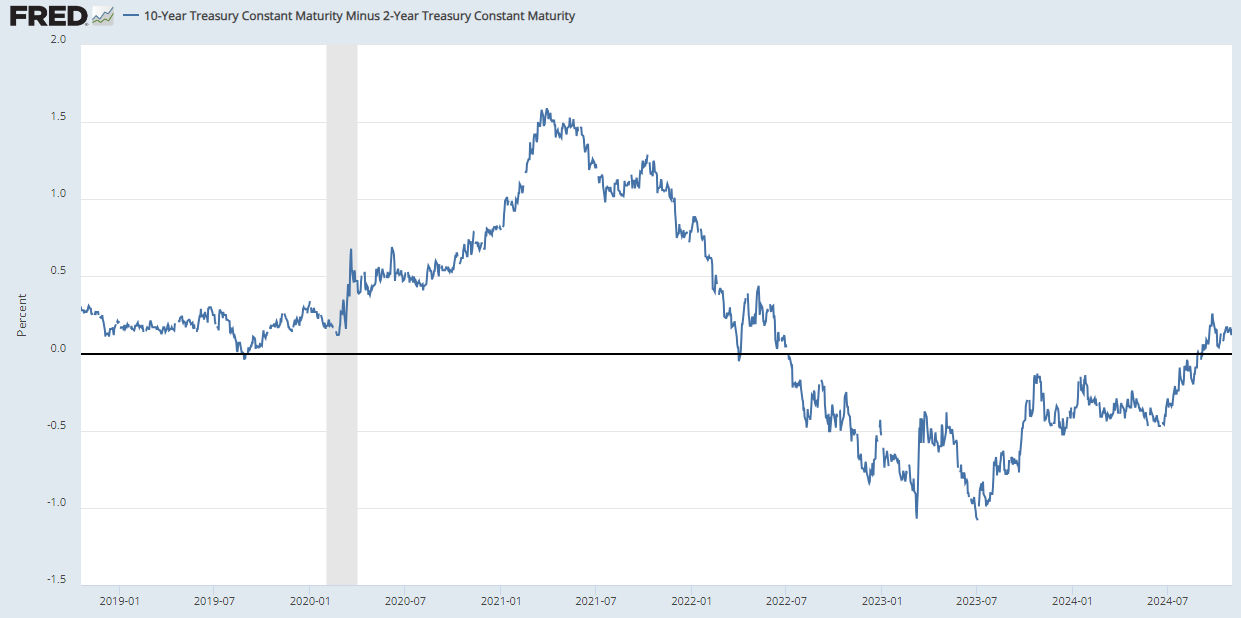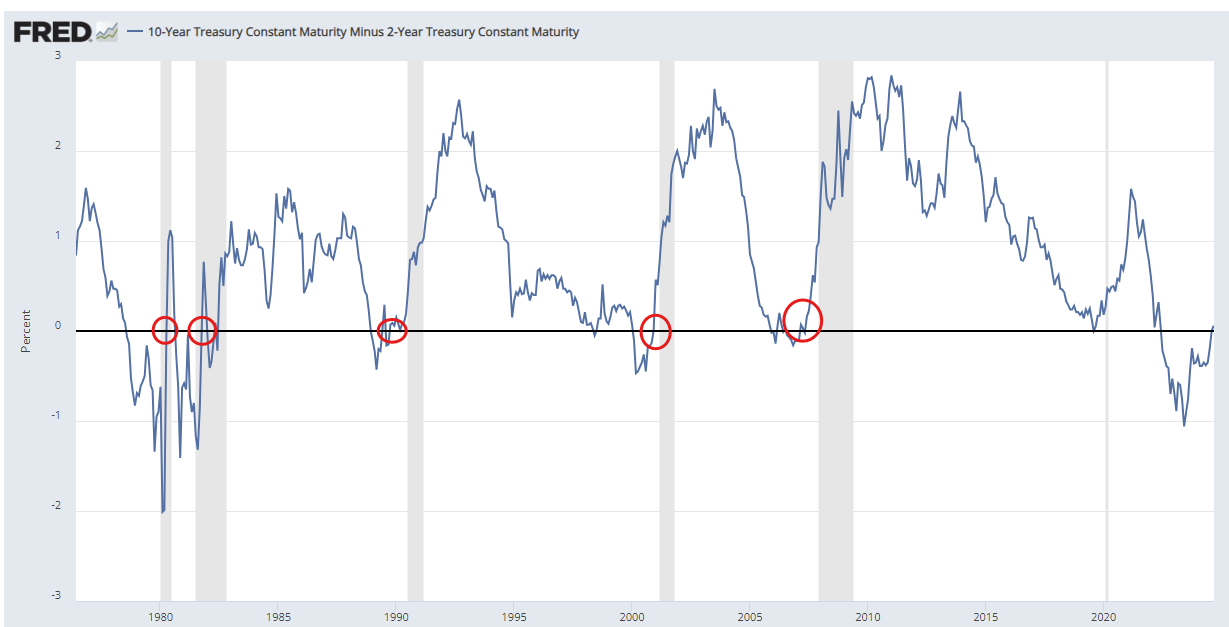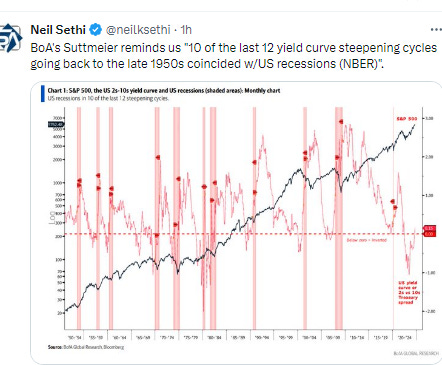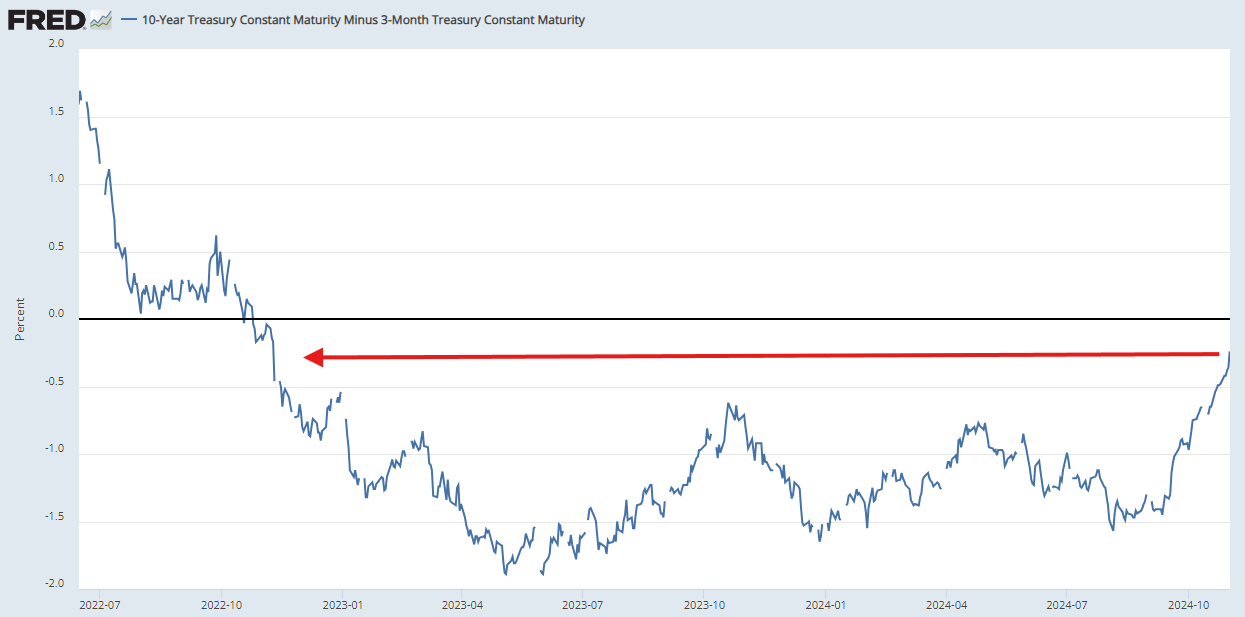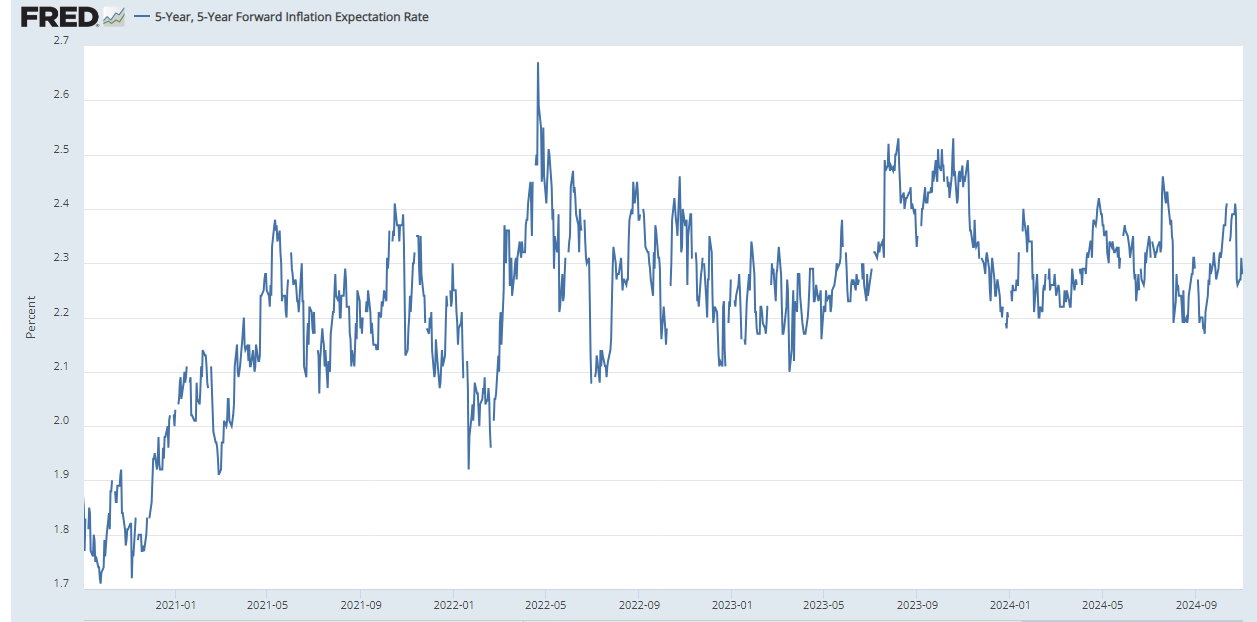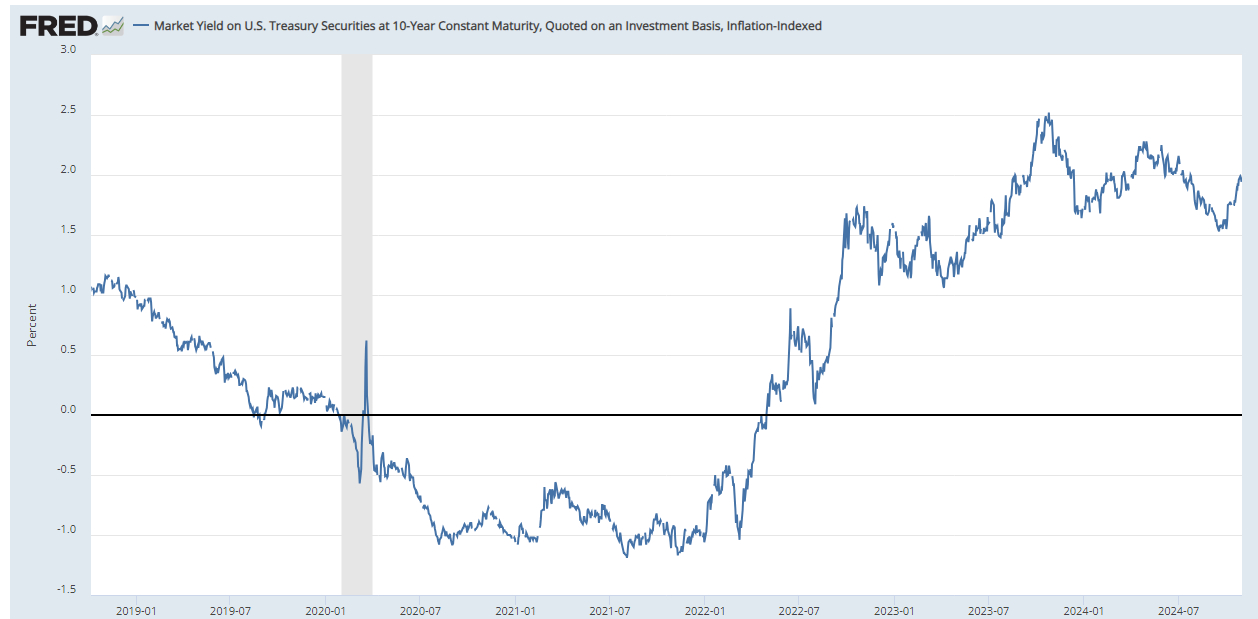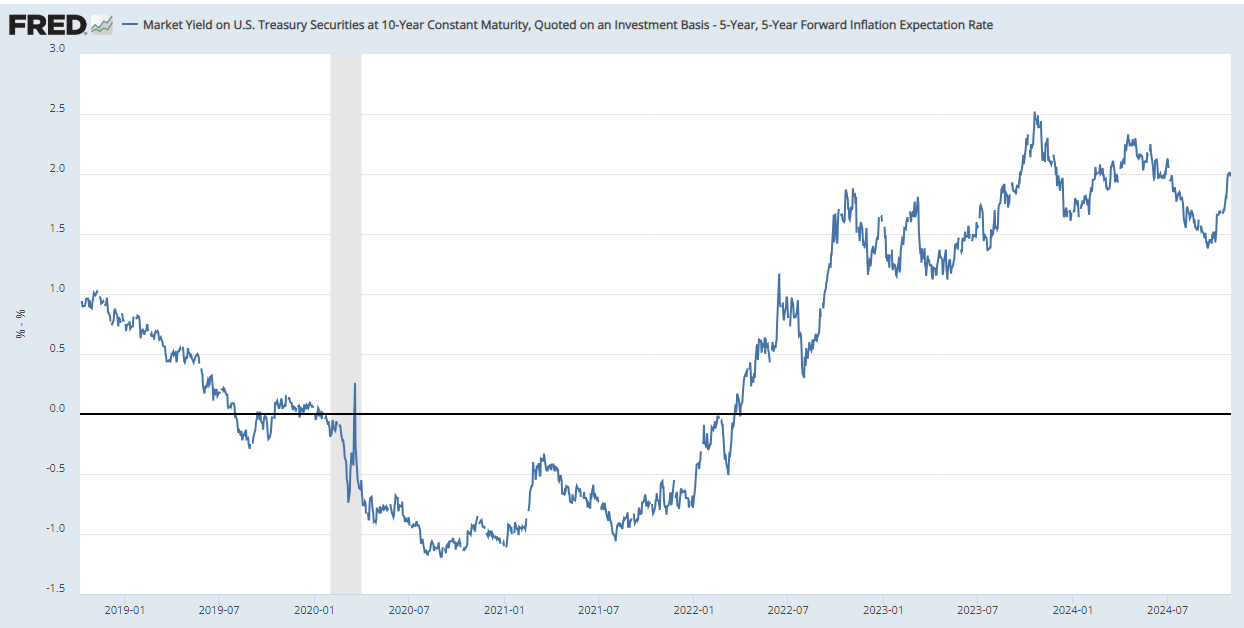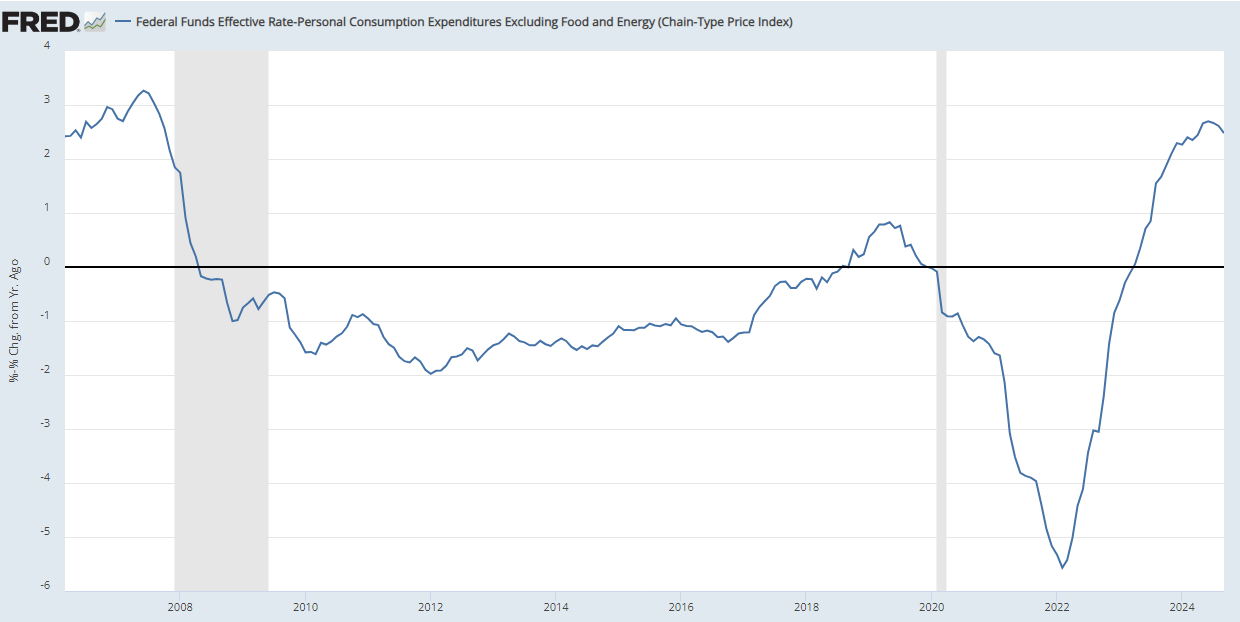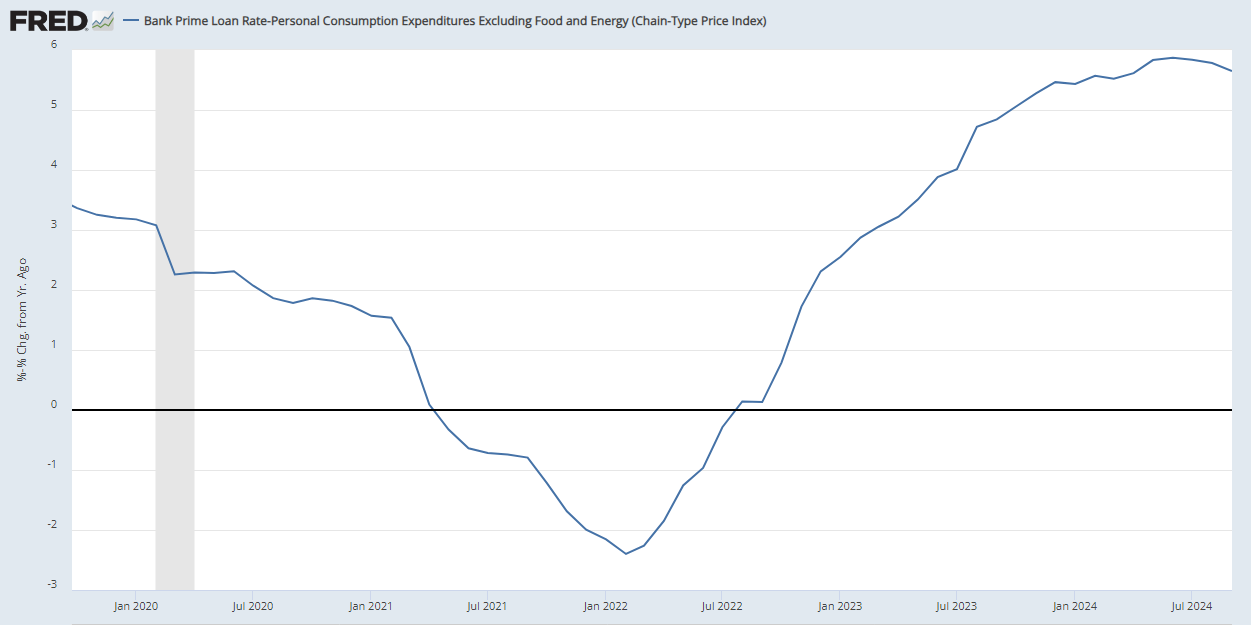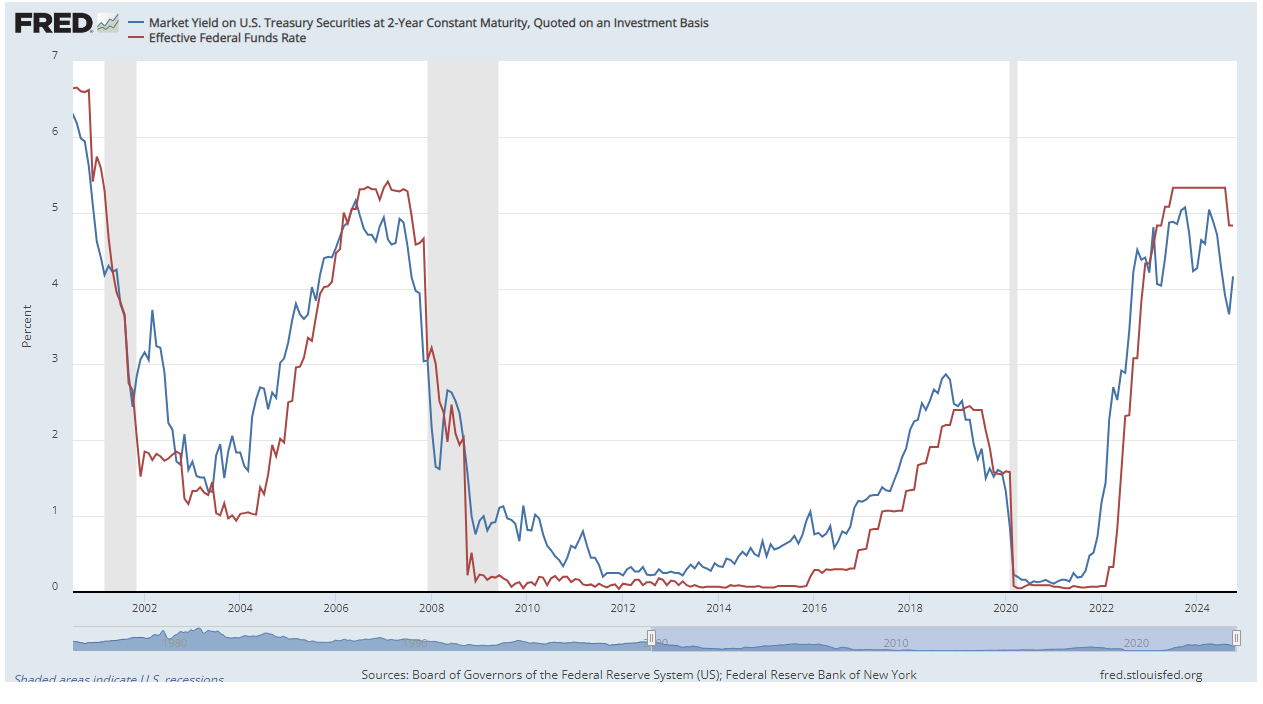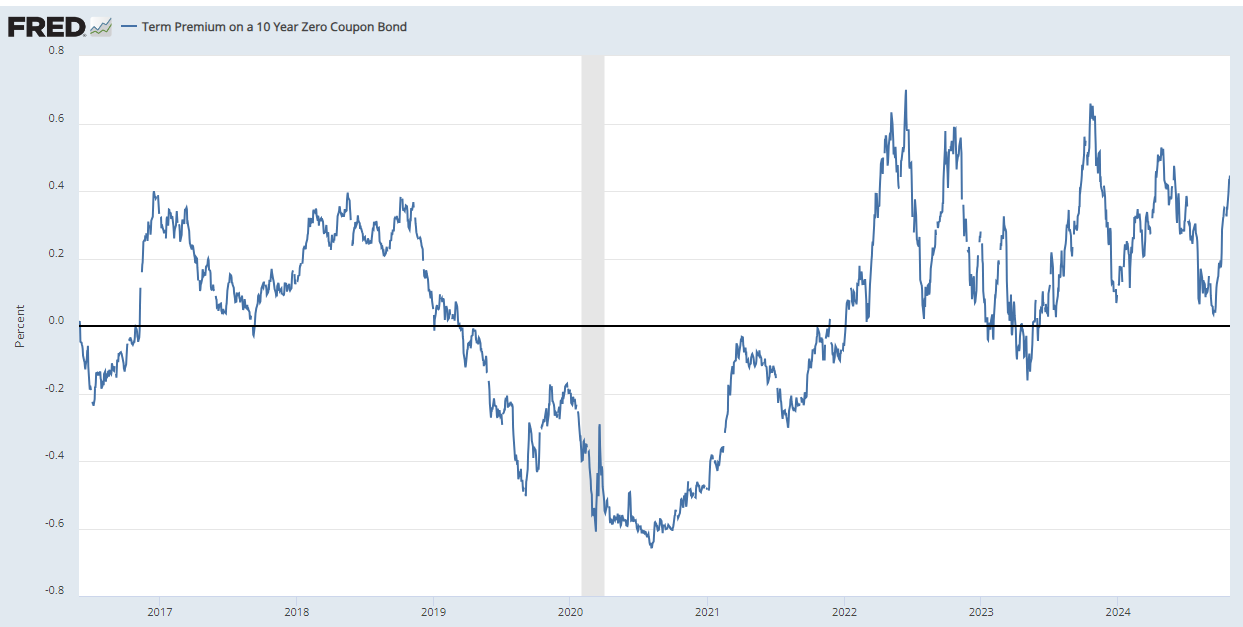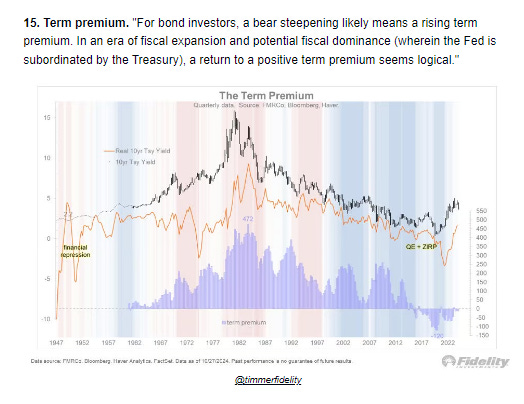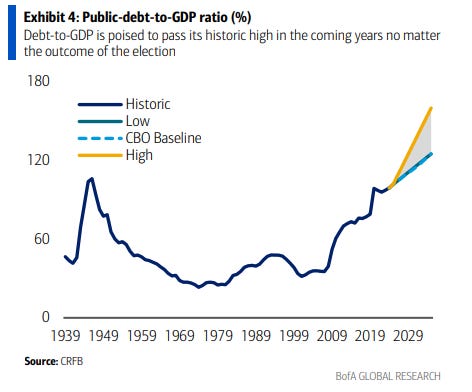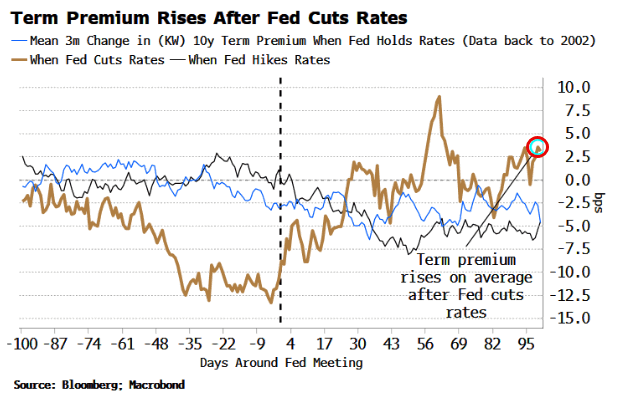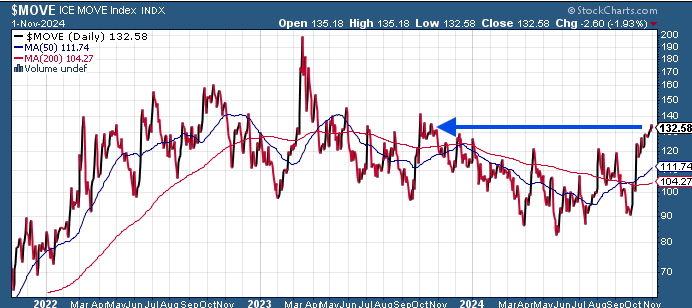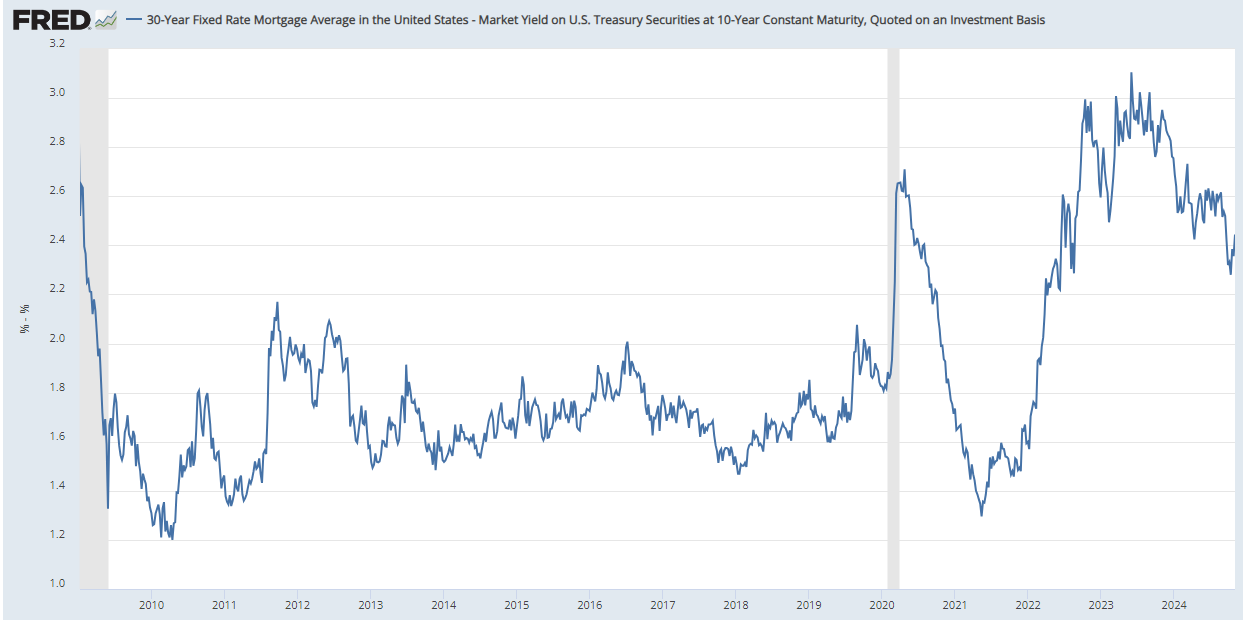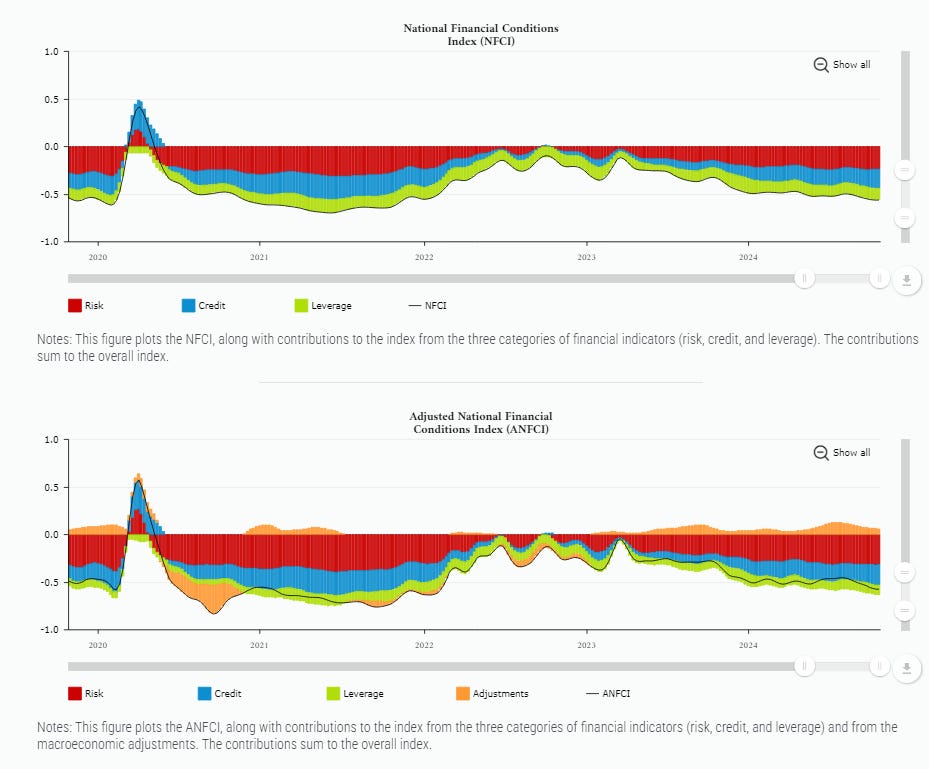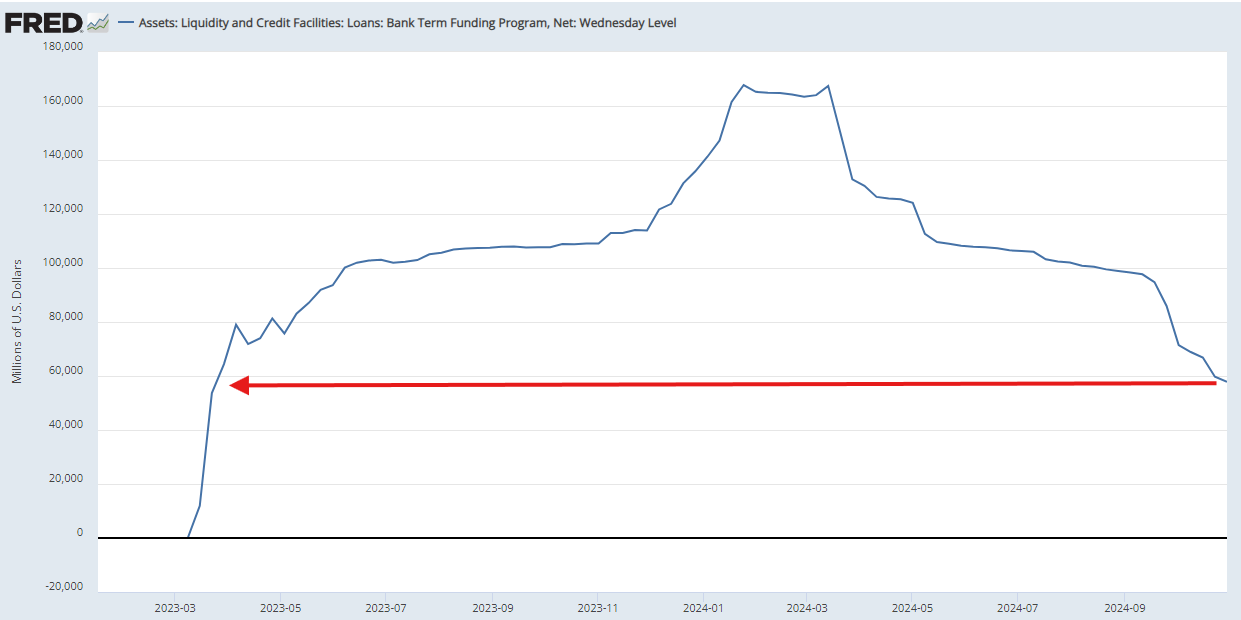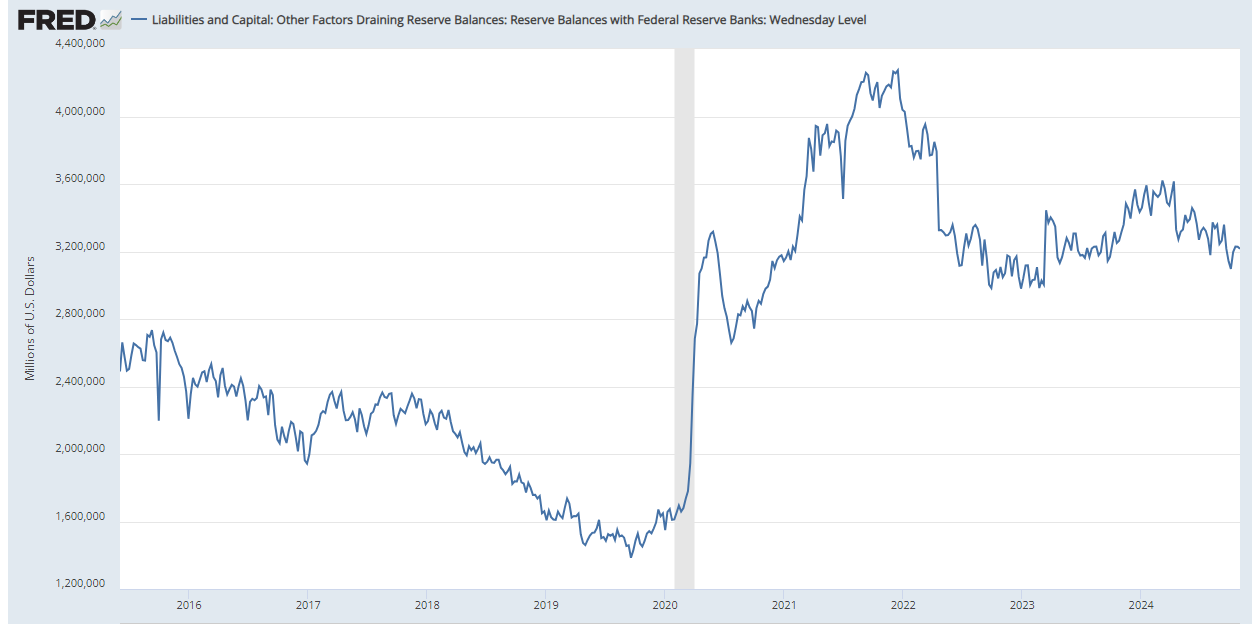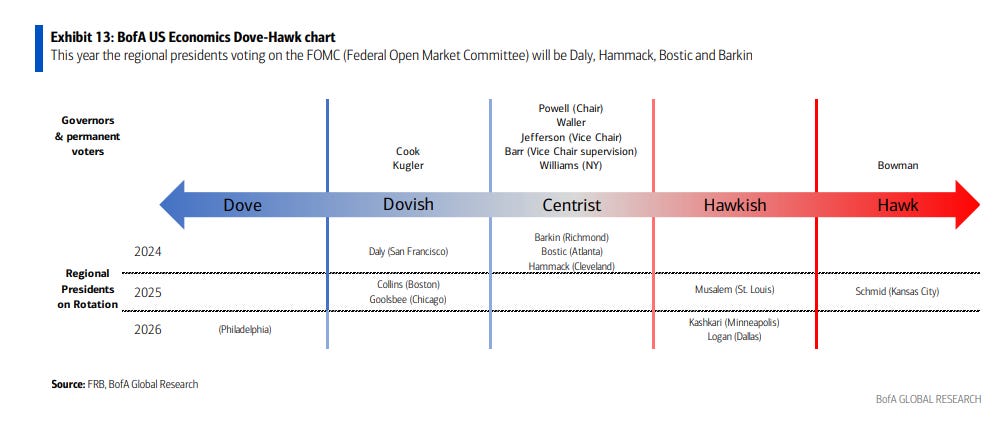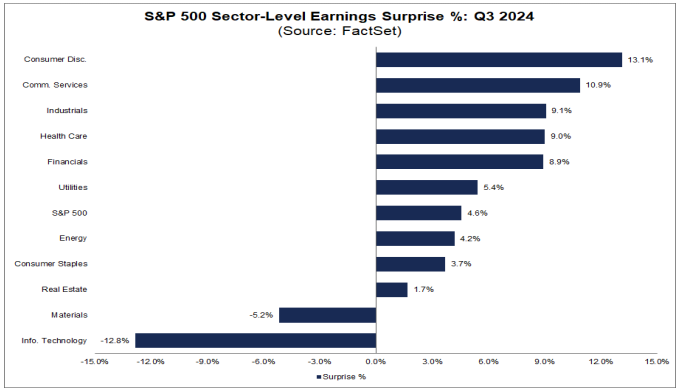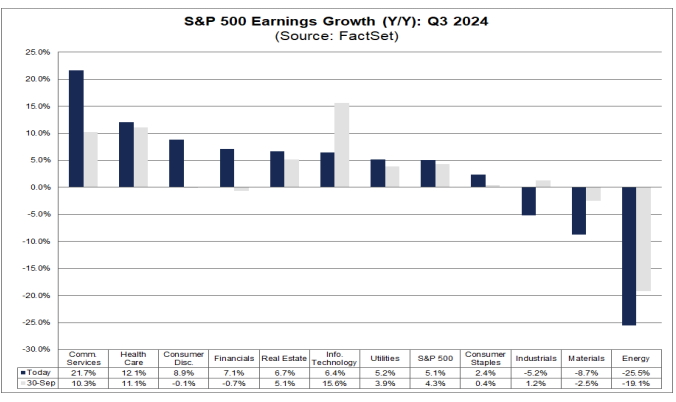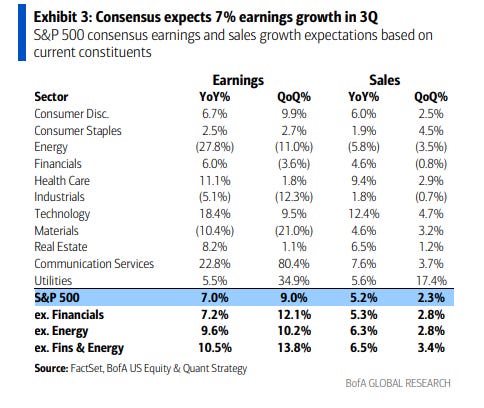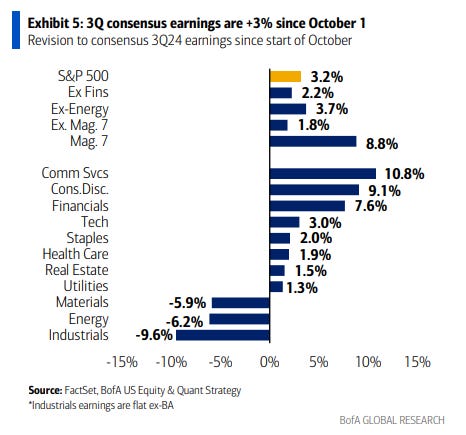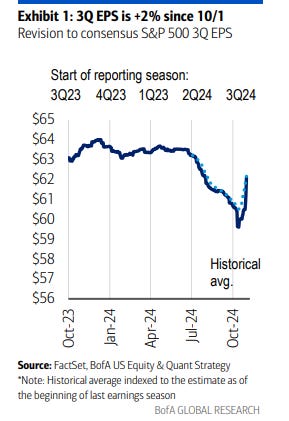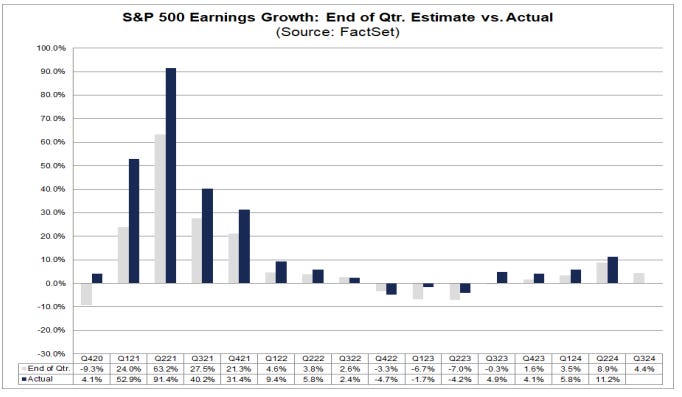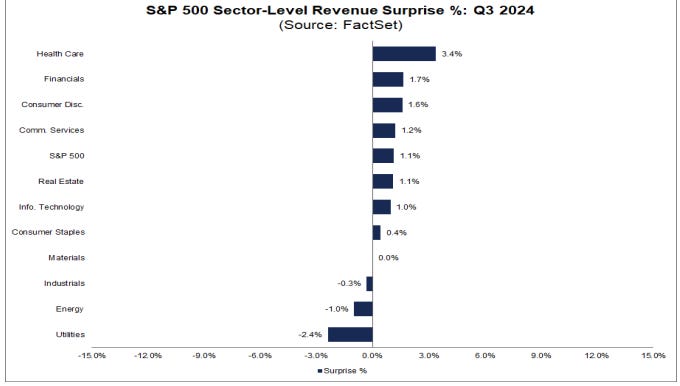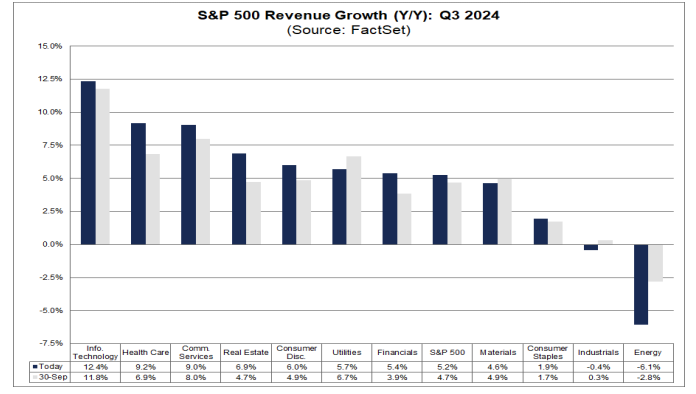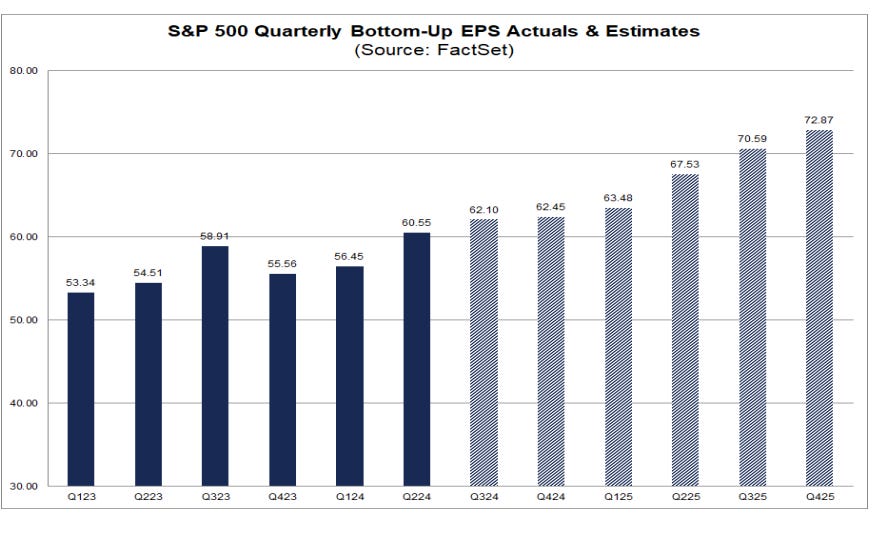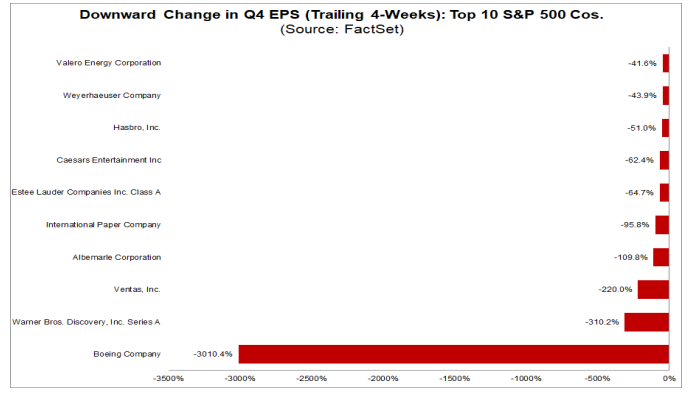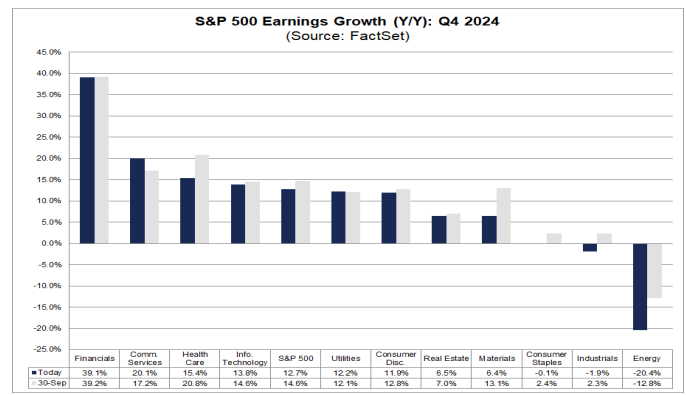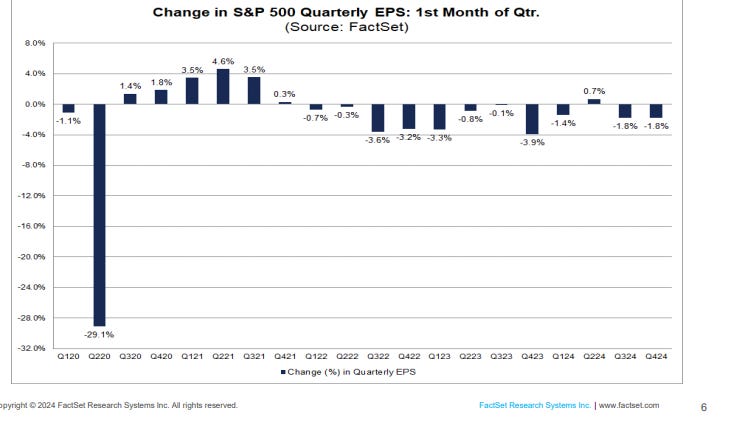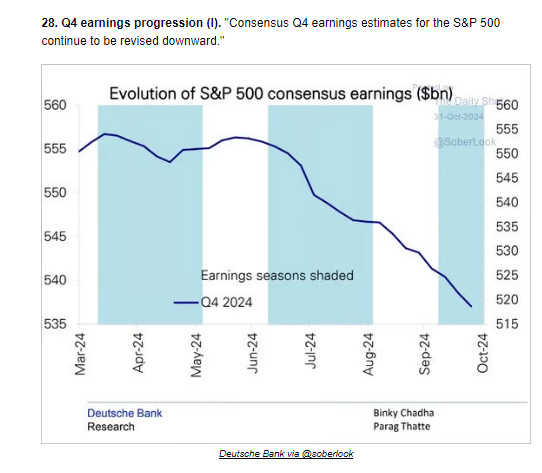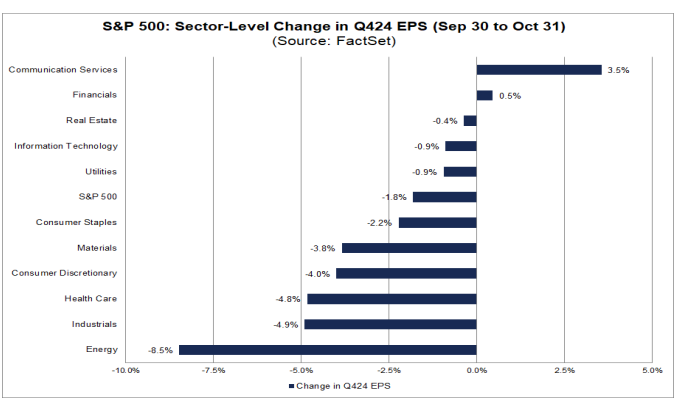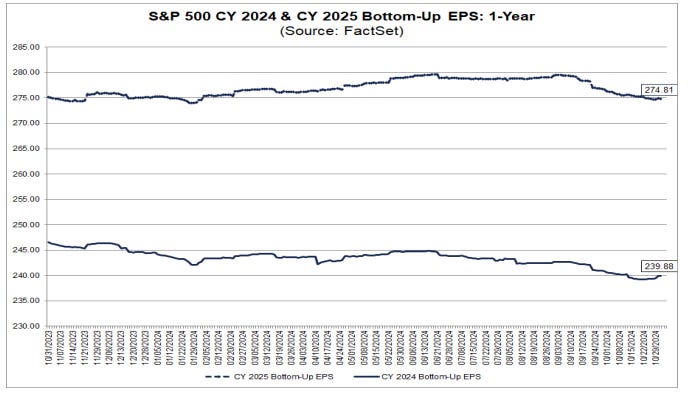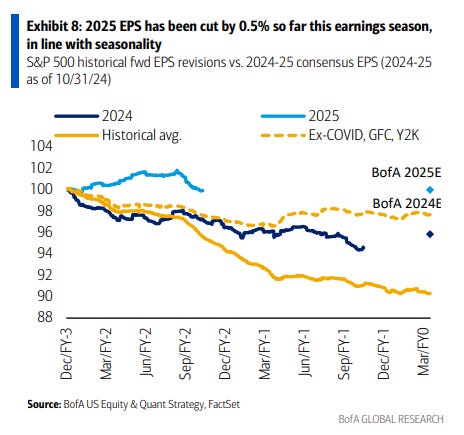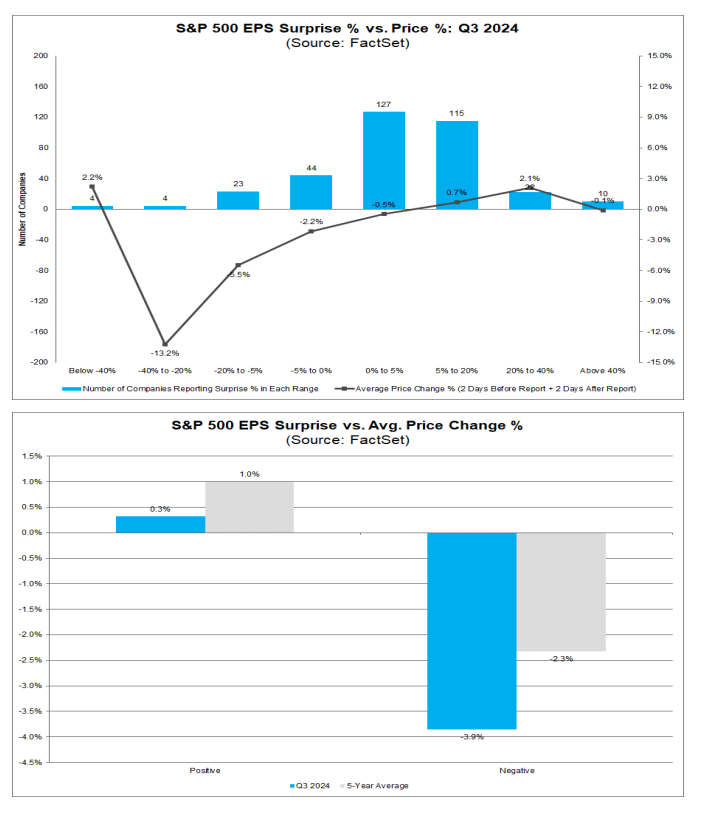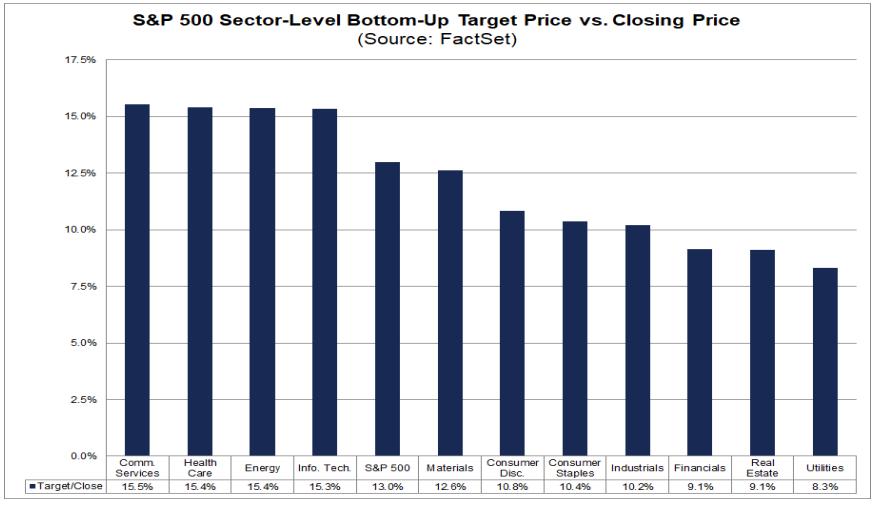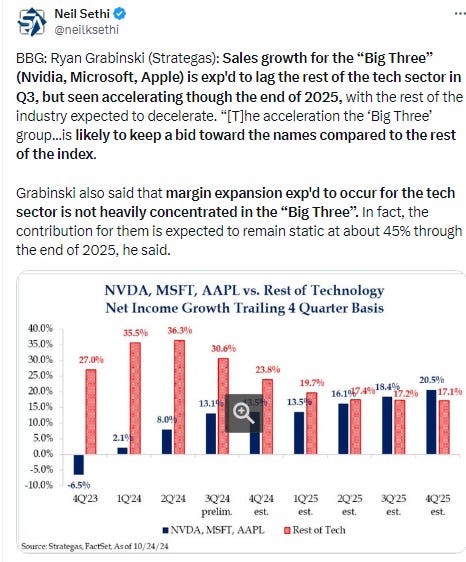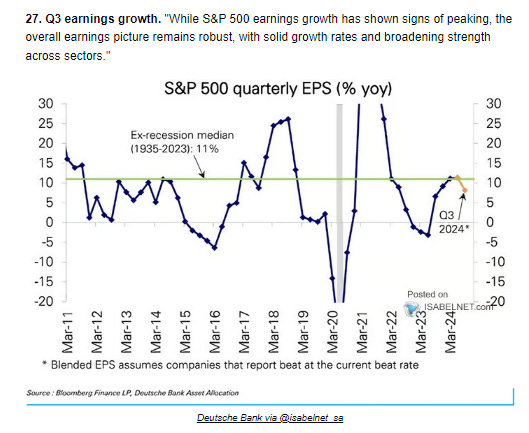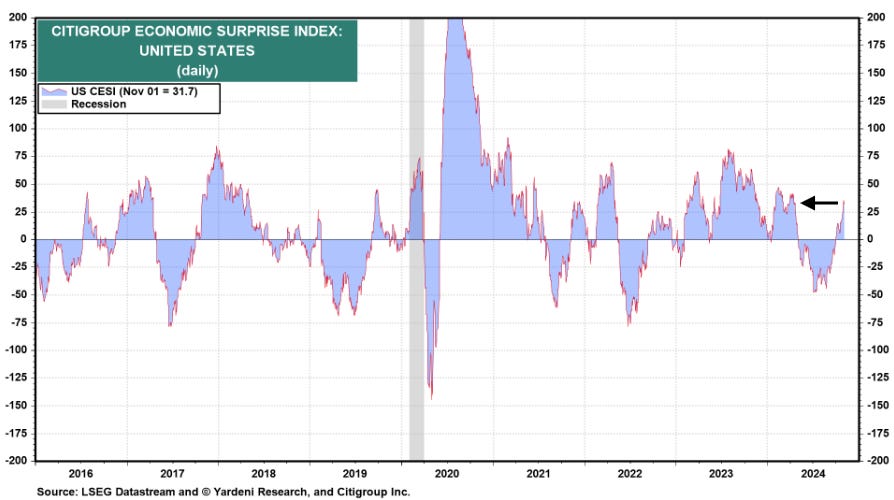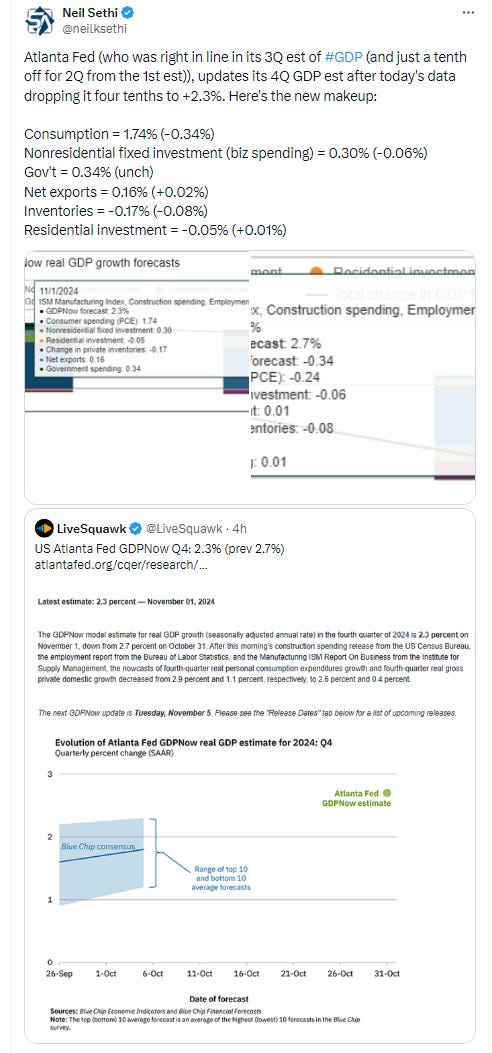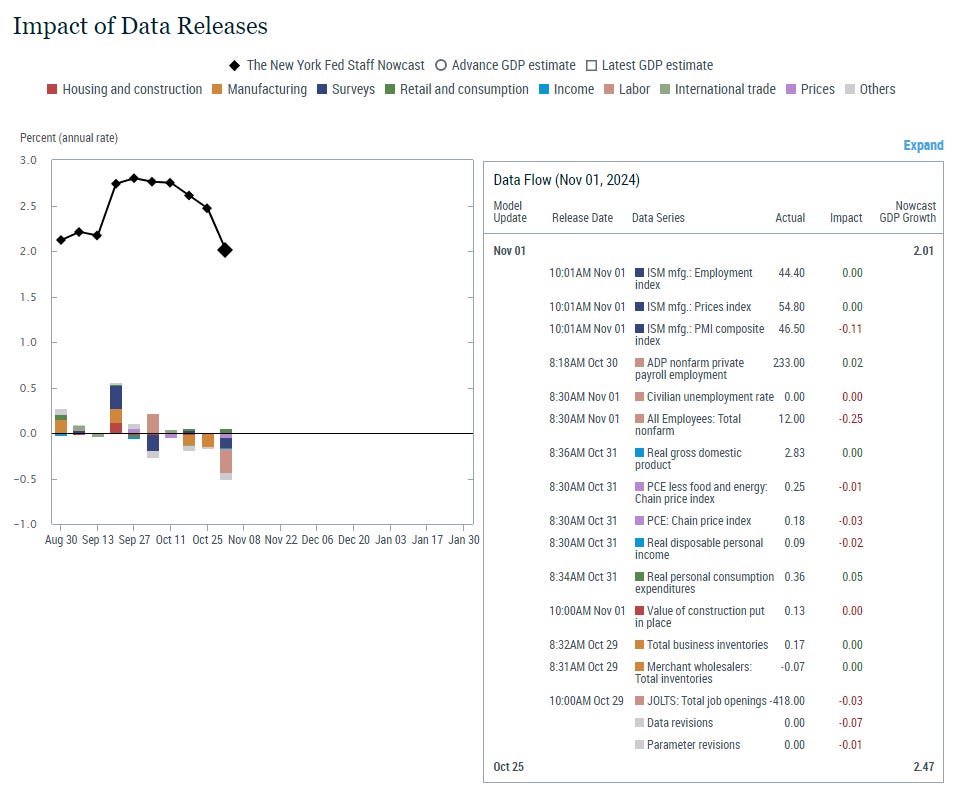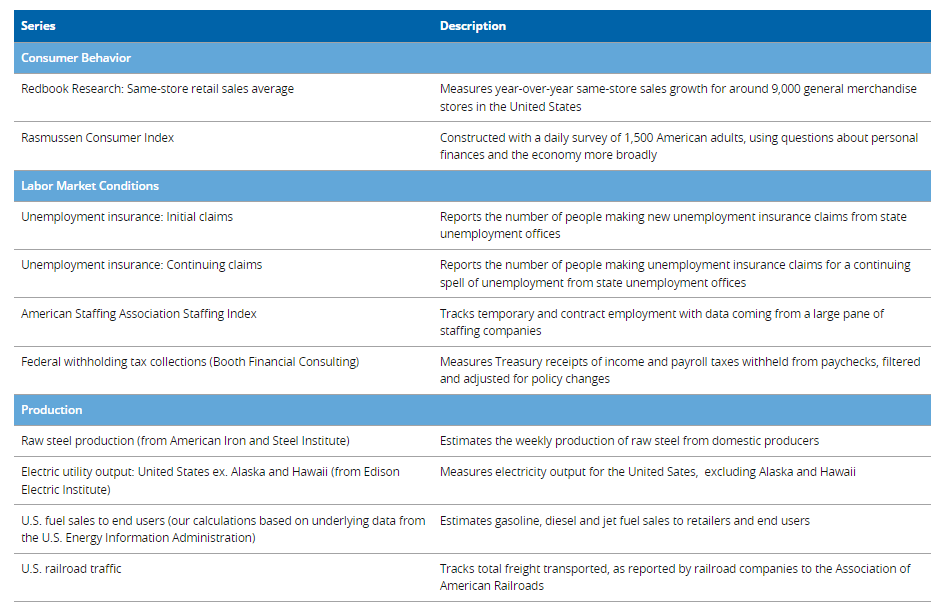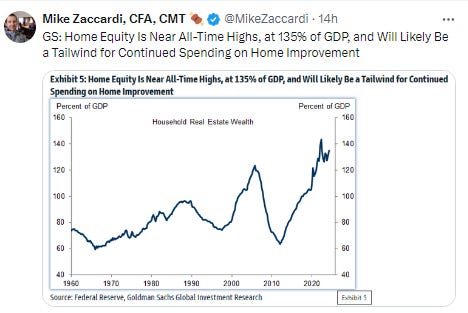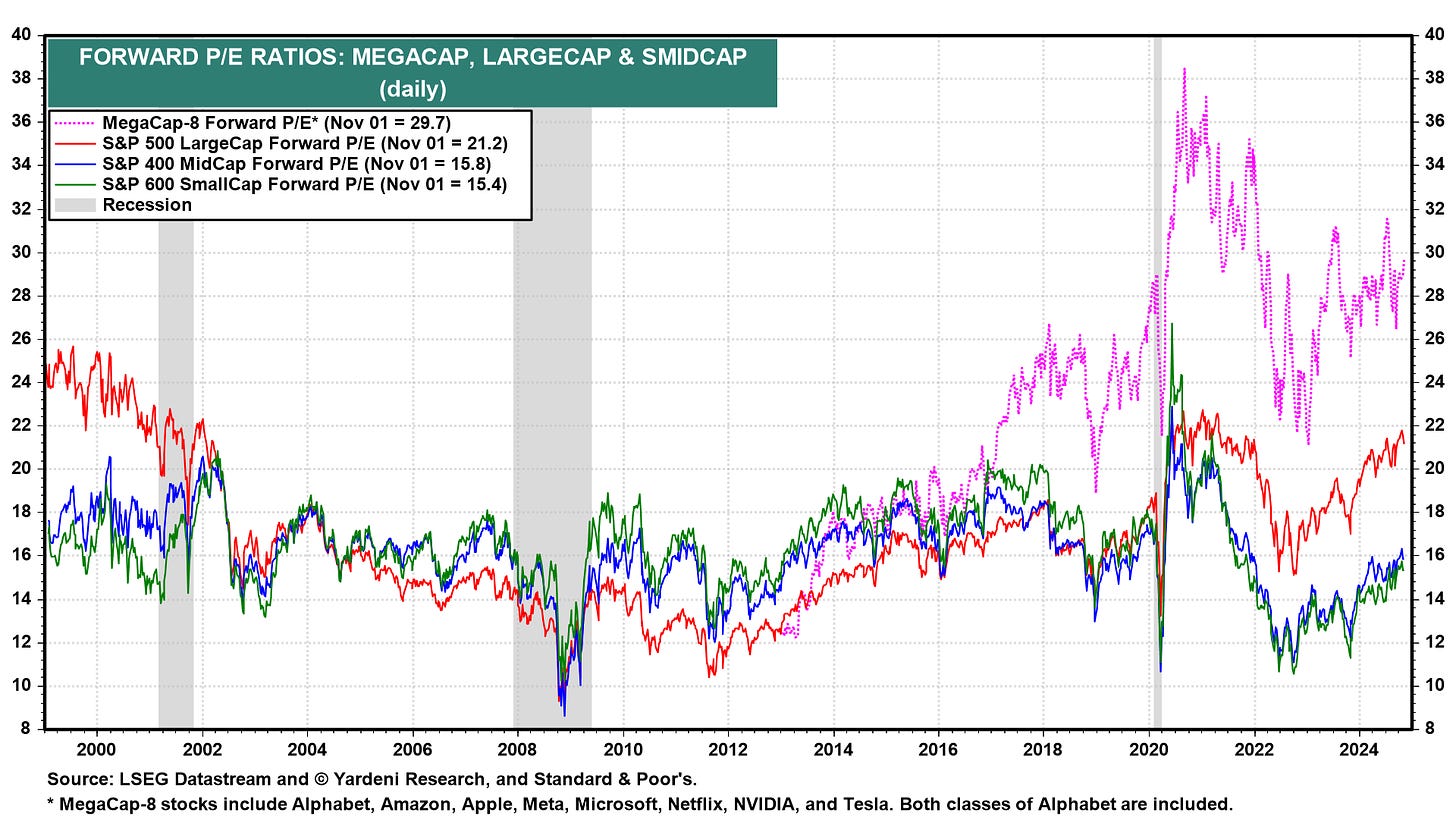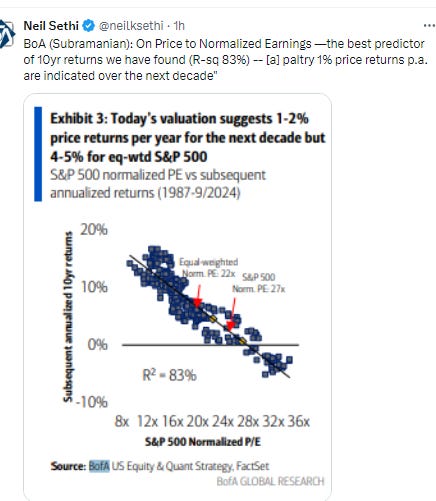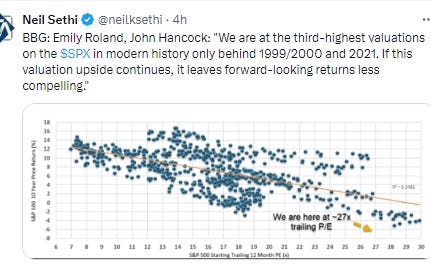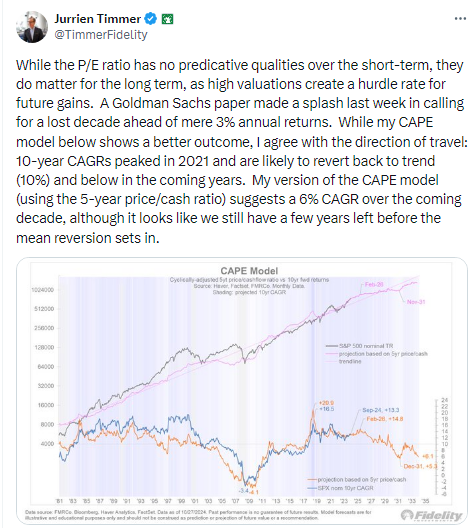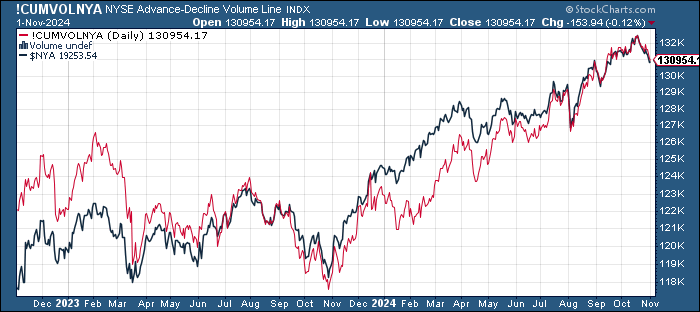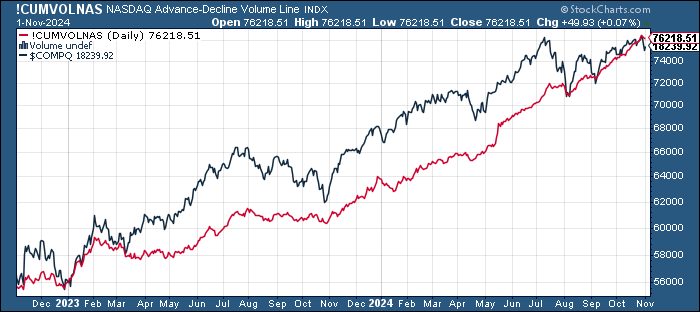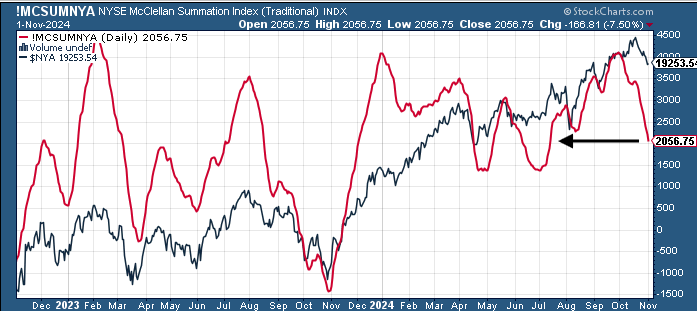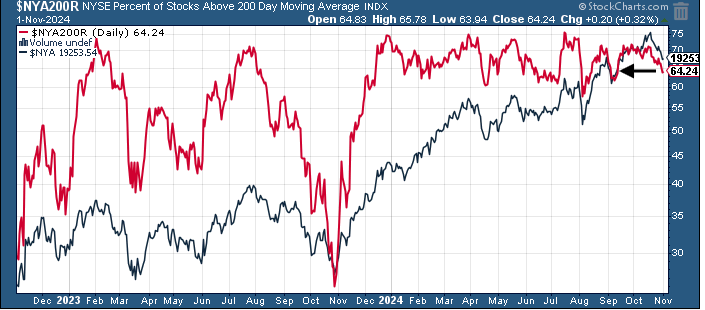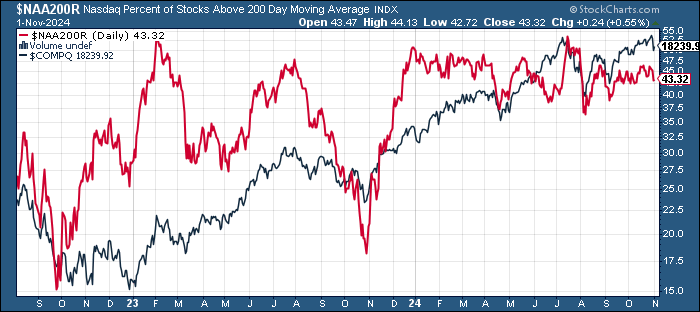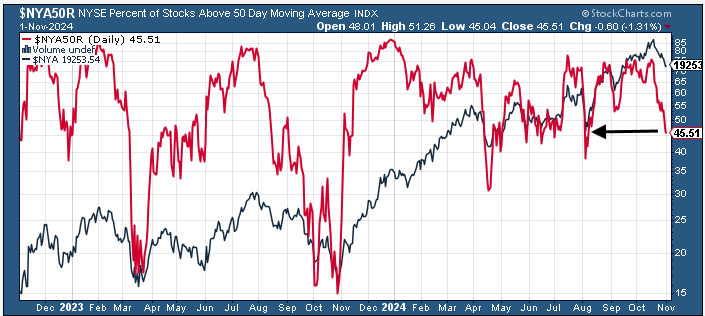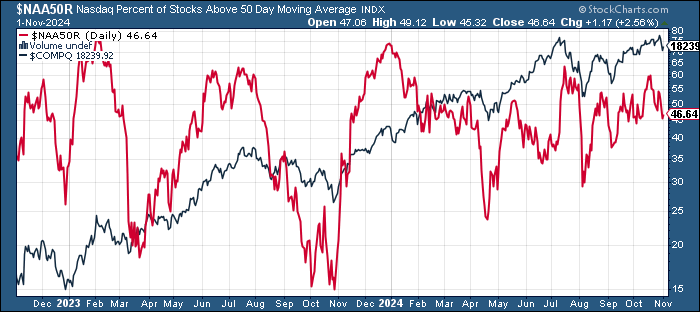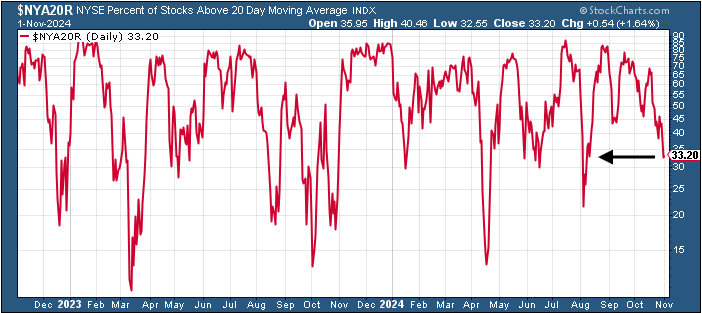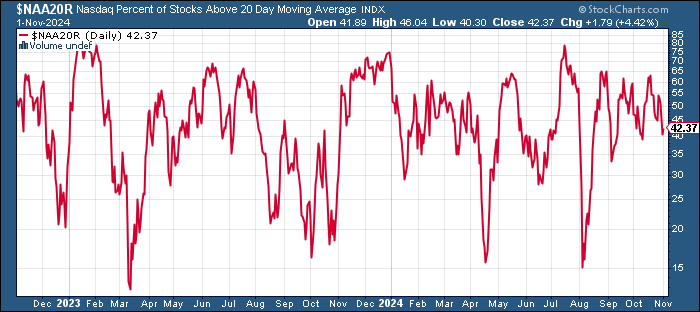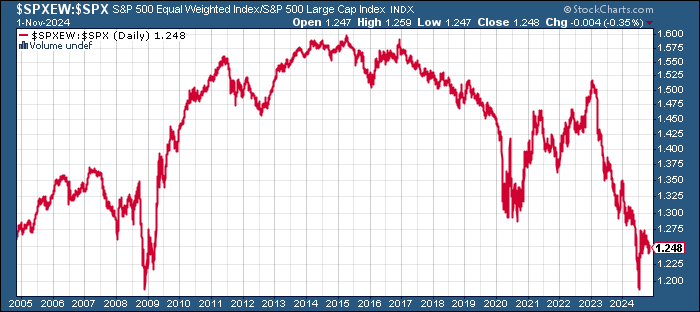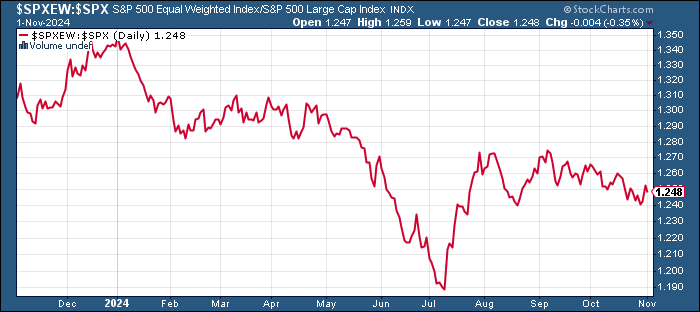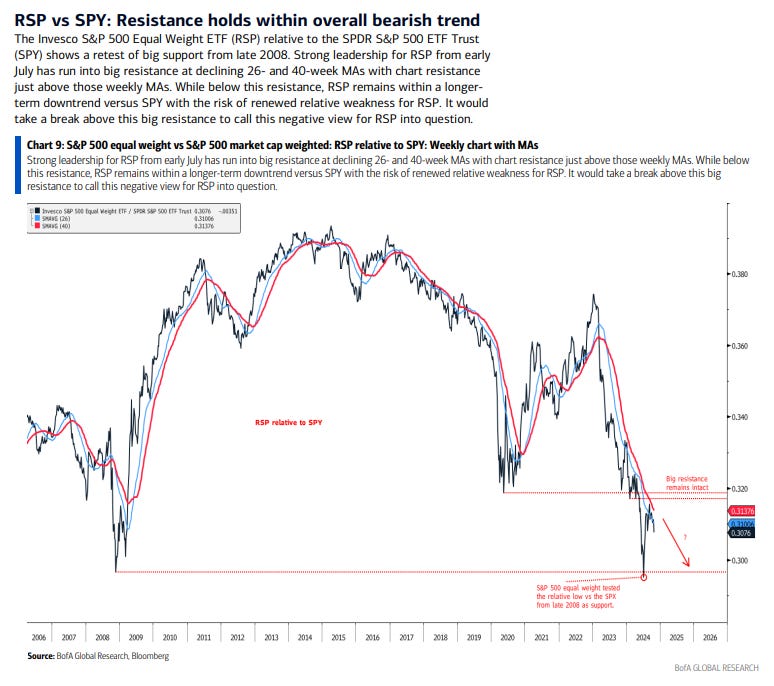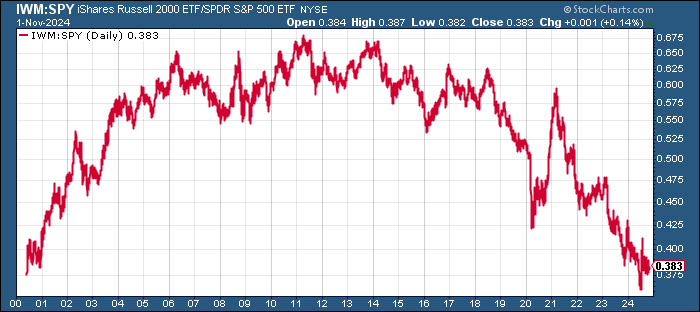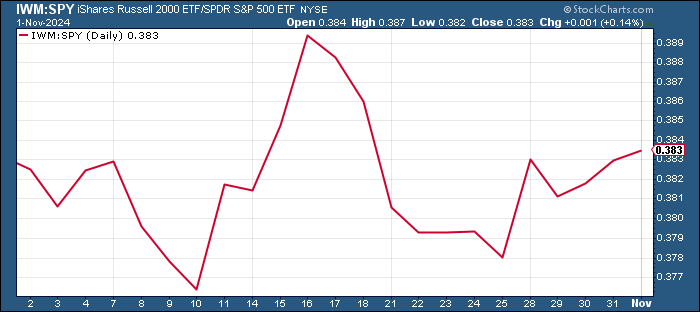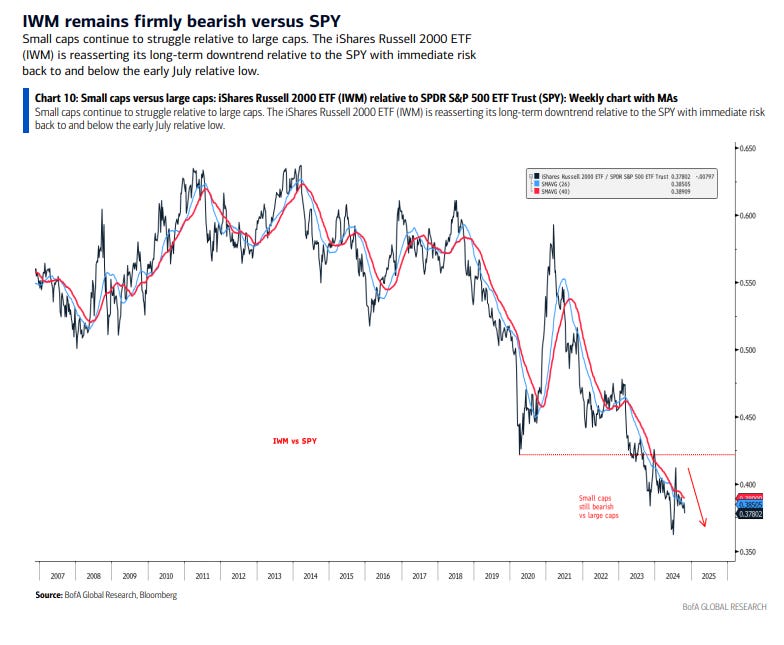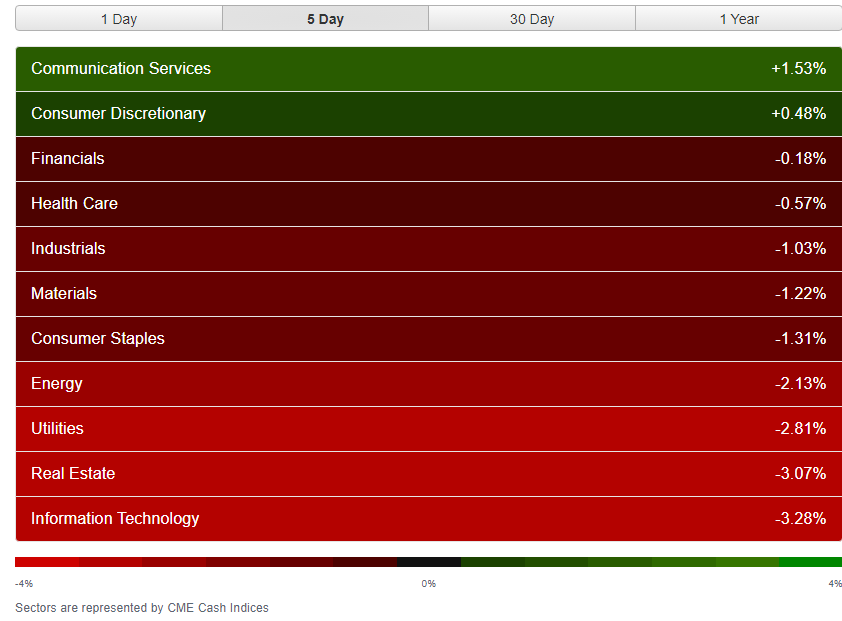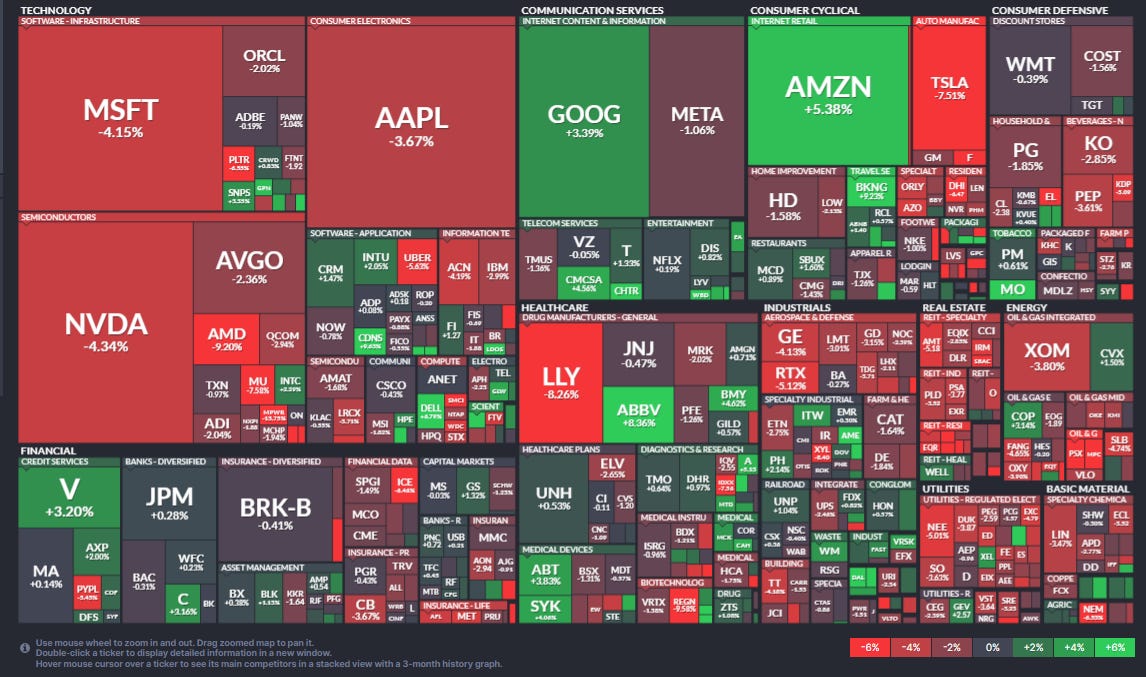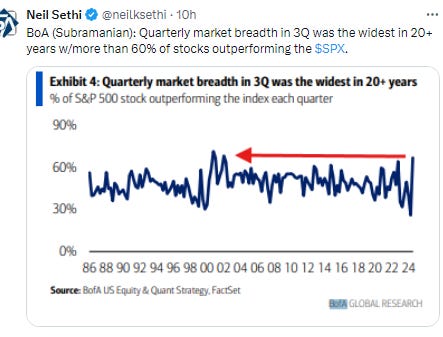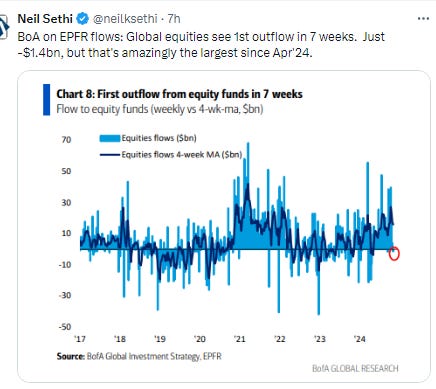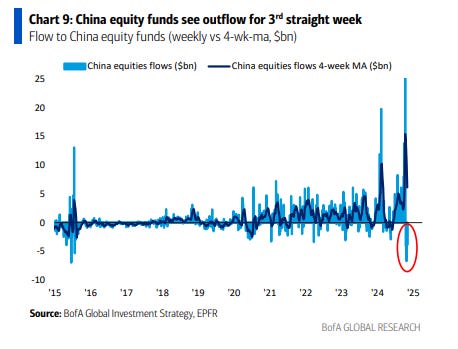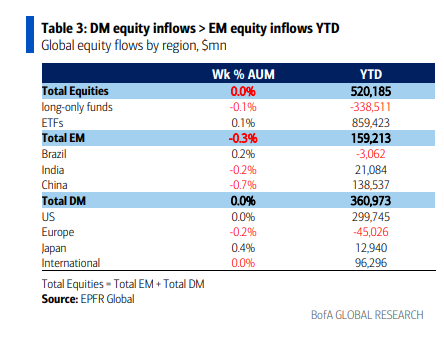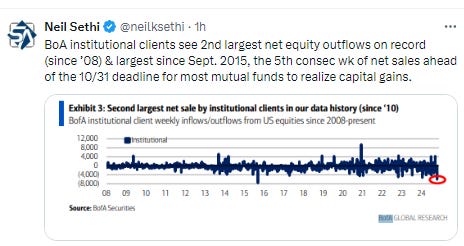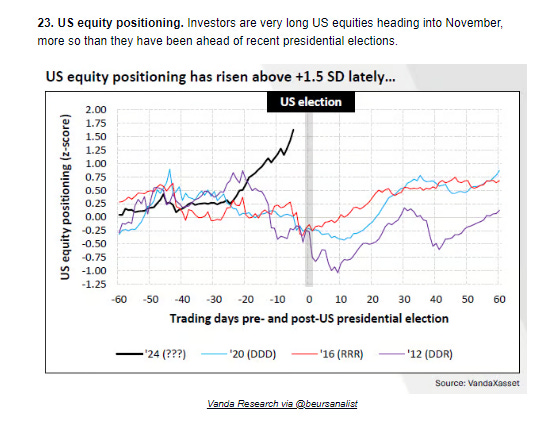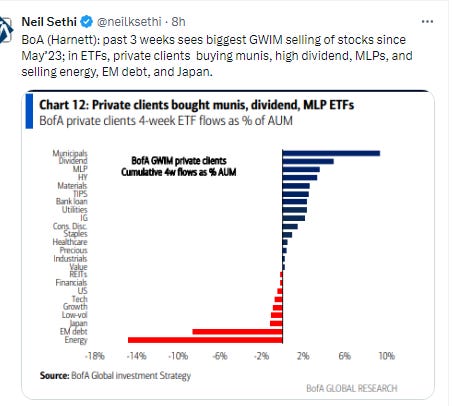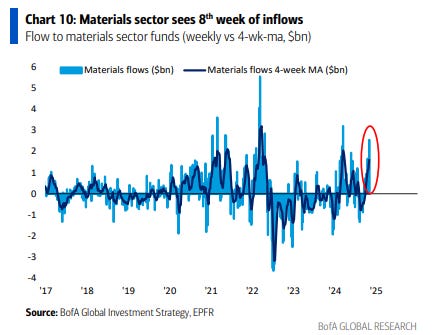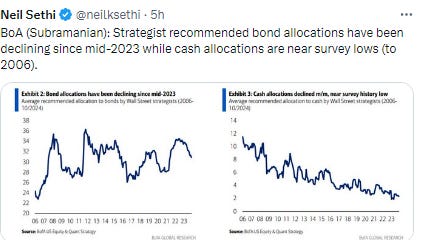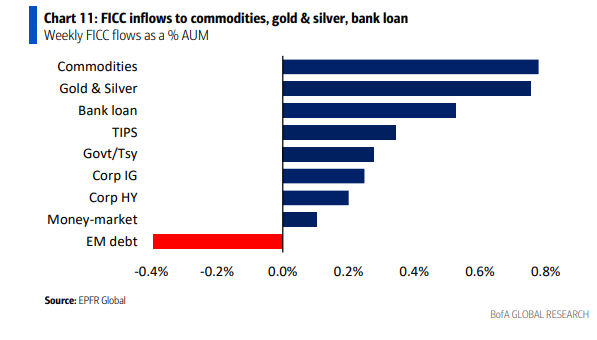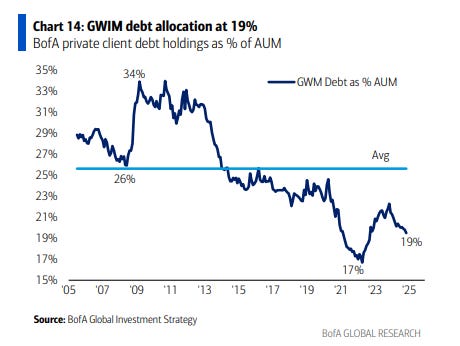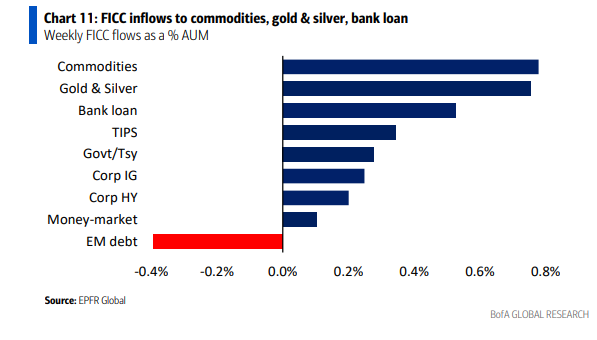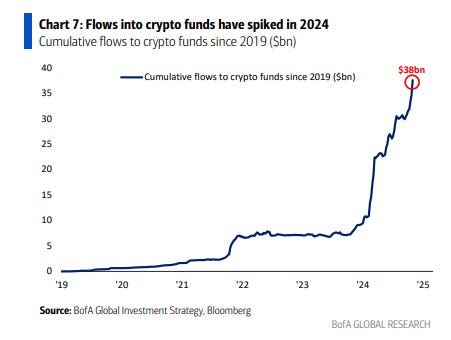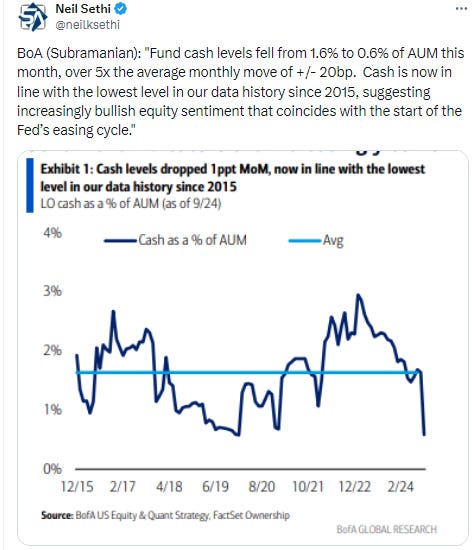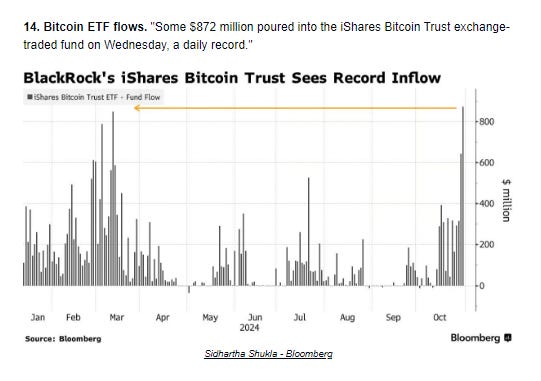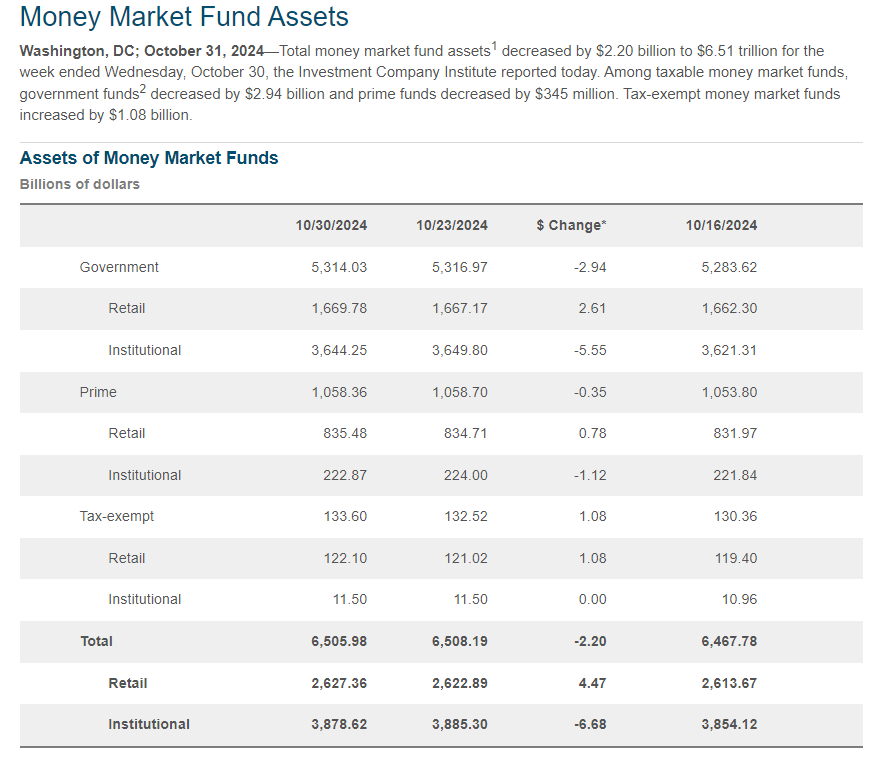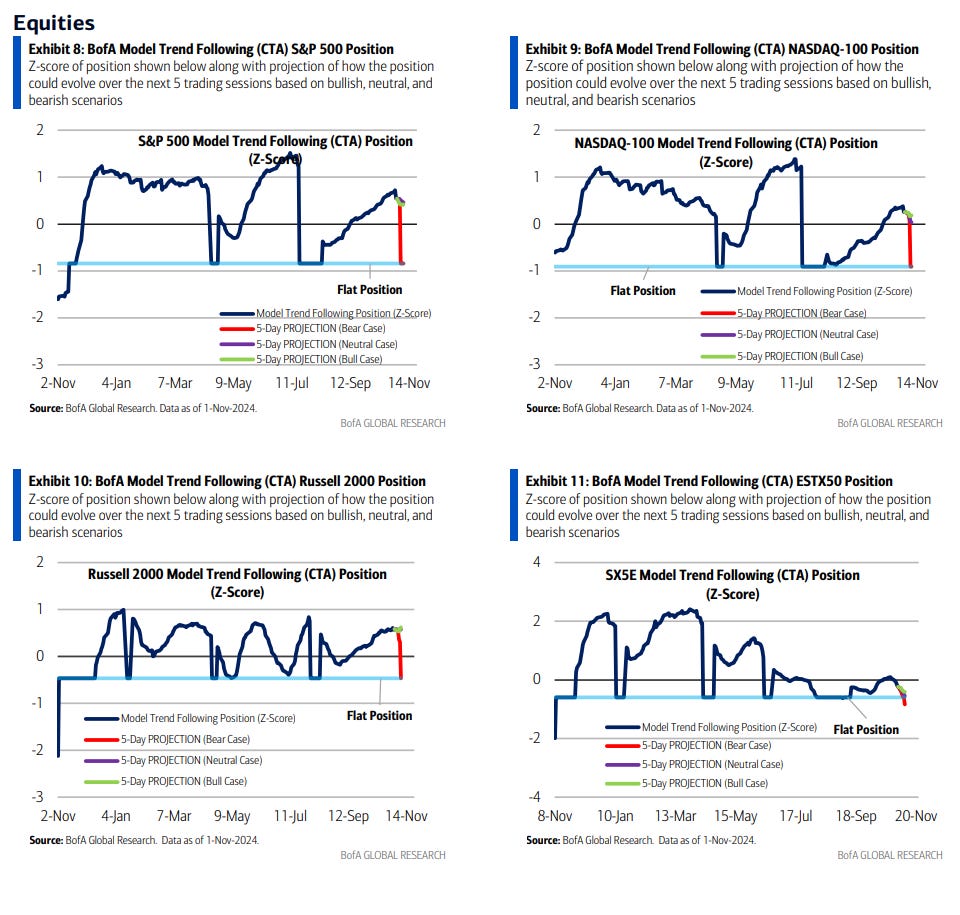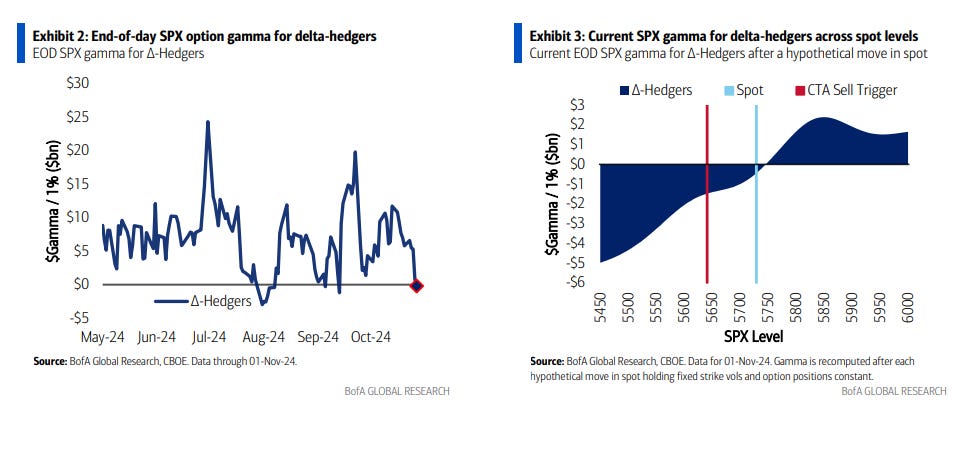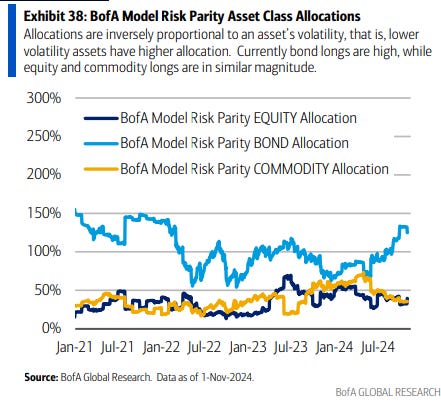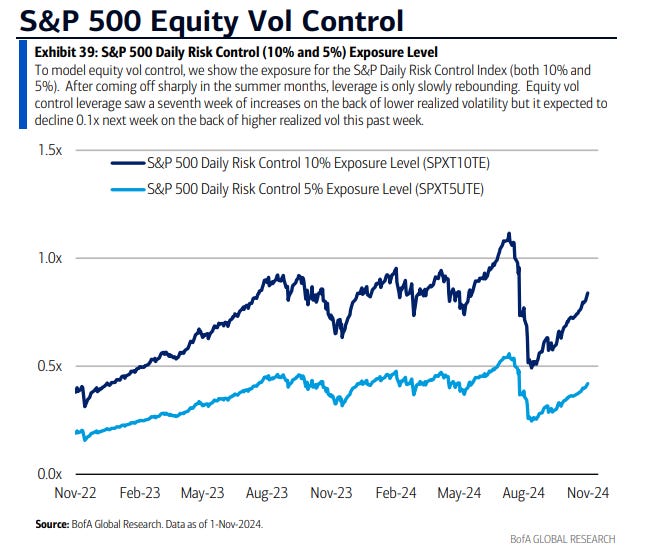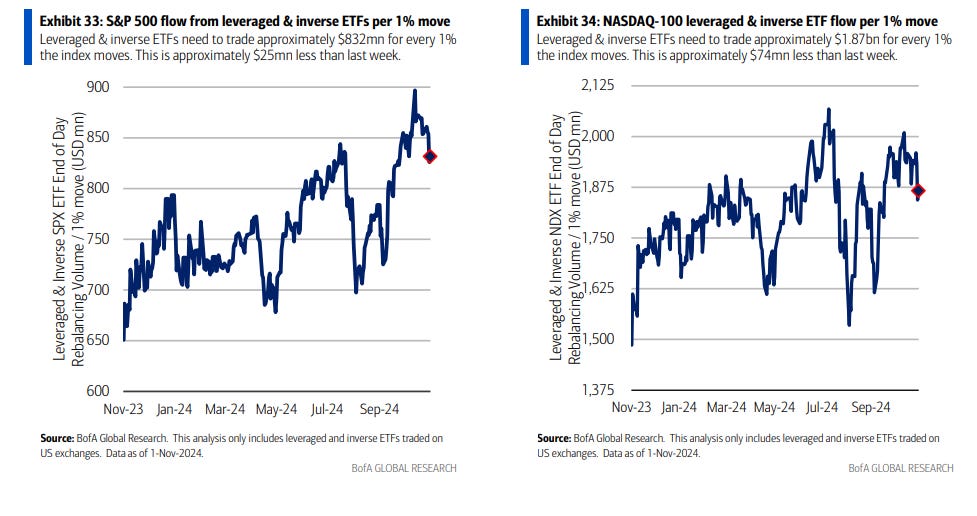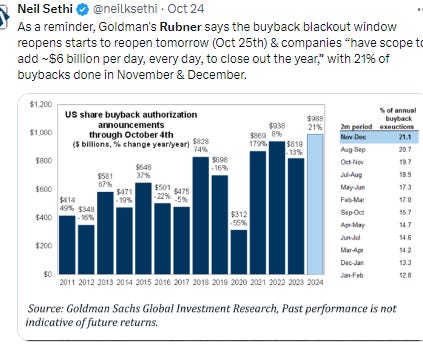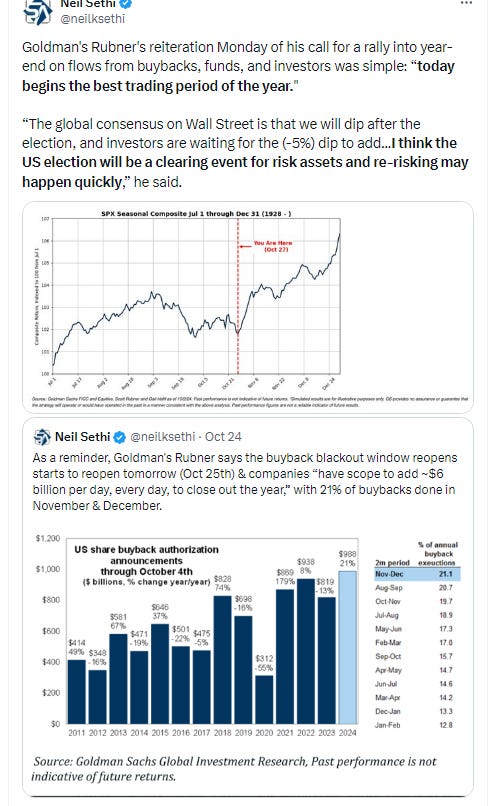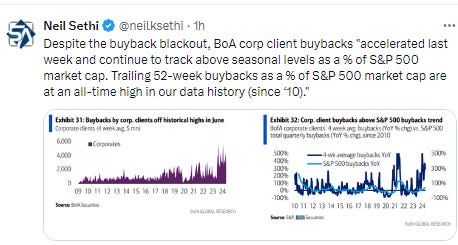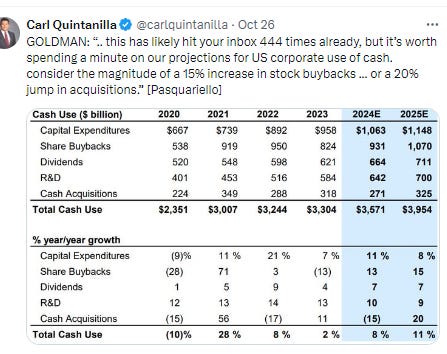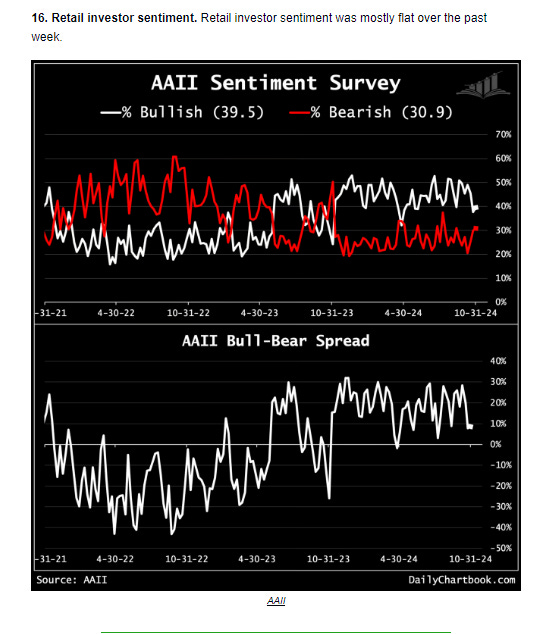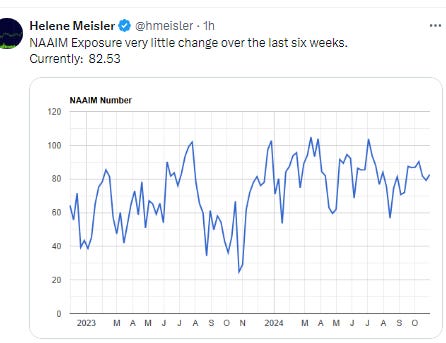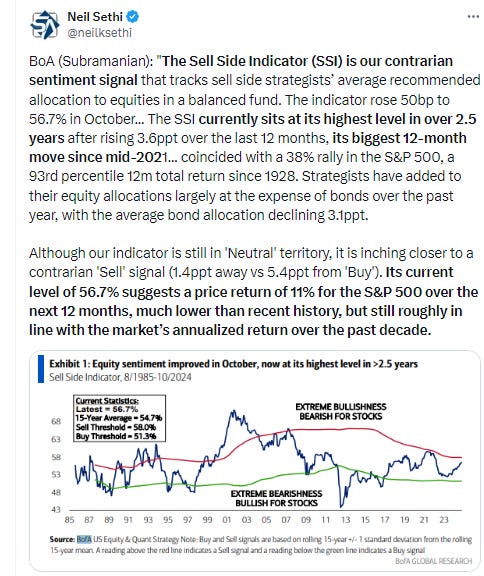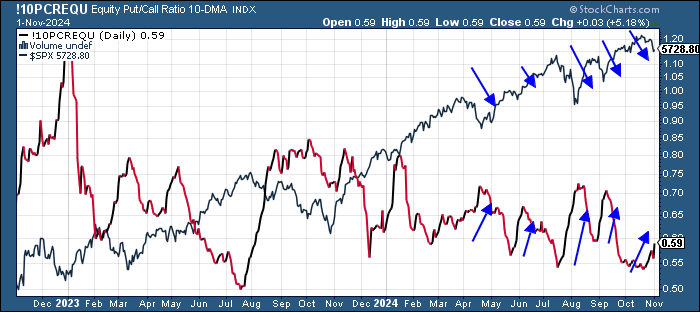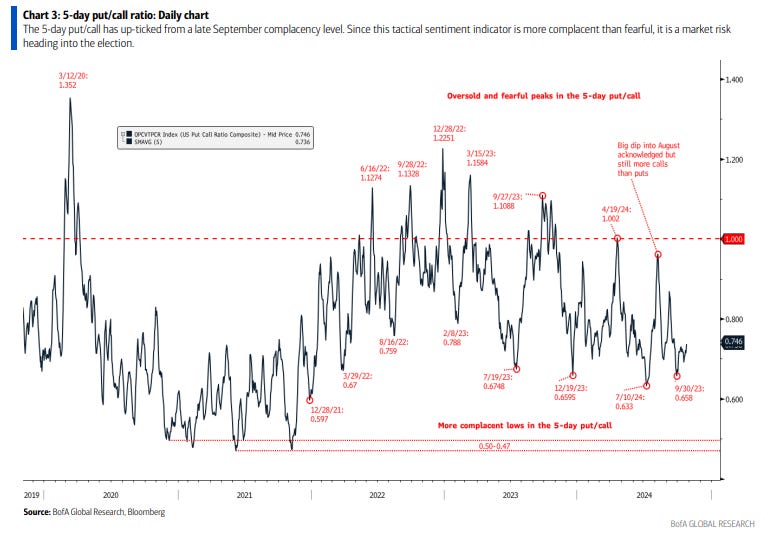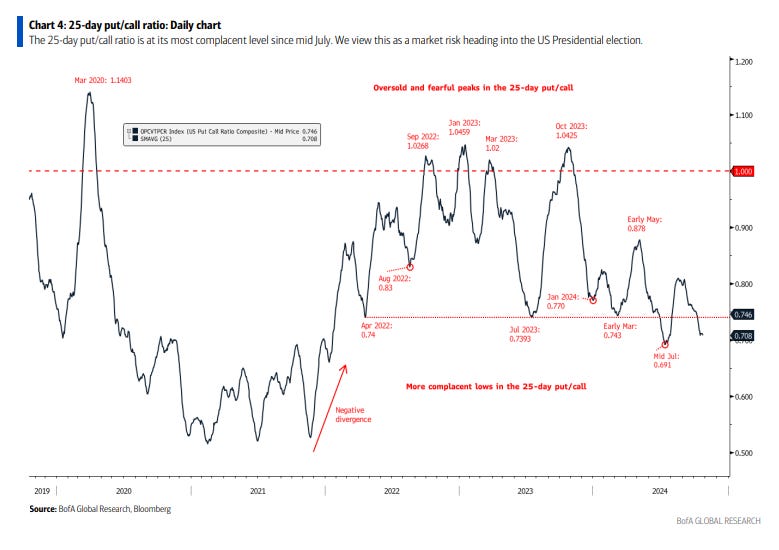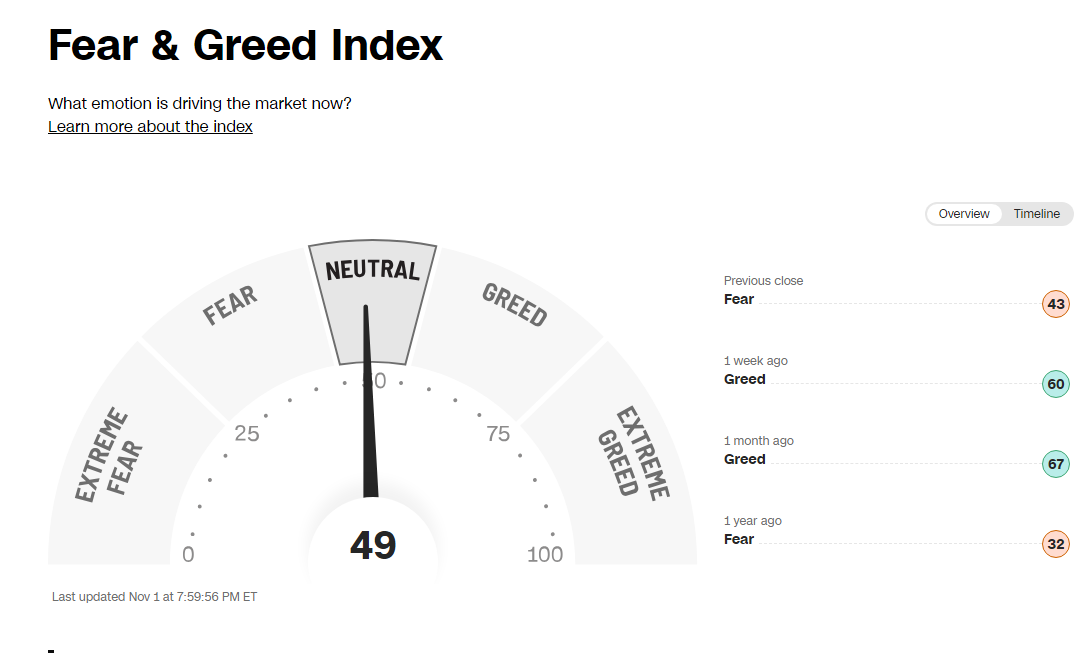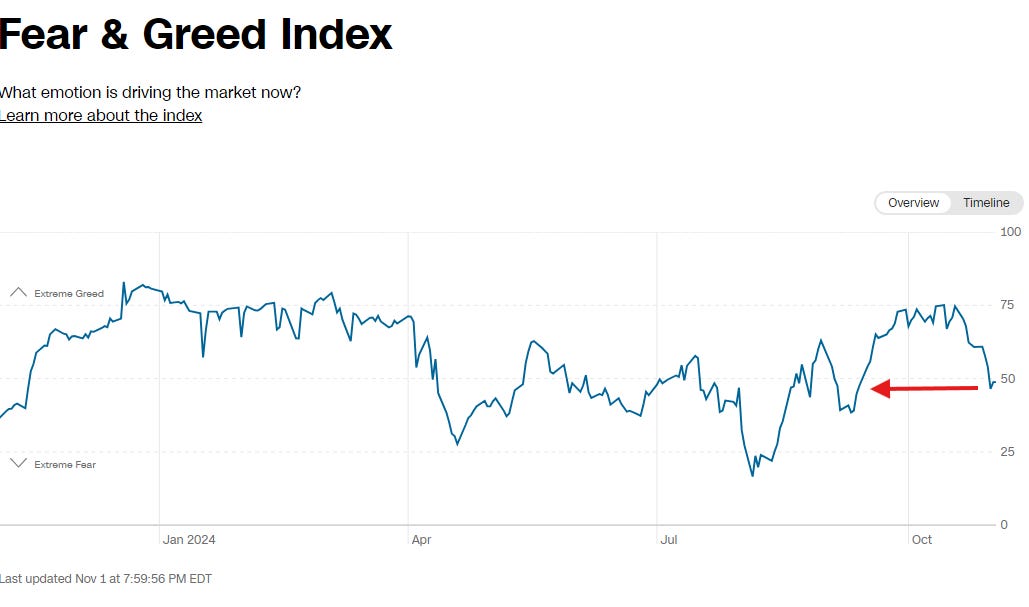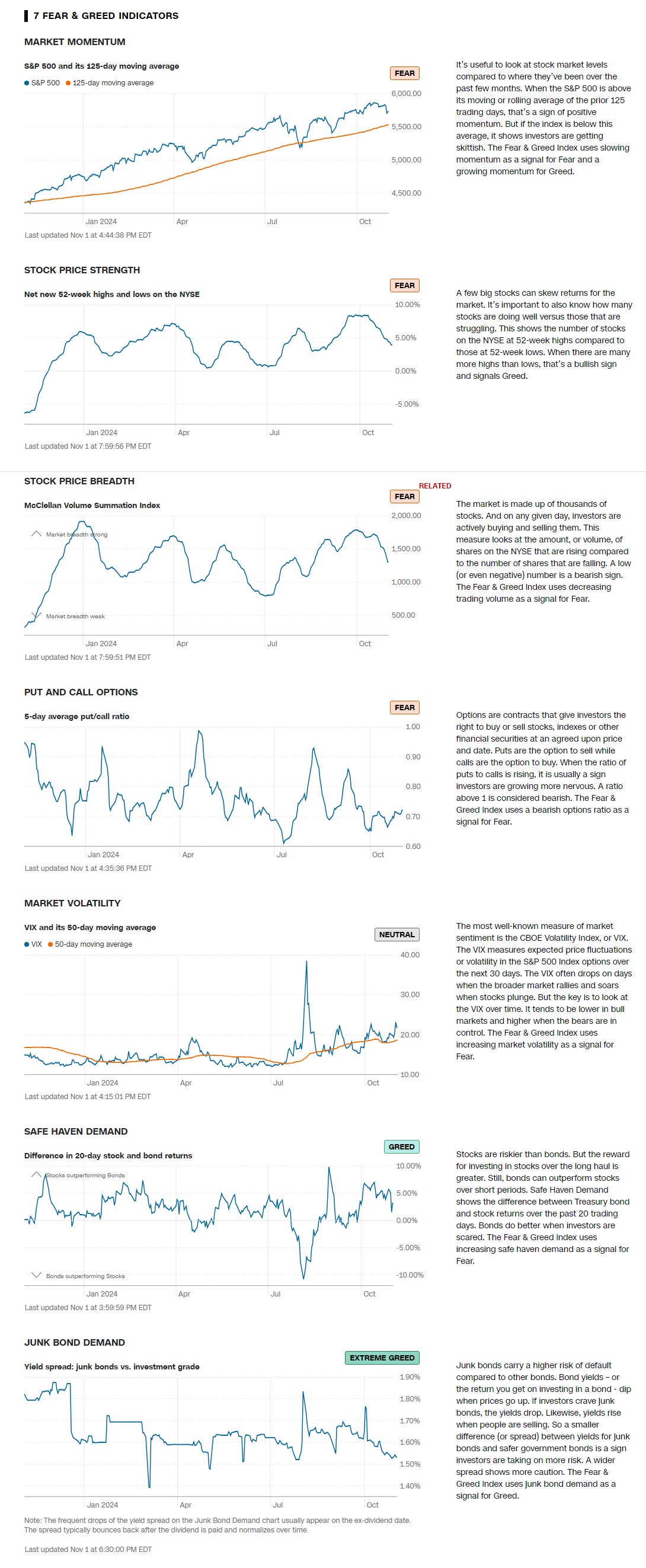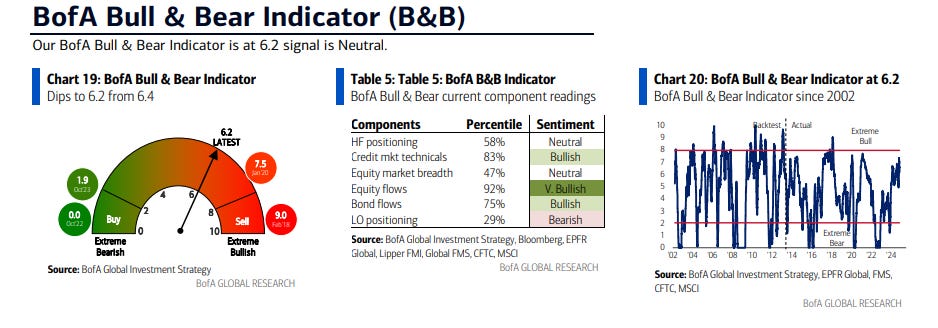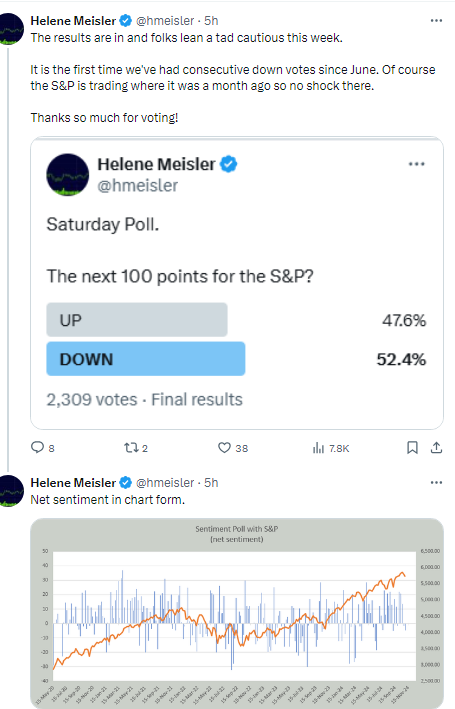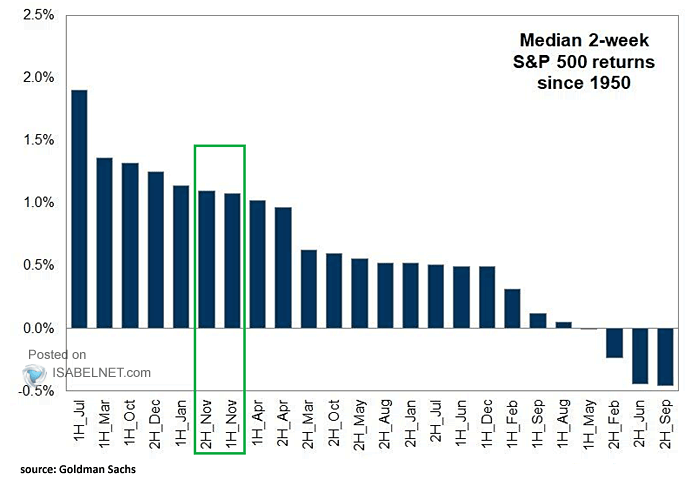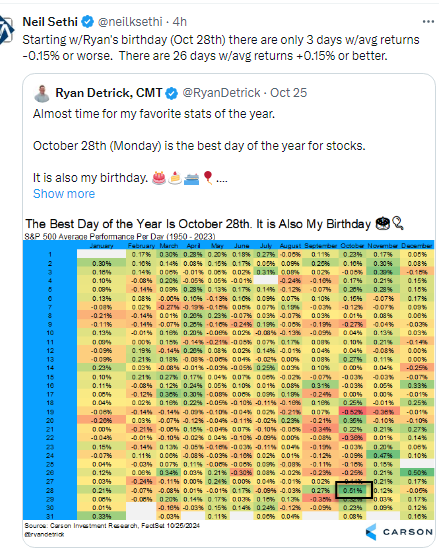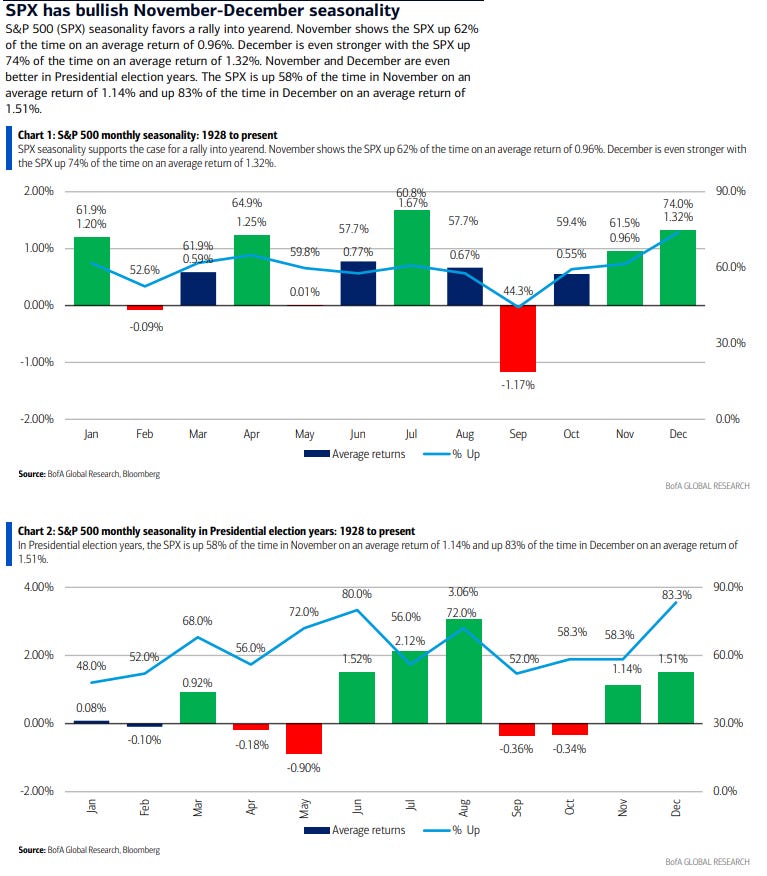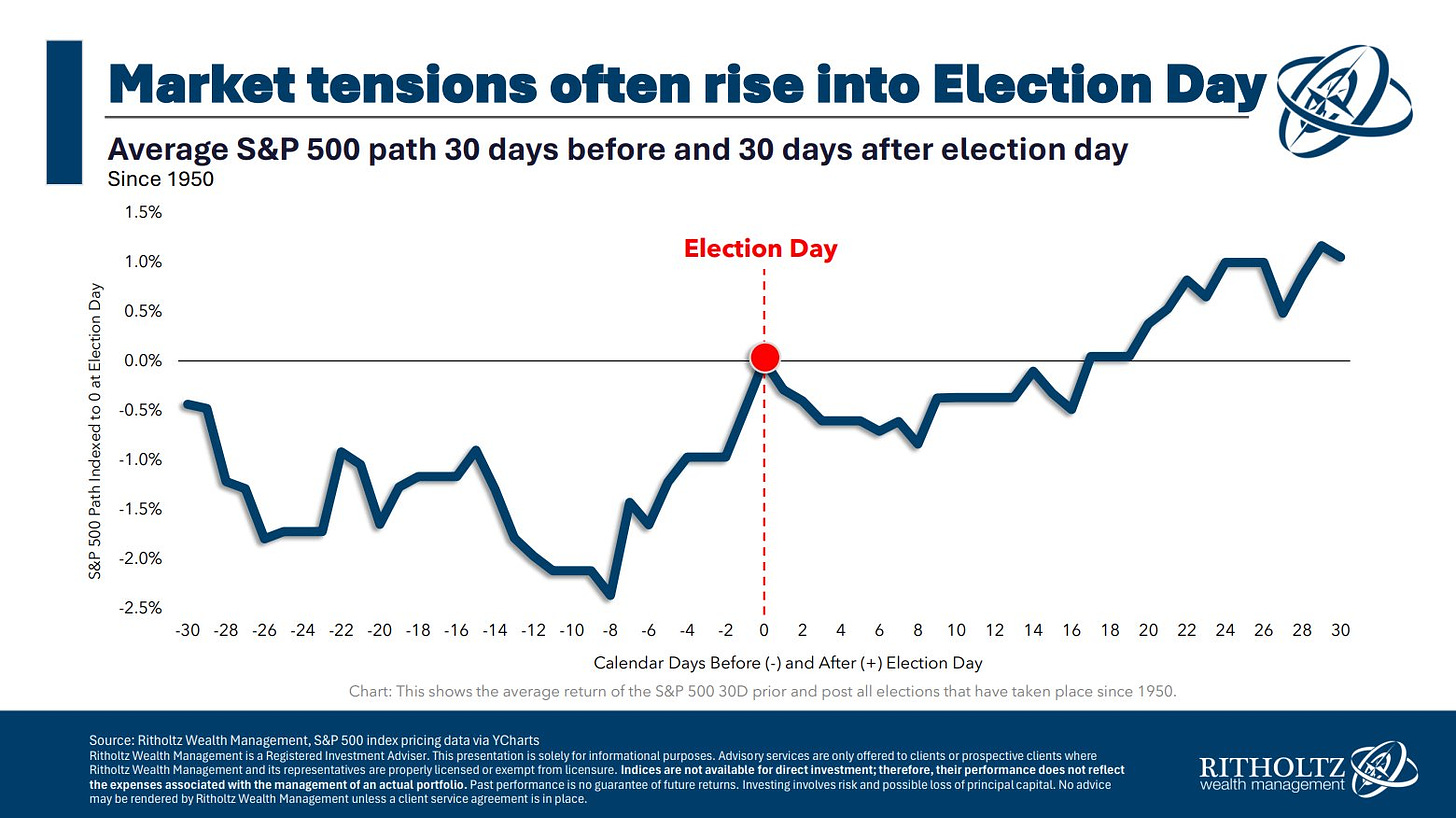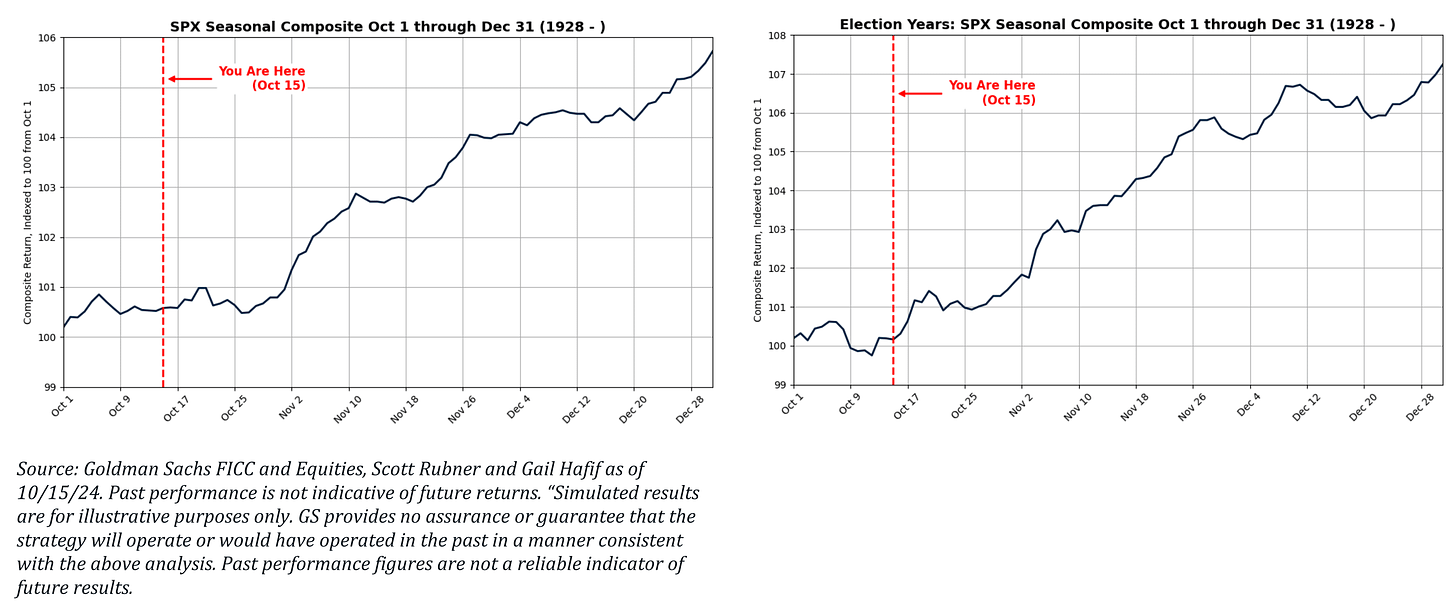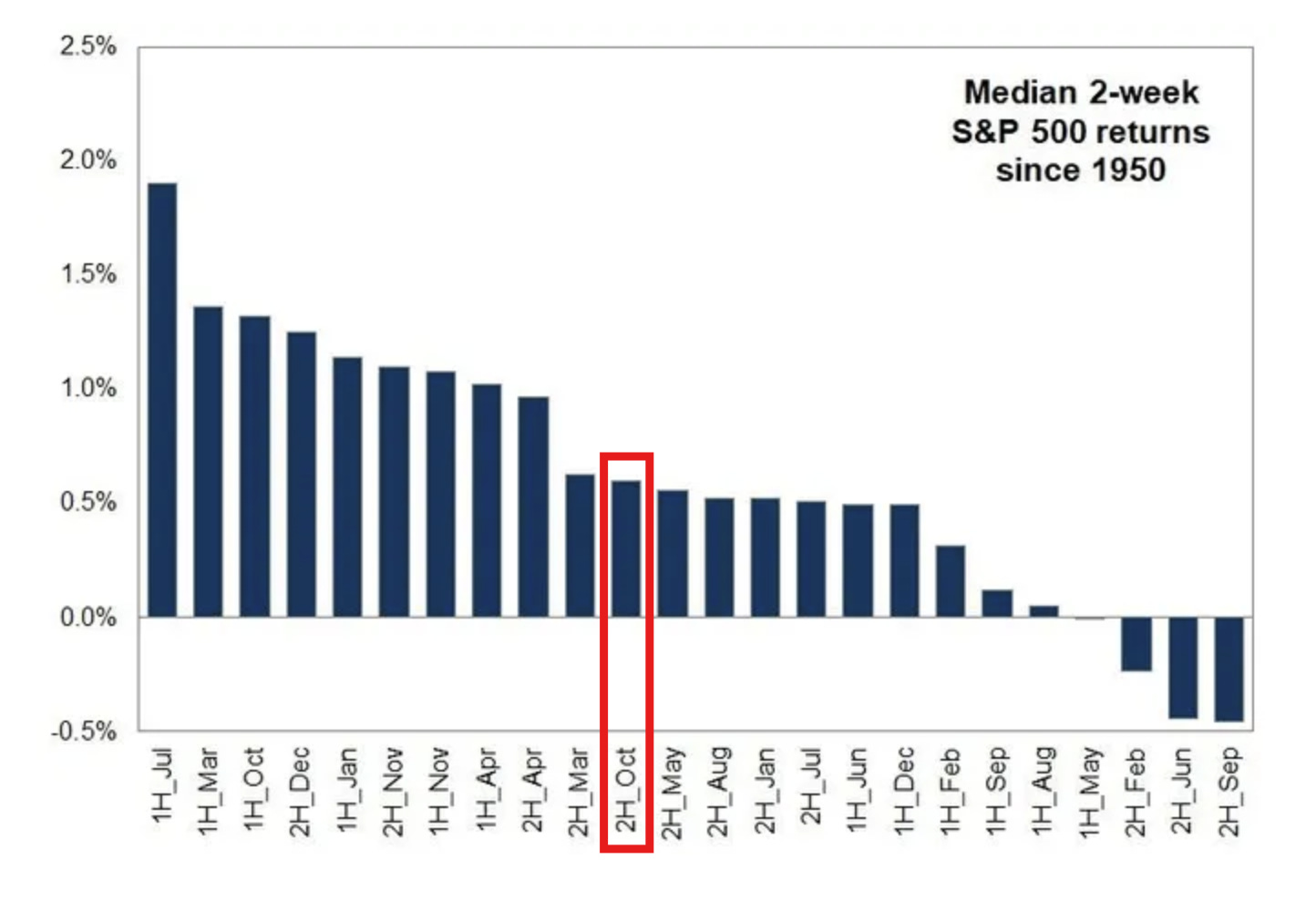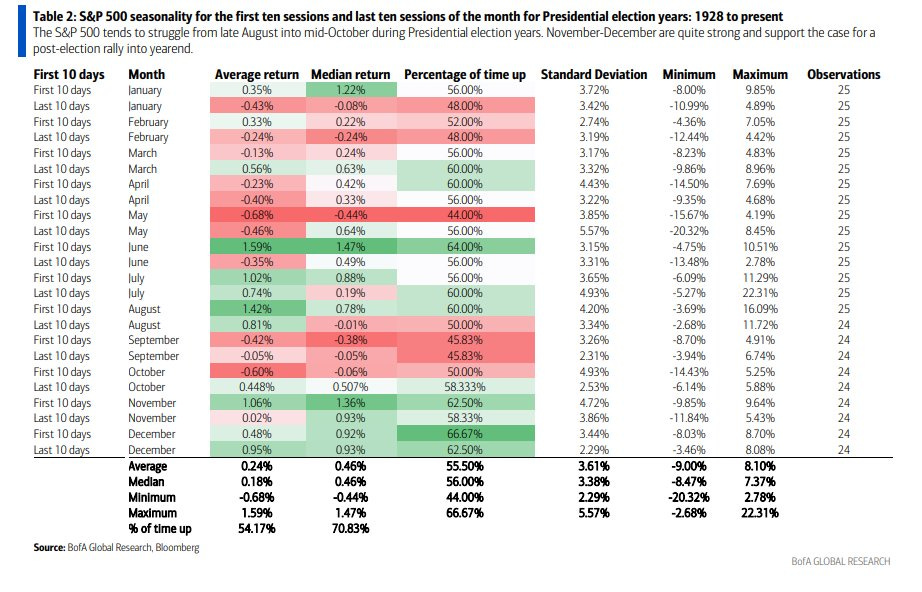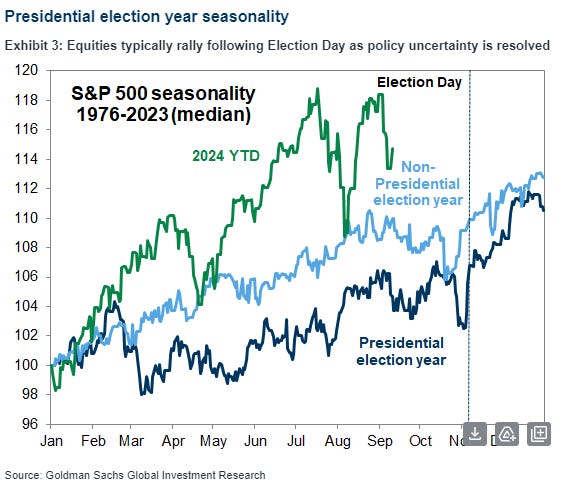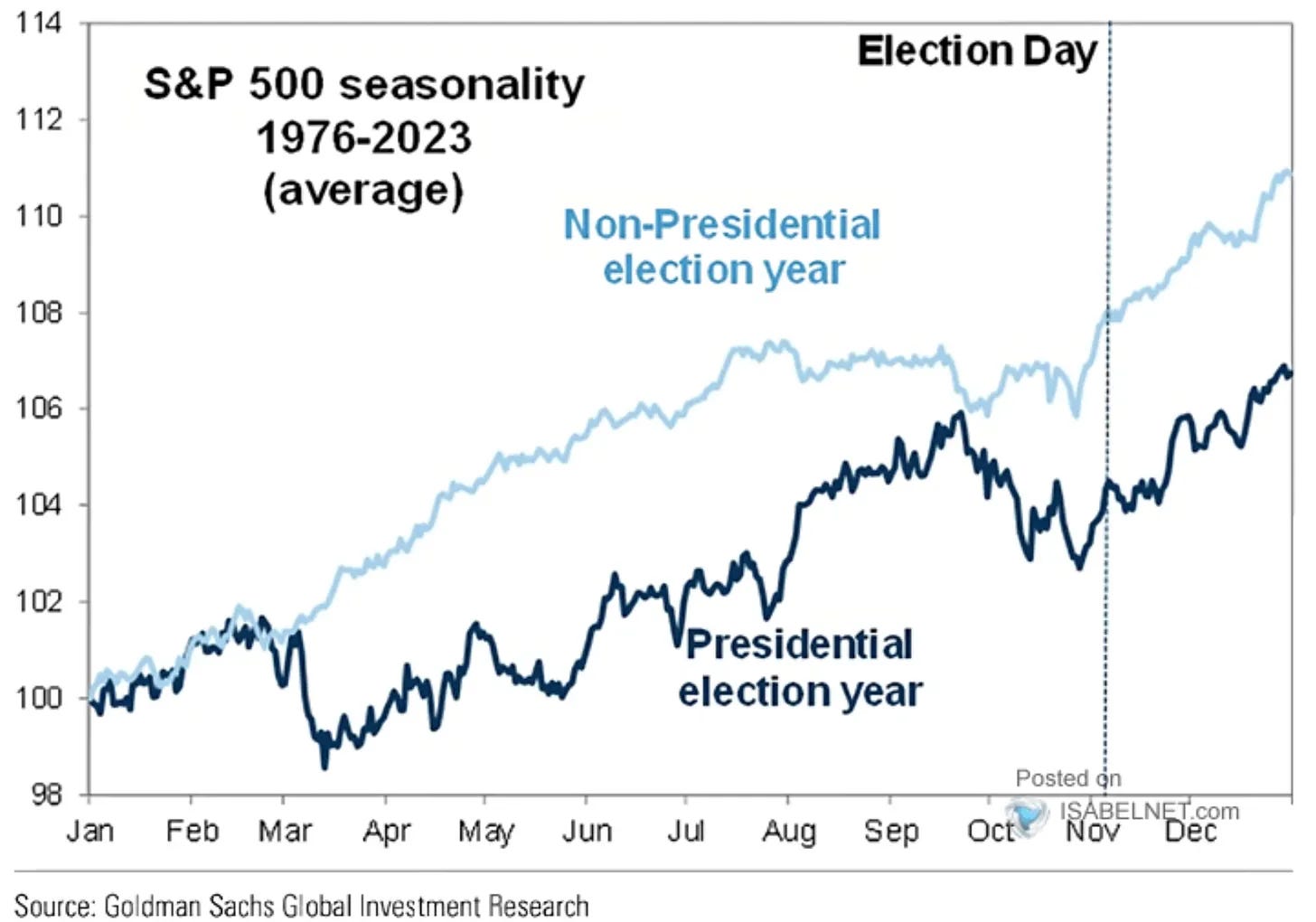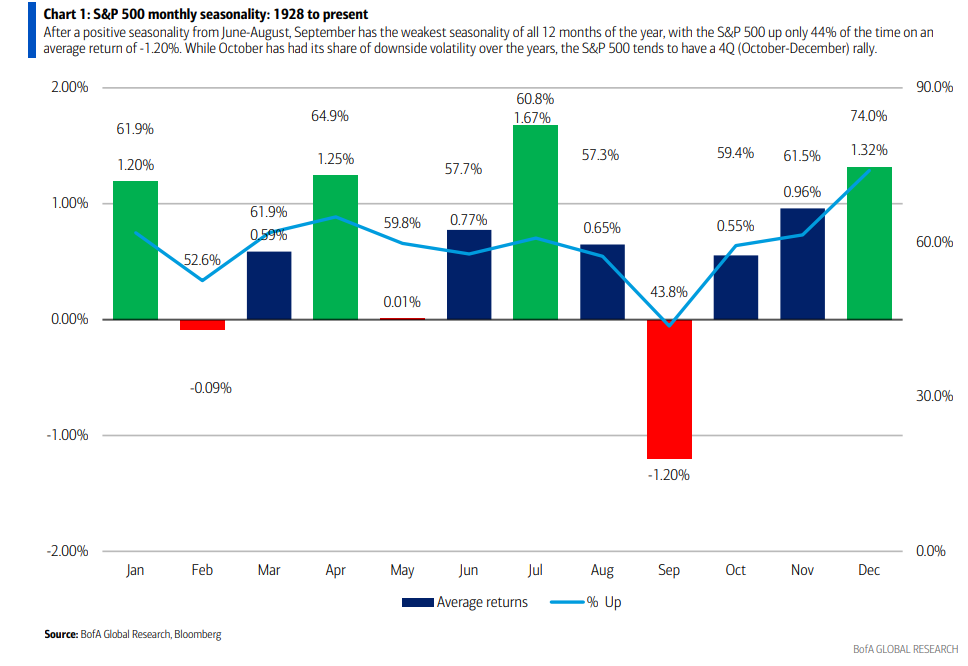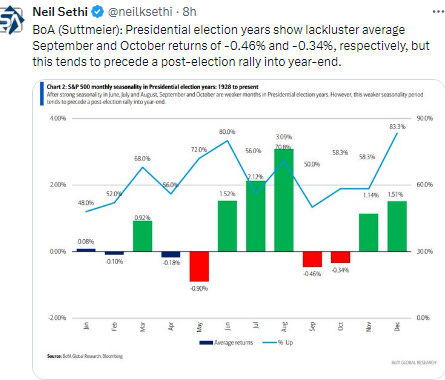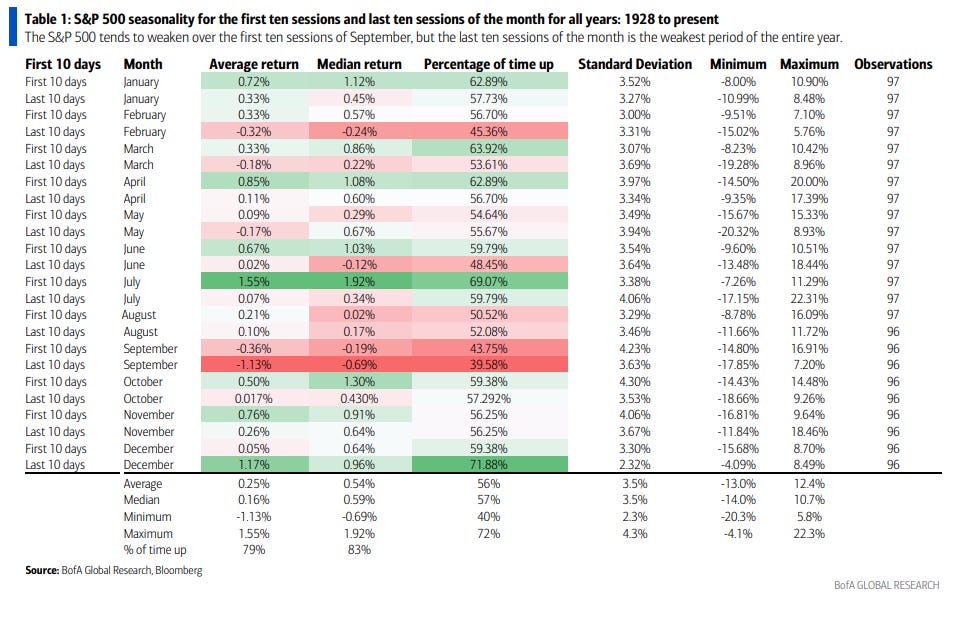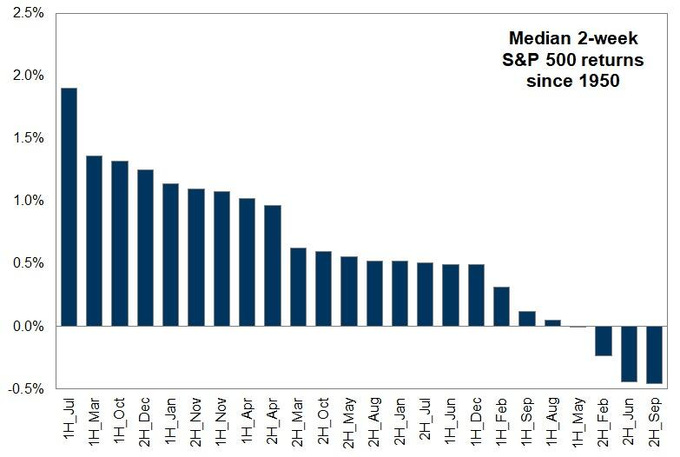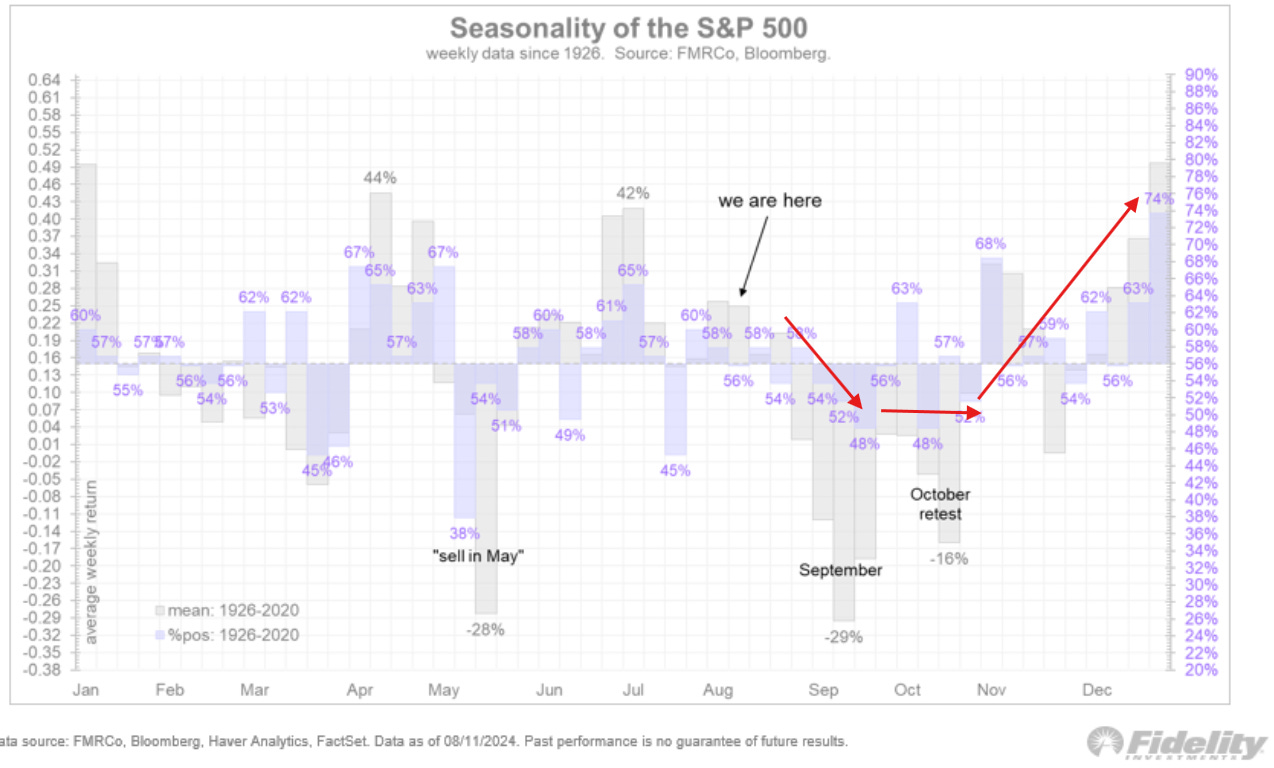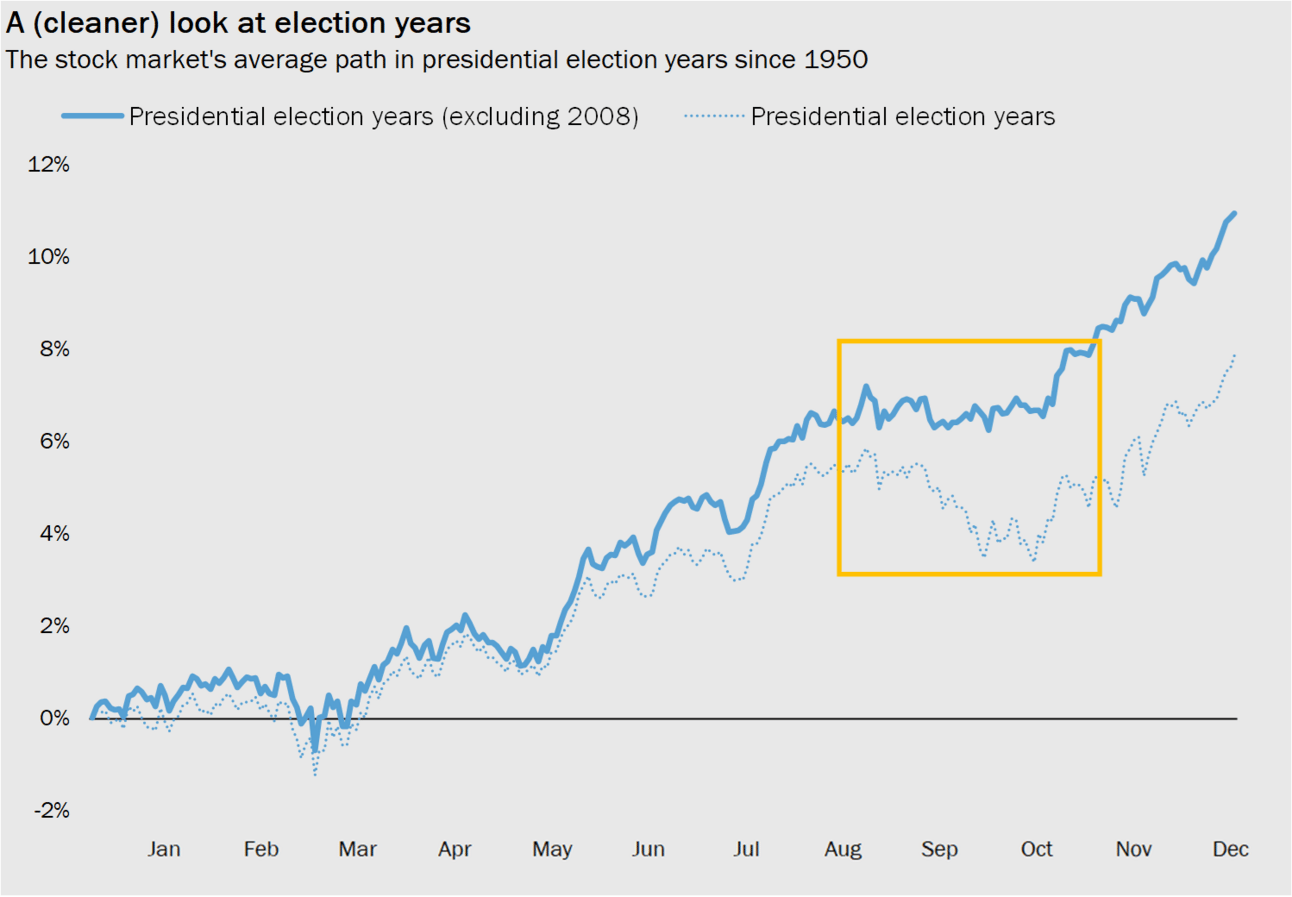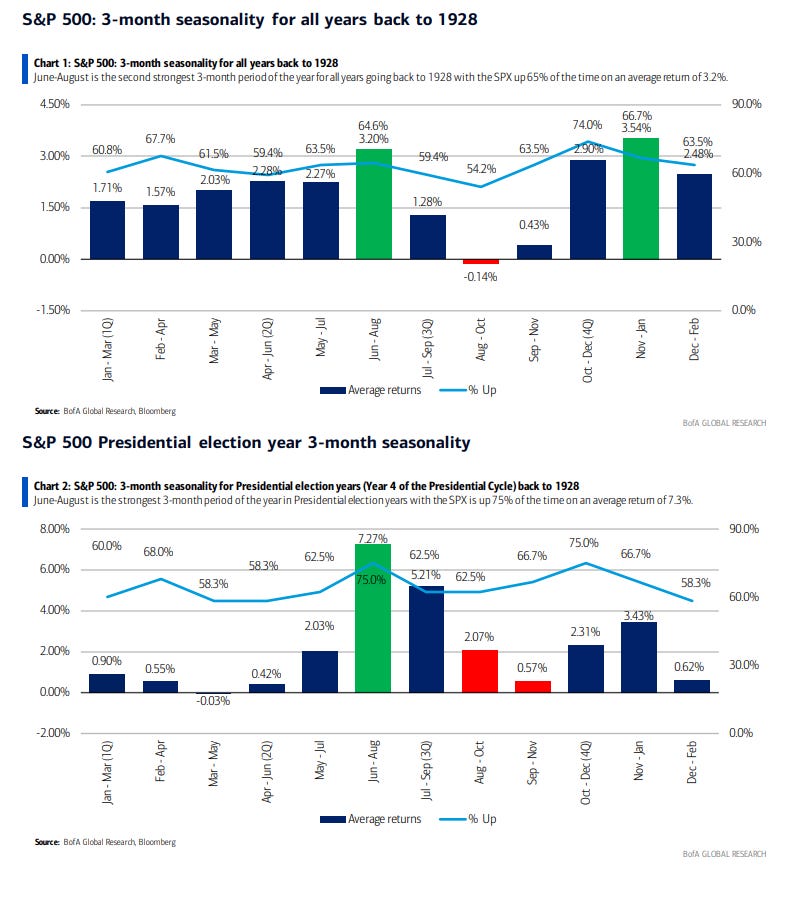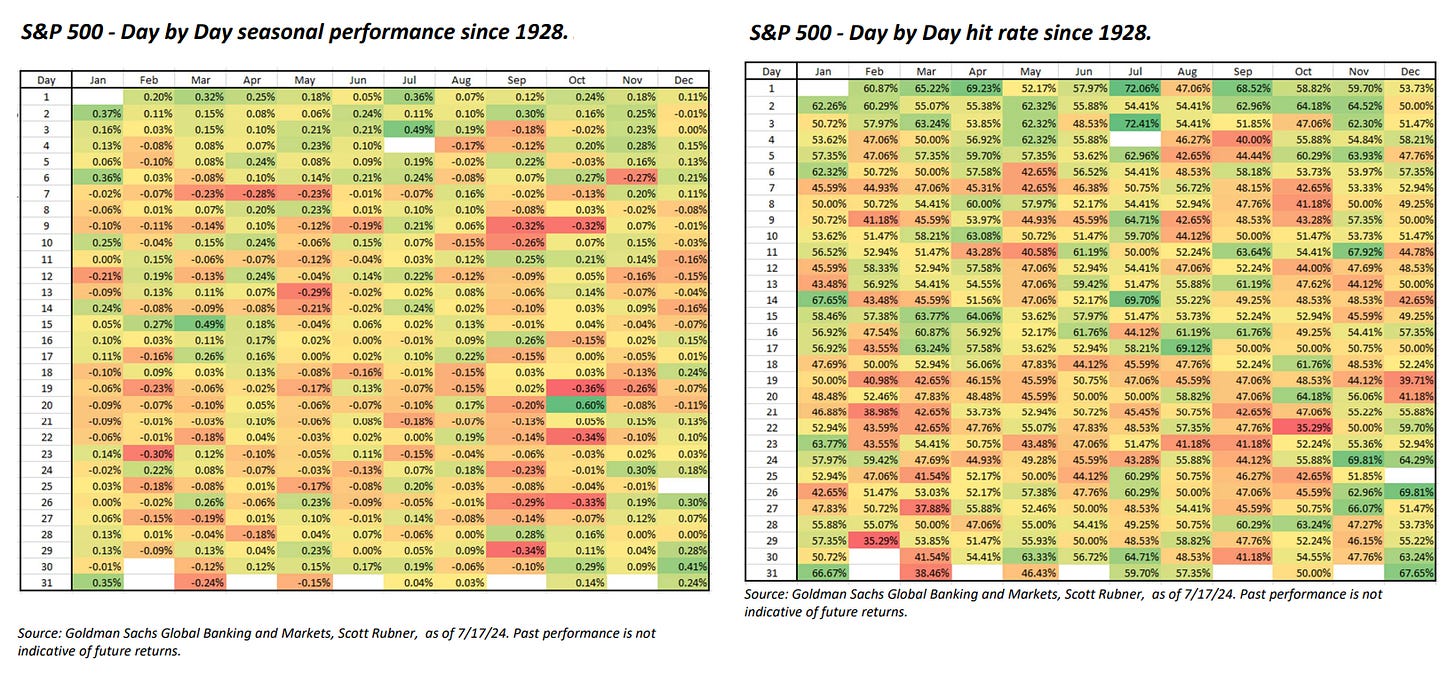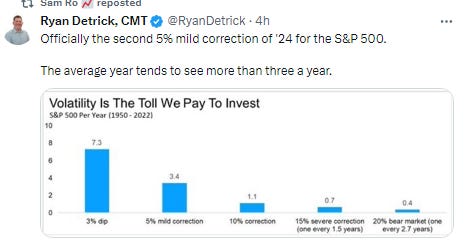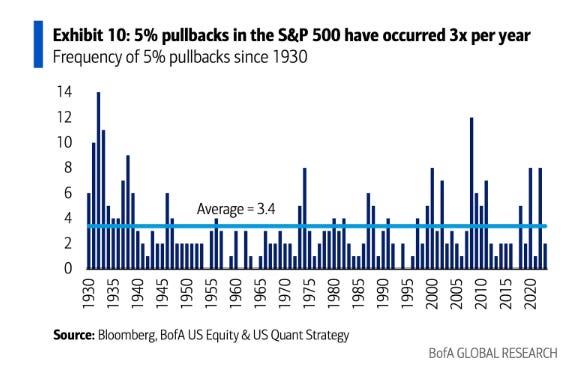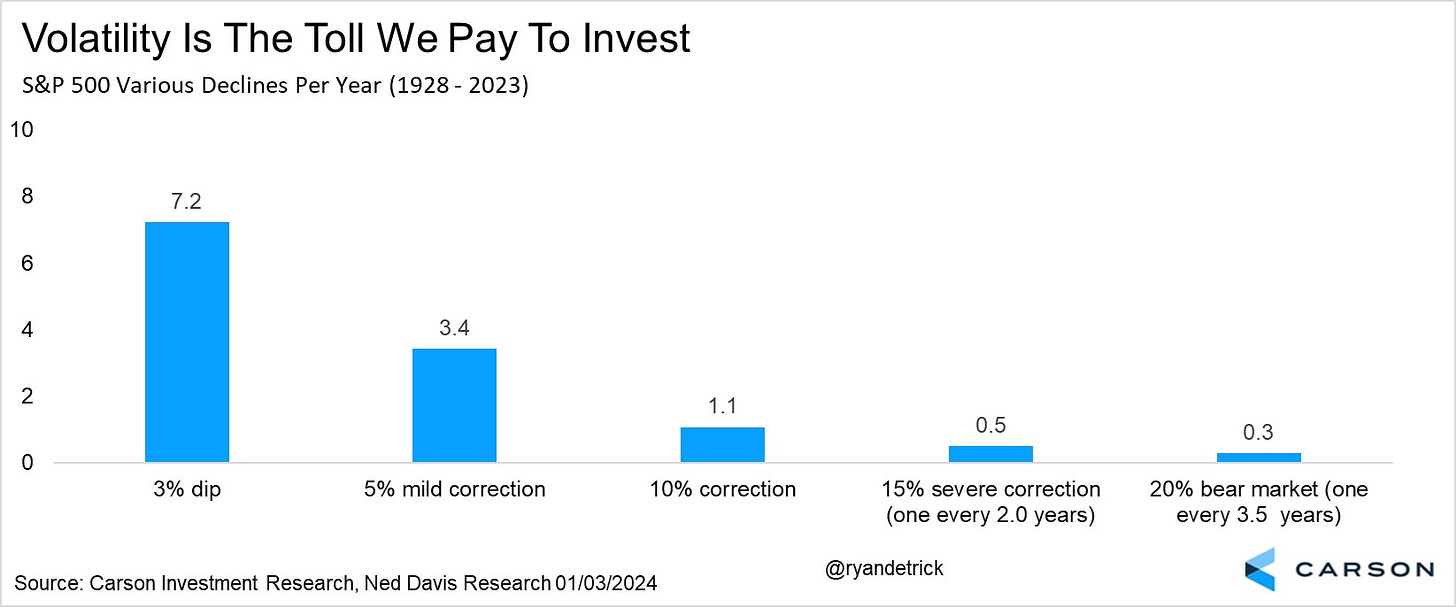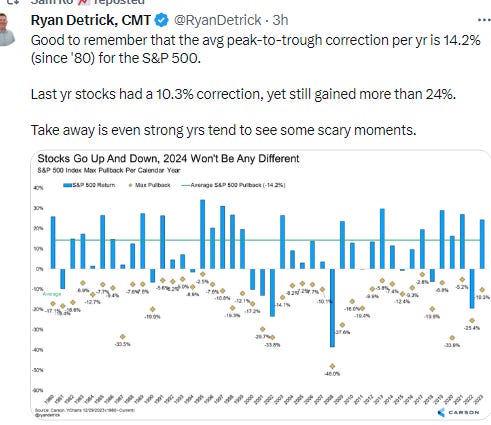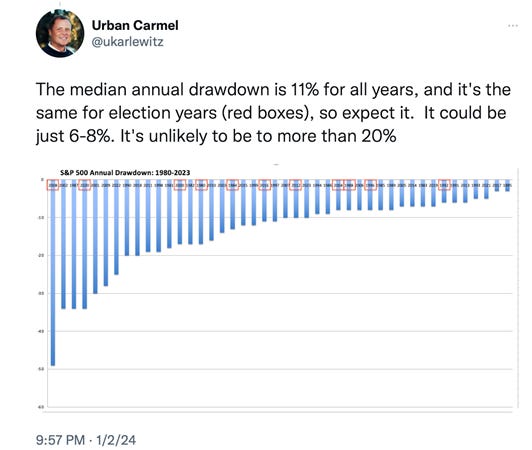The Week Ahead - 11/03/24
A comprehensive look at the upcoming week for US economics, equities and fixed income
If you're a new reader or maybe one who doesn’t make it to the end feel free to take a second to subscribe now (although then you’re missing my hard hitting analysis!). It’s free!
Or please take a moment to invite others who might be interested to check it out.
Also please note that I do often add to or tweak items after first publishing, so it’s always safest to read it from the website where it will have any updates.
As a reminder, some things I leave in from prior weeks. Anything not updated is in italics. As always apologize for typos, errors, etc., as there’s a lot here, and I don’t really have time to do a real double-check.
The Week Ahead
As noted in last week’s Week Ahead, last Monday started “a whirlwind 2 weeks of economic data, central bank meetings, Treasury announcements, and of course the US election.” Last week was all about the data (although we still have a normal docket for the upcoming week as discussed below) and earnings (with the largest week (by market cap) reporting. This week it’s the “events” which will take center stage headlined of course by the US election Tuesday but also central banks responsible for more than a third of the global economy will have policy decisions headlined by the Fed and Bank of England Thursday (the latter after the historic UK budget unveiled last week which I’m sure has them a bit concerned with its huge spending increases).
But in terms of that economic data, the premier report is probably the 3Q productivity report. Productivity is a “free lunch” in that it allows for greater economic output without greater expense (whether in labor or equipment). The Fed loves higher productivity, and it comes the morning of the FOMC decision. Second is probably the final Oct services PMI’s, but most all of this week’s reports are important in one way or another (and many feed directly into GDP) including Sept factory orders, trade balance, wholesale inventories, and consumer credit, Nov’s preliminary U of Mich consumer sentiment, and weekly jobless claims, mortgage applications, and EIA petroleum inventories. I’ll try to catch up on some of last week’s reports as well.
Fed speakers will continue to be light (as in none) until Thursday when we’ll hear from the man himself (Powell) Thursday at the press conference following the Nov 6-7th policy meeting. As noted in Friday’s update, market expectations are that a 25bps cut is basically a lock at this point (98% priced). I think given that the chances of them not cutting are very small, but if they were not going to cut, you will know about it via a communication through their media “go to’s” Nick Timiraos of the WSJ and now Coly Smith of the FT.
US Treasury auctions will also remain heavy with $58bn in 3yr notes, $42bn in 10yr notes & $25bn in 30yr bonds Mon, Tues & Wed (moved a day up from the normal schedule due to the Fed meeting Thursday). While there’s little question what the Fed is going to do, there’s some uncertainty about how they'll set direction going forward and a lot of uncertainty about who will be running the country (both at the Presidential level and the House) which could see some demand weakness (although it wasn’t a problem for the 7yr auction last week (but may have been for the 2 & 5yr’s?)).
And as noted while earnings will slow considerably (by market cap) we’ll actually get the biggest week by # of reports including 103 SPX components representing ~10% of S&P 500 earnings, led by Health Care (18), Utilities (14) and Tech (14). But there are just 4 companies with >$100bn in market cap reporting (from 41 last week) with the largest being Qualcomm ($184bn).
While you can expect a lot less earnings hype next week…
… that doesn’t mean it will be slow unless you just buy the index.
From Seeking Alpha (links are to their website, see the full earnings calendar):
Earning Spotlight: Monday, November 4 - Vertex Pharmaceuticals (VRTX), Palantir Technologies (PLTR), Constellation Energy (CEG), Zoetis (ZTS), Marriott International (MAR), American International Group (AIG), Diamondback Energy (FANG), and Illumina (ILMN).
Earnings Spotlight, Tuesday, November 5 - Ferrari (RACE), Apollo Global Management (APO), Emerson Electric (EMR), Marathon Petroleum (MPC), Cummins (CMI), Microchip Technology (MCHP), Yum! Brands (YUM), DuPont de Nemours (DD), Restaurant Brands International (QSR), and Archer-Daniels-Midland (ADM).
Earnings Spotlight, Wednesday, November 6 - Novo Nordisk (NVO), Toyota Motor (TM), Qualcomm (QCOM), Arm Holdings (ARM), Gilead Sciences (GILD), MercadoLibre (MELI), CVS Health (CVS), McKesson (MCK), Williams Companies (WMB), Sempra (SRE), Johnson Controls International (JCI), Corteva (CTVA), and Take-Two Interactive Software (TTWO).
Earnings Spotlight, Thursday, November 7 - Arista Networks (ANET), Duke Energy (DUK), Airbnb (ABNB), Petroleo Brasileiro (PBR), Motorola Solutions (MSI), Air Products Chemicals (APD), Becton, Dickinson (BDX), Fortinet (FTNT), and Block (SQ).
Earnings Spotlight, Friday, November 8 - TELUS (TU), NRG Energy (NRG), Baxter International (BAX), Paramount Global (PARA)(PARAA), CNH Industrial (CNH), Fluor (FLR), and Embraer (ERJ).
Ex-US the week is dominated by central bank policy decisions led by the Bank of England Thursday which as noted above has been made more complicated by the massive budget proposed by the UK’s Chancellor (which given the Labour party’s huge majority is almost certain to pass). While a cut is still expected, the messaging around future cuts will likely be more restrained as a result. In total central banks responsible for more than a third of the global economy will set borrowing costs this week (including the Fed) including in addition to the BoE central banks in Australia (hold expected), Brazil (where a rate hike is expected), Pakistan (where a 2% rate cut is expected), Sweden (25bps cut expected), Norway (no change expected), Poland (hold expected), and the Czech Republic (25bps cut expected). Economic reports will include global services PMIs and inflation reads, Japan wage data, Asian trade data,
Turning to Canada, the labor force survey due for October will follow a surprisingly solid report in September that saw the jobless rate tick down to 6.5%. The Bank of Canada nevertheless proceeded with a 50 basis-point cut on weak inflation and economic growth, and the fresh jobs data will offer insight into how the labor market is holding up. The central bank will release a summary of deliberations that led to their jumbo-cut decision and Senior Deputy Governor Carolyn Rogers will speak at the Economic Club of Toronto.
In South Asia, Pakistan’s central bank is likely to keep its monetary easing cycle moving at a quick pace with another 2-percentage-point cut, bringing its key rate to 15.5%. The following day, Australian officials are expected to hold their cash rate target at 4.35% after consumer inflation stayed elevated in the three months through September, cementing notions that policymakers will have to wait before pivoting. The RBA will also release a new round of economic forecasts that could shed light on the timing of a potential cut. Malaysia’s central bank is seen standing pat on its benchmark rate on Wednesday. South Korea releases an update on inflation on Tuesday, with figures expected to show further easing, supporting the Bank of Korea’s policy pivot last month. Consumer-price statistics are also due from the Philippines, Thailand, Vietnam and Taiwan. Japan publishes wage data that may keep the central bank on track for a rate hike late this year or early next, and trade data are due from China, Australia, Vietnam, Taiwan and the Philippines. Countries publishing third-quarter gross domestic product data include the Philippines and Indonesia. Finally, China releases key updates on price trends on Nov. 9, with the focus on whether consumer inflation continues to stagger along at a pace just north of zero, and factory-gate prices slide further, after declines deepened in the previous two months.
The backdrop of the borrowing and spending plans unveiled in the UK isn’t anticipated to distract policymakers from further easing for now. They’re predicted by all 49 economists surveyed by Bloomberg to deliver a quarter-point rate cut on Thursday. Bu with the budget featuring a fiscal loosening, Bloomberg Economics reckons that quarterly forecasts accompanying the decision will probably show higher growth and medium-term inflation. Turning to Sweden, expectations for the Riksbank have shifted decisively in favor of a half-point cut to 2.75% on Thursday, after data showed the economy remains in a holding pattern. Output shrank in the third quarter, and the country’s large export sector is becoming more pessimistic. After almost three years of stagnation, Swedish officials may adopt a greater sense of urgency in aiding growth, especially as inflation has fallen below its 2% target and threatens to remain stuck there unless domestic demand picks up again.
On the same day, Norges Bank is expected to keep its rate at 4.5%, with renewed krone weakness likely to preserve its outlook for no easing until March next year. Even with underlying inflation slowing, a currency drifting closer to multi-year lows is clouding projections for imported price growth. Norway’s ruling coalition has also drafted a budget for 2025 that’s more expansionary than expected by policymakers, adding to arguments for them to stay hawkish. Here’s a quick roundup of other decisions expected from around the wider region:
On Tuesday, Madagascar is set to increase its key rate for a second time in a row to tame double-digit inflation.
Polish policymakers on Wednesday are widely expected to hold rates steady. But a new projection coupled with the latest string of disappointing data from the economy may prompt them to signal easing is on the way.
In Botswana, encouraged by the slowest inflation in more than a year, officials are set to reduce their rate on Thursday, the first decision since a shock election outcome ended the Botswana Democratic Party’s 58-year grip on power in the major diamond producer.
The Czech central bank will hold its rate-setting meeting the same day, with the market betting on another quarter-point rate cut.
Serbian policymakers will decide between resuming monetary easing or holding rates for a second month, at a time when inflation seems safely back in the target range but risks persist from food and energy prices.
And then on Friday, Romania’s central bank is expected to keep rates unchanged again at its final meeting of 2024. Officials are waiting for the government to reveal measures, potentially tax increases, to reduce a budget deficit before committing to any more rate cuts.
In the euro zone, industrial data are likely to prove a highlight, with numbers from France, Germany and Italy all scheduled. Several policymakers are slated to speak, including European Central Bank President Christine Lagarde, Vice President Luis de Guindos, and chief economist Philip Lane. Turkish data on Monday will probably show inflation dipped slightly in October, to 48%. The central bank’s aim is to slow it to the 38% to 42% range by the end of the year, allowing it to start cutting the rate from its current level of 50%. Meanwhile, International Monetary Fund chief Kristalina Georgieva is visiting Egypt to discuss an $8 billion loan program. She’s in the country to hear views on how the lender can further support the North African nation as it emerges from a grinding economic crisis, she told the state-run Al-Ahram newspaper. Egypt has signaled it wants to review targets and timelines of the deal amid regional upheaval, with Houthi attacks in the Red Sea and the war in Gaza leading to reduced Suez Canal traffic and tourism revenue.
In Brazil, central bank chief Roberto Campos Neto’s warnings about unmoored inflation expectations, along with rising headline readings, has analysts looking for a half-point interest rate hike to 11.25% on Wednesday. The early consensus also is for a third straight increase at the central bank’s December meeting. Banco Central de Reserva del Perú will likely trim the nation’s borrowing costs by a quarter point, to 5%, with inflation running right around the mid-point of its 1%-to-3% target range. Still, Peruvian policymakers, led by Julio Velarde, have delivered unexpected decisions at five of their last eight meetings, so another surprise is possible. Colombia’s central bank serves up both its quarterly inflation report and the minutes of its Oct. 31 meeting, where policymakers made an eighth straight rate cut. Analysts surveyed by the central bank expect 350 basis points of easing from the current 9.75% by the fourth quarter of 2025.
And here’s BoA’s cheat sheets for the upcoming week.
And here’s a calendar of 2024 major central bank meetings.
Market Drivers
So let’s go through the list of items that I think are most important to the direction of equity markets:
Fed/Bonds
As noted previously this was one of the sections that had grown unwieldy, so I’ve really pared it down. Given I provide daily updates on Fed expectations, Fedspeak, and analyst thoughts on the Fed, it’s duplicative (and time consuming) to gather it all again so, again, I encourage you to look at those (the daily posts) for updates. I will just give more of a quick summary.
In some background, I noted two weeks ago,
while we did get the very strong retail sales report, the chances of a November cut were little changed at around 90%, as noted in the (delayed) Friday report (link if you missed it). That was despite recent Bostic comments (2x) indicating a pause could be in the cards. This tells me there’s almost nothing that is going to move market prices outside of Powell (or perhaps Waller or Williams) confirming that’s their base case or (maybe at this point more likely) the now new messaging funnel of media outlets (WSJ, FT) indicating that’s not the case. Again, the Fed has not during Powell’s tenure surprised to a large magnitude, so if a November cut is not coming I’m confident we’ll know in advance.
And last week,
And not much has changed since then. This was a lighter week for data ahead of the crush we get in the upcoming week as noted at the top which did a good job in summarizing the situation for the Fed. Currently they seem on net content with a 25bps cut (although they haven’t yet gathered and as we saw in the meeting minutes (and heard from Powell) the discussions have been “vigorous” so I wouldn’t be too comfortable about any particular call even after this week). But between GDP, ECI, PCE prices, and the employment report, we should have a pretty good idea of the situation facing the Fed when we get to the end of the day on Friday. So I’ll leave it there for now.
And after GDP, ECI, PCE prices, and the employment reports we end up around where we started with a 25bps cut for November a lock as noted in Friday’s update. December is a little less certain at 82% but still more likely than not according to current pricing. That of course remains subject to a whole host of data including another round of NFP, PCE prices and personal income/spending reports and two rounds of CPI/PPI reports not to mention the results of the election. But for next week you can pretty much bank on a cut after the weak payrolls print (in particular the revisions to the prior months).
Turning back to where we are now, with yields moving higher across the curve again this week, the 2/10 curve was little changed at +0.16% Fri according to the St. Louis Fed, -1bps w/w remaining below the +0.26% it hit Sept 25th (which was the steepest since June ‘22).
As a reminder, historically when the 2/10 curve uninverts following a long period of inversion the economy is either in a recession or within a few months of one. Given we just got a 2.8% GDP for 3Q and are currently estimating well over 2% for 4Q, it seems like the days of the 2/10 curve as an infallible recession indicator may be numbered.
The 3mos/10yr yield curve (considered a better recession signal than 2/10’s) continued its rapid resteepening now just -0.24%, +24bps w/w (and +1.21% since Sept 11th) now the least inverted since Nov ‘22. It is still saying that policy is restrictive, but much less so than 6 wks ago.
Long term inflation expectations (as measured by the 5-yr, 5-yr forward rate (exp'd inflation starting in 5 yrs over the following 5 yrs) were little changed at 2.29% +2bps w/w in the middle of its range this year.
With yields rising and inflation exp's falling, 10yr real rates using 5-yr, 5-yr forwards (subtracted from the 10yr nominal yield) rose to 1.98%, the highest since July +2bps w/w & +57bps since Sept 17th (& well above the 2010-2020 peak of 1% but down from the Oct peak of 2.5%).
10yr real rates using 10yr TIPS saw a bigger move also to the highest since July +9bps w/w to +2.0%, also in the middle of the range this year (1.53%-2.28%). Also still well above the 2013-2020 average of around 0.5% (but down from the peak of 2.5% in October).
Shorter-term real yields (Fed Funds - core PCE) remain well over 2% at 2.48% slightly off the highest since 2008.
And the real prime rate (using core PCE) is at 5.65%, just off the 5.9% in June which was the highest since Sep 2007. No wonder small biz sentiment has been so negative.
And the gap between 2yr Treasury yields and the Fed Funds continues to close now 0.67% versus the record of 1.77% before the Sept FOMC meeting, still though remaining at levels historically indicative of further FOMC cuts.
And looking out longer term, one thing to note is the FOMC’s long run projection for the endpoint of the Fed Funds rate (the “neutral rate”) has steadily increased this year, now the highest since Sep 2018 at 2.9% (and not unlikely to go higher). [This gets updated this week]
And the 10yr term premium from the St Louis Fed (who uses the Kim and Wright (2005) model which differs from other models in that it incorporates non-yield curve factors such as inflation & GDP) continued to rise, +10bps w/w to +0.45%, the highest since May (from the least since July ‘23 six weeks ago), moving closer to the +0.65% it hit last October when it caught everyone’s attention (which it has already).
I have been a broken record since the Spring that I thought at some point (either into the election or maybe as we get into next year with the likely higher Treasury issuance required (although BMO thinks that could be as late as August)) this could resurface as an issue that will push yields higher and cause some equity indigestion as it did then, and it appears it’s continuing to happen.
Also as Simon White of BBG noted 3 weeks ago it generally increases after FOMC rate cuts which we may be seeing some of as well (circle).
The extended discussion on term premium (what it is, why it’s important, etc.), can be found in this section in the Feb 4th Week Ahead.
As the MOVE index of expected 30-day bond volatility continued to increase this week, Thurs hitting the highest levels since last Oct.
And while 30yr mortgage spreads did increase again this week to 2.44%, +9bps w/w, they are just back to Sept levels (while the MOVE index is the highest in a year). Spreads remain just +16bps above the least since June ‘22, a little more than a half percent above the 2010-2020 avg level.
And the Chicago Fed National Financial Conditions Index and its adjusted counterpart (which are very comprehensive each w/105 indicators) in week through Oct 18th both loosened w/w despite the rise in rates, now the loosest since Jan & Feb ‘22 & respectively.
Turning to the discussion of the Fed’s balance sheet/QT and its impact on RRP, we continue to get steady, sizeable auctions of T-bills (<1 yr duration) of around $800bn/month as well as the $60bn in balance sheet runoff which quickly drained ~$1.75 trillion from RRP in the year through March 1st. From then until early July they had remained relatively stable in the $375-$500bn range, but since early July have resumed their decline (in fits and starts) falling on Friday under $200bn for the first time since May ‘21 (when RRP went from $129 to $485bn) at $155bn on Friday -$47bn w/w (and -$107bn the past 2 wks).
This was a situation the Fed was comfortable with even when they were down below $300bn (at the Sept FOMC press conference Powell went so far as to say liquidity was “ample”, amplified later by comments from Dallas Fed Pres Laurie Logan (who is an important voice given her extensive experience in the NY Fed's markets group) who like Powell described liquidity as “more than ample” and said she's looking for RRP to fall to "negligible" levels). As I said in previous weeks “she's the expert so I'll defer to her, but I will continue to be on the lookout for funding stresses if RRP starts to get much below $200bn, and I still think at zero RRP the Fed will likely need to stop QT to avoid another liquidity shortage as they did in late 2018.”
And as noted previously, BoA, who had previously estimated that RRP would fall to zero in Oct has pushed that out now to Jan ‘25 (which may be pushed out further in the event the debt limit is not raised, and the Treasury is not able to continue auctions until it is reinstated (more on this later)). Citi in contrast has thought it will remain around the $300bn level until RRP rates fall.
And Powell’s and Logan’s lack of concern with liquidity was echoed by New York Fed’s Roberto Perli who said bank reserves remain “deep inside the ‘ample’ range,” even as the difference between peak and avg bank overdraft levels with the Fed has been increasing, traditionally a warning sign of bank reserve scarcity, although it may also just be a sign that banks are becoming more comfortable using the overdraft program. “We’re reluctant to draw strong conclusions from the latest data, as we don’t know exactly what is driving the trend,” said Wrightson ICAP senior economist Lou Crandall, and “if some banks are in fact more willing to rely on their Fed overdraft privileges to meet intraday working-balance needs, they may be less inclined to hoard reserves going forward,” Crandall wrote. “That ultimately could allow the Fed to shrink its balance sheet more than would otherwise be the case.”
Meanwhile BTFP loans (the emergency loan program created by the Fed in the aftermath of the SVB collapse) continue to fall as loans come up for refinance. As noted previously the Fed has wanted to clear these loans out and raised the rates to make them unattractive starting Jan 1, 2024. As these are 1yr loans, that means that by the end of this year all borrowers will have had to either pay off or refinance their loan at the now unattractive rate. As you can see from the chart below, many are choosing the former with the program down to around $58bn (from $167bn at the peak in March of this yr), -$2bn w/w, now the least since Mar ‘21 (when it went from $0 to $64bn) which I think will fall to near zero by year end. This will add to pressures on funding markets to some extent (the money has to come from somewhere).
For more on BoA’s forecasts for RRP to drop to near zero ($60bn) by Oct you can follow the link and look in this section (but it’s mostly due to RRP yields falling below those of money markets and will be soaked up by bonds (from Fed QT), the Treasury (with a higher TGA), and currency growth (in dollars). If bank reserves increase that would also pull from RRP. They see it building again into early 2025 before declining again towards zero.
For more on BoA pushing back their est for the end of QT to Mar ‘25 from YE ‘24 “which could create a funding blind spot for the Fed” in the event the debt limit (which expires at YE) is not resolved you can follow this link and look in this section. In summary their thinking is that, similar to earlier this year, the Treasury’s depletion of its General Account (TGA) will offset what would otherwise be a continued drawdown of liquidity. That will keep liquidity stable but will rapidly reverse once the debt limit is ultimately raised (which BoA est’s will again be in July as they assume Congress will take it to the very last second as is their habit), which could lead to a funding squeeze. However if the debt limit is miraculously raised in advance, the liquidity issue will come quickly as noted above, and we could very easily find ourselves in another 2018 scenario (which resulted in a near bear market).
But RRP dropping continues to take pressure off of bank reserves which were little changed in week through Wed at $3.22bn (after hitting the least since March of this yr three weeks ago at $3.10bn), still not far from the $3tn level where we saw some indigestion in the credit markets in March ‘23 contributing to the banking issues (SVB, etc.). They remain just -$59bn below June 1, 2022 levels, when the Fed started QT, a much better result than even the most optimistic estimates at the time.
For background on various estimates of when reserves will be “too low” see the Feb 4th Week Ahead.
Getting back to rates, I said 6 months ago 2-year Treasuries were a good buy at 5%, and at this point the ship has sailed on seeing those yields anytime soon (meaning years). In terms of 10’s I had advised grabbing some at 4.7% which I had thought seemed like something we won’t see anytime soon, but we’re now starting to hear calls for as high as 5% in the event of a Republican sweep. I remain unconvinced but at a 3% terminal rate, 5% is actually not an unreasonable number at some point in the not too distant future, particularly if the term premium continues to move higher. As I said 5 weeks ago in terms of lower yields we have may have seen the lows until we get a recession:
“while we didn’t quite see 3.5%, I think 3.6% is close enough, and I think we might have been at or near the lows at this point, particularly as the Fed has been raising their neutral rate estimate. If the endpoint for Fed Funds is around 3% (or higher) then it’s hard to see the 10yr trading much lower absent a recession. Similarly 2yrs at 3.6% seem to be very rich and almost certainly too low absent a recession consistent with my statement last week.” In short I’d expect to see 4% on these before we see 3.2%:
At around 3.6% on both the 2 & 10yrs absent a recession I think there’s not much value in either (I’d rather park my cash in short term Treasuries (0-3mths) or safe dividend paying stocks with a track record of growth (dividend aristocrats, etc.) at these levels.
And as seen in the daily updates, consistent with that, we have seen a dramatic repricing with 10yr’s now at 4.36% almost to my (new) target of 4.4% (after 4.25% was breached). I four weeks ago “I am still hesitant to recommend 4%", which was so far a good call as yields are now materially higher, but as I’ve said the last couple of weeks I think we’re getting close to the point where we may see some pullback in yields at least in the short term (which has been a less good call). I think getting the election past us (and the Fed meeting) may be the catalyst that sees yields pull back.
For all the old “final hike” and “first cut” materials, you can reference the Feb 4th blog post.
And after much prodding BoA updated their FOMC Dove-Hawk Chart. Note it’s missing Hammack in ‘26 (Cleveland and Chicago vote every 2 yrs), but otherwise looks right. Also note that Philadelphia Fed Pres' Harker’s term is up next year (which is why they don’t have a name for Philadelphia), something I didn't realize.
Also, I had a little back & forth with them arguing that Schmid should be "Hawkish" considering that he didn't dissent (versus Bowman) and that Goolsbee seemed more dovish than Harker. Here was their response (which makes some sense):
In a recent dot plot (I think June), Goolsbee identified himself as not the outlier, which led us to conclude Harker is the outlier. On the other end of the spectrum, there were two people forecasting 50bp of total cuts this year. We think they’re probably Bowman and Schmid. If we had more granularity, we’d rate Bowman as more hawkish, but with only five categories, I’m comfortable with putting them in the same bucket.
Earnings
As a reminder, I have removed most of the background material, which you can get in the Feb 4th blog post. As you know I’ve moved on to 2Q and beyond. You can reference this post from 5/12/24 for stats on 1Q.
As we continue to move through Q3 earnings season, now with 70% of SPX earnings weight having reported through Thursday Factset reports 75% have beaten expectations (the same as last week), below the 5yr (77%), but above the 10yr avg (74%). Overall companies are reporting earnings that are +4.6% above expectations (down from +5.7% last wk & +6.1% the wk before (so unusually going in the wrong direction)), now below 1yr (+5.5%), 5yr (+8.5%) & 10yr (+6.8%) avg's.
According to Factset Tech has been the drag: “Since September 30, positive EPS surprises reported by companies in the Financials, Communication Services, and Consumer Discretionary sectors, partially offset by negative EPS surprises reported by companies in the Information Technology sector, have been the largest contributors to the increase in the overall earnings growth rate for the index over this period.“
Despite the reduced beat amount we’ve still seen 3Q earnings expectations edge higher to 5.1% y/y growth from 3.6% last wk, now above the 4.3% on Sept 30th. 3.6% though would be the lowest growth since Q2 ‘23.
BoA for their part sees a little higher number at 7% which they say tracks the historical improvement from the start of earnings season.
And I note each quarter, you have to account for the “earnings inflation” which happens as companies beat the lowered bars they set for analysts (37 of last 40 quarters have seen actual earnings beat expectations at the end of the previous quarter (exceptions were Q1 '20 (Covid) & Q3/Q4 '22)). As Factset reminded us at the start of the season, even with those outliers, the past 10yrs earnings have ended +5.5% higher than the start of the quarter, which would equate to +9.9% earnings growth. However with 70% of earnings in, it seems highly unlikely we’ll come anywhere close to +9.9%. In fact, I’d bet it’s not much changed from the current +5.1% which would mean we’d have seen the least earnings inflation (less than 1%) since Q4 ‘22 when it was -1.4%.
On the top line, 60% of companies have beaten expectations (up from 59% the prior wk but down from 64% the wk before that), below the 5yr (69%) & 10yr avg’s (64%). Companies are reporting revenues that are +1.1% above expectations (down from +1.2%), below the 1yr & 5 yr avg’s (+2.0 & 1.4%).
But like earnings, revenue growth exp’s increased w/w to +5.2% from 4.9% (which will be the 16th consecutive quarter of earnings growth) also up from +4.7% on Sept 30th.
Expectations for earnings in future quarters were marked notably lower again this week particularly for Q4 which was down another seven tenths to +12.7% (now down -2.3% the past 4 wks), Q1 ‘25 down four tenths again to +13.0% & Q2 ‘25 also down four tenths again to +12.2%.
Much of the weakness though in 4Q can be chalked up to Boeing (Industrials) & Energy.
But according to Factset the -1.8% decline in 4Q earnings expectations since the start of the season is not unusual, equal to the 5- year, 10-year, and 20-year averages.
Putting it together the improvement in 3Q expectations has outweighed the deterioration in 4Q to see FY ‘24 earnings expectations see a rare (since the start of Sept) week of improvement up 52 cents to $239.88 (from the least since the start of 2024 tracking in 2023), remaining overall down just around -2% from July 1, 2023, much better than the typical -6% or so drop we historically see.
2025 earnings expectations fell a little to $274.81, the least since February, and continuing to see the typical softening from July ‘24 levels.
In terms of how markets are handling earnings beats & misses at this point, looking 2 days before to 2 days after an earnings release, we’ve seen a reversal in how the market is rewarding beats now rewarding them less than average (vs more than average a week ago) at just +0.3% (from +1.1% (and +2.6% two wks ago)) vs 5yr avg of +1%, but continues punishing misses more than average (-3.9% (from -3.6% last wk & -2.2% two wks ago) vs 5yr avg of -2.3%).
But BoA sees things a little differently looking just the day after earnings:
Heading into earnings, we highlighted elevated levels of single stock volatility priced into the options market (see stock picker’s paradise). So far, the median ratio of realized reaction vs. implied topped 1x, which would be the second time in our data history since 2014 (happened in 2Q23) – Exhibit 31. On average, stocks moved 5.0% the day after earnings, representing the second largest move in history (last quarter was the highest at 5.2%). Reactions were also skewed to the upside, with beats outperforming the S&P 500 by 221bps the next day (vs. avg. 148bps), the largest since 2Q19 vs. misses underperforming by 211bps (vs. avg. 245bps) – Exhibit 32. If it holds, this will be the first quarter since 1Q20 when positive surprise alpha eclipses negative surprise alpha.
Despite top line earnings expectations falling back, Factset’s analysis of analyst bottom-up SPX price targets for the next 12 months as of Thursday moved up +55pts w/w to 6466, now up ~1,443 points over the past 34 weeks. Communications remains the sector with the largest difference between current prices & exp’s (+15.5%, up +1.5% last 2 wks), followed by Health Care (+15.4% (+1.7% last wk)) & Energy (+15.4%, up +3.1% last 2 wks), while Utilities has the smallest (still +8.3%, up from +1.9% 3 wks ago).
As a reminder the last 10 yrs they have been on avg +2.9% too high (+3.4% last 5 yrs). Of course, that avg range masks a wide discrepancy between big up and down years.
In terms of analyst ratings, buy and hold ratings continue to dominate although we saw a slight move from buys to holds at 53.7 & 40.7% (from 53.9 & 40.5% respectively (sell ratings remained at 5.6%). Communication Services (63%), Energy (62%), and Information Technology (60%) sectors have the highest percentages of Buy ratings, while the Consumer Staples (41%) has the lowest percentages of Buy ratings.
And some other earnings stuff:
Economy
Over the past 2+ years part of my earnings optimism has been due to the economy holding up better than expected. While earnings only track the economy loosely (and markets look forward 6-12 months), there is a clear correlation between recessions, lower earnings, and lower stock prices (although stock prices (being as noted forward looking) generally fall in advance of the recession and bottom 6-9 months before the end of the recession). So if you can see a recession coming it is helpful, although very difficult (especially ahead of the market). You can reference this Week Ahead (see the Economy section) for a lot of material on how every recession is preceded by talk of a “soft landing” as close as a month before the start. On the IRA infrastructure act, the November 26 report has good info on how that should be supportive at least through the end of this year. That report also has the notes about how small caps have shorter debt maturity profiles and more of it.
As I’ve been stating since I switched to the Week Ahead posts in mid-2022, the indicators to me are consistent with solid (which at times has been robust) economic growth, and I have been a broken record that I “certainly [did] not think we’re on the verge of a recession (although as noted above every recession starts out looking like just some economic softening).” But several months ago I added: “That said, I’ve also noted over the past __ weeks or so [it got to 22], we have clearly started to see some moderation in key areas like consumption, manufacturing, construction, exports and housing.” The last 7 weeks though I’ve noted “the data [has been] fairly strong, more consistent with what we’d been seeing at the start of the year.” That was again true with much of the data this week with personal incomes & spending, total gross payments from the employment report, consumer confidence, construction spending, jobless claims, ADP, and manufacturing PMI’s all coming in a little better than expected. While GDP was slightly under expectations, it still was very strong at +2.8%. On the weaker side were the employment report Friday, as even if you waive away the low October numbers there were substantial downward revisions to Aug & Sept and several underlying numbers like long-term unemployed continued to drift higher, both goods imports and exports declined more than expected, and jobs openings and quits fell in the JOLTS report to at or below prepandemic levels while layoffs saw the biggest increase since March ‘23 (evan as they remain low historically). Overall, though as noted five weeks ago, “the situation continues to seem like manufacturing is subdued but trying to bottom, housing perhaps has inflected off the bottom [although that is likely to take a step backward in October with the jump in mortgage rates], labor markets (and the services sector and construction in particular) is solid [although the NFP report does raise some questions], and productivity appears to be very healthy…I continue to feel that any softening does not appear to be morphing into a recession.”
Overall, as I said 12 weeks ago:
without question, the evidence is building that the days of >3% real GDP growth are behind us (although we might get a 3+ handle for Q3), and we should be happy to settle into something more around trend (1-3% real (infl adjusted) growth). That though is far from a disaster. The important thing will be to see the softening level out (L-shape) rather than continue to fall turning the “soft landing” into a recession.
And with the on net stronger data last week, the Citi Economic Surprise Index improved to 31.7 from 23.1 a week ago, the highest since April and continuing to move closer to the highs of the year (~50 in Jan) and away from the lows (-47.5, fifteen weeks ago).
And GDP estimates are for now consistent with a no recession call (again though remembering GDP going into recessions generally doesn’t look like one is coming (it was up around 2% in Q2 & Q3 2008 well after the recession had started)). After coming in at 2.8% for Q3, most trackers are looking for around that level for Q4.
Goldman (who was 3.0% for 3Q vs 2.8% actual 1st est) has their 4Q GDP estimate at +2.8%.
Atlanta Fed (who was right in line in its 3Q est of #GDP (and just a tenth off for 2Q from the 1st est)), updates its 4Q GDP est after today's data dropping it four tenths to +2.3%
BoA has released their 4Q tracking estimate yet. Their 3Q GDP tracking ahead of the GDP print was 3.0%, the highest since it initiated tracking. As a reminder, their “official” house est was 2.5% y/y growth in 3Q.
While the NY Fed’s 4Q GDP Nowcast (as a reminder, they had 2.91% for 3Q vs 2.8% 1st est) fell to an around trend 2.01% (from 2.47%), primarily on the employment report (-0.25%) & the ISM composite index (which is weird b/c it hasn’t been released, -0.11%) and revisions to previous months (-0.07%). As a reminder, the NY Fed’s model is dynamic and so adjusts in real time as data evolves, but “parameter revisions” were just -0.01%.
And the St. Louis Fed GDP tracker, which outside of Q1 this yr (where it was the closest) has undershot actual real GDP since Q3 ‘22, hasn’t released their Q4 estimate yet.
While the Weekly Econ Index from the DallasFed (scaled as y/y rise for GDP), which runs a week behind other GDP trackers, jumped back above 2% to 2.11% in the week through Oct 26th after falling sharply to 1.71% the prior wk (rev’d from 1.69%) moving back to the middle of its range this yr (1.49 - 2.66%). The 13-wk avg also improved to 2.05%, evidencing overall economic momentum around trend.
Here’s the components.
Other economy stuff:
Multiple
Like the other sections, I’ll just post current week items regarding the multiple. For the historical stuff, see the Feb 4th blog post.
With forward earnings expectations remaining little changed and equities on net falling on the week, forward P/E’s were mixed but overall remain not far from the highs of the year outside of the “Megacap 8”.
The SPX edged three tenths lower to 21.2 (now -0.4 from the highest since late '21).
Mid-caps (S&P 400) were one tenth lower at 15.9 (-0.3 from the highest since Jan ‘22).
Small caps (S&P 600) actually up a tenth to 15.4, now two tenths below the highest since Jan ‘22.
The “Megacap-8” P/E jumped seven tenths to 29.7 continuing to increase from the 26.4 it hit 6 weeks ago (which was the least of the yr) but remains below the 31.5 it hit 15 wks ago (which was also the highest since Jan ‘22)).
https://yardeni.com/charts/stock-market-p-e-ratios/
Other valuation stuff:
Breadth
Breadth which had improved each week since early Sept into last week deteriorated for a 2nd week.
Advance/decline volume lines continue to be mixed with the NYSE pulling back along with the NYSE Composite while Nasdaq remains near ATH’s with the index further off the highs.
The deterioration in the McClellan Summation Index continues to outpace that of the equity indices w/the former now the least since July while the latter (NYSE Composite) is just the least since Sept.
With the pullback in non-growth equities last week the % of stocks over 200-DMAs fell back on the NYSE to the least since Sept while Nasdaq fell to a 3wk low (but better supported than the NYSE).
And % of stocks above 50-DMAs a similar story to % above 200-DMAs, with the NYSE falling to the lowest since Aug, while Nasdaq is better supported at just the least since the start of Oct.
And % of stocks above 20-DMAs is similar to that above 50 & 200-DMA’s with the NYSE the least since Aug while the Nasdaq a 3-wk low.
The equal-weighted SPX vs cap weighted rato bounced a little after falling to the least since mid-Aug during the past week but has yet to see a higher high since Sept.
It continues to me to bear some resemblance to the 2009 pattern where we saw an initial bounce from historic lows, then a pullback for several months before it embarked on a rapid multi-year recovery.
IWM:SPY (small caps to large caps) moved higher this week but remained not far from 24yr lows.
Equity sector breadth based on CME futures remained weak with again just 2 sectors green (discretionary again & communications replaced tech) and just one up over 1% (none the prev wk but 7 the wk prior to that). Again 7 sectors down -1% or more (vs 1 two wks ago) once again including materials, financials, industrials, staples, utilities & RE, along w/tech which led to the downside (-3.3%).
SPX sector flag last week from Finviz shows some improvement but still a lot of stocks down >-4% from a lot of different sectors including MSFT, NVDA, AMD, MU, LLY, TSLA, UBER, ACN, GE, RTX, NEE, FANG, SLB, AMT, DHI.
Other breadth stuff:
Flows/Positioning
BofA using EPFR data in the week through Oct 30th saw equity flows turn negative for the 1st time in 7 wks (& only 2nd in 24 wks), although just -$1.4bn still +$12.6bn last 7 wks & +$520bn YTD annualizing to ~$624bn:
US 4th wk of inflows, +$6.1bn (for a 2nd wk) +$300bn YTD.
EM saw a 3rd week of big outflows -$5.5bn, after the most since Apr ‘20 the prior 2 wks (now -$16.9bn last 3 wks but only after 20 wks of inflows), now at +$159bn YTD (after $91bn in all of ‘23), w/#China again seeing most of that outflow w/another -$3.9bn after largest outflow since Jul ‘15 prior week (now at -$6.7bn (now -$14.7bn the past 3 wks (but like EM overall only after 20 straight wks of inflows before that)) still +$139bn YTD, while #India saw a 2nd wk of outflows (but only 3rd this yr), -$1bn to +$21.1bn YTD on pace for record yr.
Europe 5th outflow & 79th in 85 wks, -$2.4bn, now -$45.0bn YTD after -$66.9bn in 2023.
#Japan though sees 2nd inflow +$3.2bn, largest since Aug (+$4.7 bn last 2 wks (but after -$10.7bn the prev 2 wks)), now +$12.9bn YTD after +$7.3bn in 2023.
US large caps see 4th consec inflow & 45th in 55 wks +$2.8bn, now ~+$78bn last 6 wks & ~+$346bn last 49 wks after +$125bn in all of 2023).
Small caps see -$0.6bn outflow (-$1.0bn last 2 wks, but +$11.5bn last 16 weeks and +$11.2bn YTD.
US value returns to inflows but just +$4mnn (still -$70.8bn in 2024 after a record -$73bn in 2023).
US growth 6th outflow & the 16th in 18wks -$0.3bn, now -$40.6bn last 18 wks but still ~+$110bn YTD.
Sector specific equity flows were positive in EPFR data in the week through Oct 30th but only because of a huge inflow to materials:
Inflows:
Materials 8th wk of inflows +$3.2bn, largest since Feb (+$8.6bn last 6 wks).
Financials returned to inflows (3rd in 9 wks) +$0.2bn (still -$2.8bn last 8 wks).
Healthcare +$0.4bn inflow (still -$18.0bn last 56 weeks).
Outflows:
Tech led outflows for a 3rd wk -$1.3bn, after the largest since June the prev wk, still +$12.7bn last 14 wks & +$47.2bn last 43.
Utilities returned to outflows, 3rd in 4 wks (although all 3 wks have been v small) -$80mn.
Consumer a 3rd wk of outflows -$0.4bn (-$26.4bn last 54 wks).
Real estate 3rd outflow -$0.3bn, still +$1.7bn last 15 wks.
Communications 3rd outflow -$28mn.
Energy 11th outflow in 12 wks (and only inflow was tiny +$0.045bn) -$0.3bn (-$6.9bn last 12 wks).
Looking at EPFR data in the week through Oct 30th for fixed income saw an 82nd inflow in 83 weeks (and 14th straight) +$18.0bn now ~+$567bn YTD (annualizing to $680bn) but still BoA private client bond holdings as % of AUM lowest since '22:
IG/HG a 53rd consec inflow (& 79th in 81 wks) +$11.2bn, now ~+$408bn YTD, on track for a record $490bn in 2024 after +$162bn in 2023.
Munis the 37th inflow in 41 wks (and 18th straight) +$2.0bn.
HY 12th inflow & 18th in 19 wks (and 43rd in 52) +$1.2bn, now ~+$58bn last 51 wks.
EM debt 2nd outflow -$2.0bn, largest since March (-$2.9bn last 2 wks).
Treasuries 4th inflow, the 23rd in 27 wks (and 34th in 40) +$3.5bn.
Bank loans 4th wk of inflows, +$0.7bn (+$4.3bn last 4 wks).
TIPS 1st inflow in 12 wks & just 2nd in 17 (& 12th in 61), +$0.5bn. TIPS also saw record outflows of -$33bn in 2023.
In week through Oct 30th, EPFR saw cash w/2nd wk of inflows, 5th in 6 wks, +$9.6bn, now +$777bn YTD (annualizing to +$932bn after a record +$1.3T in 2023 and +$3.3T 2019-2023). Investor & fund cash levels though near the least on record.
Gold/Silver see 4th week of inflows & 16th in 18 wks +$0.7bn after most since Jul ‘20 prev wk, +$15.7bn last 22 wks.
Crypto funds (Bitcoin) see 7th wk of inflows +$3.0bn, most since March, now +$14.1bn last 25 wks.
ICI data on money market flows saw a small outflow (-$2.2bn) vs the +$9.6bn in EPFR’s data in the week through Oct 23rd, dropping the YTD flows into money market funds to ~+$583bn but not even a rounding error in total MMF assets which remained at $6.51tn, a record high.
Looking at CTA (trend follower) equity positioning, BoA says “trend follower positioning remains elevated in US equities [although ~33% off the levels in July]. Next week we expect that CTAs will be sellers in any price path with S&P 500 unwinds accelerating [if we see a -1.5% decline (below the 5642 S&P 500 level)]. Outside the US, our model has smaller equity longs in Europe and Japan. We project that trend followers will sell EURO #STOXX50 in all scenarios in the coming days after the index declined for three consecutive weeks.”
SPX continues to have the strongest trend strength at 73% (up from 77% last wk & vs NDX & RUT at 65 & 56% (from 68 & 57%). Europe though back to 18% while Japan edged down a percent to 27% still up from 7% three weeks ago (and a negative read the week before).
In terms of gamma positioning, BoA says that “SPX gamma was well supported into the October month end expiration, averaging +$5.8bn Mon-Wed. However, after the 31 Oct options were wiped from the board gamma collapsed and is now short but minimal in size (-$0.2bn, 5th %ile year-to-date). While gamma is small now, the current gamma profile suggests that if equities decline from here, then gamma may grow increasingly short. Looking at the gamma footprint of the expirations during US election week we now see the following: +$1.3bn (04 Nov), -$0.6bn (05 Nov), +$0.7bn (06 Nov), +$0.3bn (07 Nov), and +$0.4bn (08 Nov)”
As a reminder as I’ve noted weekly this year very high levels of gamma have acted as a market stabilizer dampening volatility in both directions, but when it’s fallen below $2bn or so (as it did this week) we’ve seen heightened volatility (which we did), and while it’s rarely been negative that has been associated with even higher volatility (which is what BoA sees as likely for this week). As they note, it won’t take much in terms of market decline to see gamma push solidly negative which will create that self-reinforcing selling loop. With CTA stops at 5635 according to BoA a push below those levels could see a -1.5% drop turn into a -3%+ drop quickly.
And BoA est's that risk parity strategies continue to heavily overweight bonds and underweight commodities & equities, but as I suggested 2 wks ago should happen given the more placid last 30 days in equities (and more volatile bonds), the gap narrowed again a bit last week. We’ll see how much it closes w/equity volatility picking back up somewhat.
And BoA est’s that despite the increase in equity volatility last wk, volatility targeters (vol control), who have lookback windows of longer periods, increased their $SPX exposure for a 7th week but they see that declining 0.1x in the upcoming week “on the back of higher realized vol this past week.” That will be an additional headwind, and these strategies would likely add to the CTA and gamma selling on any notable drop in the SPX.
And BoA notes “the amount of both S&P 500 and NASDAQ-100 futures that leveraged & inverse ETFs would theoretically need to trade for each 1% move fell over the last week [for a 3rd wk] as the S&P 500 declined.” This trading typically happens the last 5 minutes of each day, and they estimate is still responsible for 4 & 34% (the latter down from 38% last wk) respectively of all volume in that period.
And according to Goldman’s Rubner the buyback blackout window is now open, and companies “have scope to add ~$6 billion per day, every day, to close out the year,” with 21% of buybacks done in November & December.
Goldman’s David Kostin puts the corporate bid at $1 trillion in 2025. Corporates, not households, will remain the largest source of US equity demand, he said.
Sentiment
Sentiment (which I treat separately from positioning) is one of those things that really only matters at the extremes (and even then, like positioning, it really is typically helpful more at extreme lows vs extreme highs (“it takes bulls to have a bull market”, etc.)). With the 7 week rally in equities we saw starting early Sept we had seen sentiment improve in most metrics up to near the highs of the year for but w/the 2 down weeks we have seen those ease off, although remain far from bearish. So while a few weeks ago I had said they indicated a higher level of caution, I don’t think that’s as much the case currently (although there is clearly complacency).
The 10-DMA of the equity put/call ratio (black/red line) finally started to lift from near the lows of the year (investors starting to grow more cautious), which normally equates to a consolidation in equities and increase in volatility as I noted last week.
CNN Fear & Greed Index fell another 10 pts this week to 50, the least since Sept 13th & now back to “Neutral” territory down from 75 two weeks ago (which was the joint highest since March & edging into Extreme Greed territory).
Now just safe haven demand and junk bond demand are in greed/extreme greed territory, with market volatility remaining neutral while market momentum and breadth have moved from greed to fear joining the 5-day avg of put/call options & net 52-wk highs.
After “surging” 3 wks ago the most this year to 7.0, BofA’s Bull & Bear Indicator falls for a 3rd wk to 6.2 “on outflows from EM stocks & poor stock index breadth, offset by lower FMS cash & hedge funds adding S&P500 longs.”
While Helene's followers remain for a 2nd wk for the 1st time since June (but only the 4th bearish read in 18 wks) increasing to 52.4% down from 50.9%.
Seasonality
As I’ve noted since May the May-Nov period is commonly thought of as seasonally weak ("Sell in May” and all that), but in reality on average it sees positive returns and also is normally stronger in an election year. That proved true this year. As I said last week, “now though we’re pushing into the the very strong end-of-year period which starts Oct 28th and runs to the beginning of Jan, although some think perhaps we’re pulling forward some of those gains.” Perhaps that’s what we’re seeing.
BoA (Suttmeier): When the SPX is up through 3Q in an election year, 4Q is up 89% of the time w/avg return of 4.98% (4.26% median), which equates to SPX 6000 into yearend.
BoA (Suttmeier): A positive September in an election year sees SPX up 83% of the time in October w/avg return of 1.66% (1.50% median) and up 83% of the time in 4Q w/avg return of 4.65% (3.21% median). This supports the case for SPX 5940-6030 into yearend.
And as we consider seasonality, a really nice post from Callie Cox about how you need to take historical analogies w/a grain of salt (unless you've dug into the history). Her chart on Presidential election yr performance w/ & w/o 2008 (when the SPX was -17% in Oct) is a wonderful example.
https://www.optimisticallie.com/p/a-history-lesson
For references to all of the “up YTD through Feb” see the March 3rd post. For all the very positive stats through March (strong 1Q, strong two consec quarters, etc.) see the April 14h post.
For the “as January goes so goes the year”, see the February 4th Week Ahead.
Final Thoughts
As noted last week,
Despite the overall positive environment, we did see the pullback which was not unexpected given the SPX had been up 6 straight weeks (the longest streak of the year). That did a good job of at least softening sentiment so that becomes less of a headwind. Systematic positioning as noted in that section remains far from stretched overall, and we’re entering the strongest seasonal period of the year. Earnings haven’t come through with the normal beats (but not terrible), so hopefully that improves and we exit the buyback blackout window (a major tailwind). The economy remains solid, and we still have a healthy amount of Fed rate cuts priced in. I would expect (as most do) things to be a bit choppy given the extreme number of major catalysts the next 2 weeks, but the underlying environment seems pretty constructive so I would expect even if we do get a pullback it will be bought. But given the low gamma as discussed in that section we could see that pullback be closer to 5-6% than 2-3% if it gets going.
And as predicted (by me and most of the rest of the universe) things were choppy last week as we moved through a torrent of mixed economic reports towards a difficult to call election, and unfortunately earnings were mixed not providing the catalyst needed to overcome those headwinds. As noted at the top, this week is predicted to be extremely volatile (and may be made more so by the low level of gamma noted in the Flows section), and with the election so hard to precit, it’s equally hard to say too much until we get through it. But as we move past it, as noted last week and in other sections (flows, seasonality, etc.), we have to respect the constructive overall environment for a year end rally. That of course assumes nothing this week (particularly the election and FOMC meeting) really upsets things.
But as I’ve said all year:
Overall this feels like a bull market (the economy is growing, earnings are growing, the Fed is much more likely to be cutting than hiking as its next move, the technical picture and seasonality are strong overall for this year, balance sheets are solid, there’s lots of liquidity, and there’s lots of stocks other than the biggest ones that are performing well (the equal weight SPX hit a new ATH in March, etc.). So if/when we do get that sharp pullback I would think it will likely be an opportunity to buy (like most sharp pullbacks are), not a reason to run for the hills.
And as always just remember pullbacks/corrections are just part of the plan.
Portfolio Notes
Sold out of PFF, trimmed GOOGL, AMZN, WCC, BIIB, HUM, BAYRY, SOFI, VFC, CI, VWAPY, WPP, SABR, ZM (some of those are tax loss harvesting).
Cash = 18% (held mostly in SGOV, MINT & BOXX (BOXX mimics SGOV but no dividend, all capital appreciation so get long term capital gains if you hold for a year) but also some non-TBill (>1yr duration) Treasury ETF’s (if you exclude those longer duration TBill ETF’s, cash is around 11%)).
Positions (after around the top 20 I don’t keep track of their order on a frequent basis as they’re all less than 0.5% of my portfolio).
Core positions (each 5% or more of portfolio total around 20%) Note the core of my portfolio is energy infrastructure, specifically petroleum focused pipelines (weighted towards MLP’s due to the tax advantages). If you want to know more about reasons to own pipeline companies here are a couple of starter articles, but I’m happy to answer questions or steer you in the right direction. https://finance.yahoo.com/news/pipeline-stocks-101-investor-guide-000940473.html; https://www.globalxetfs.com/energy-mlp-insights-u-s-midstream-pipelines-are-still-attractive-and-can-benefit-from-global-catalysts/)
EPD, ET, PAA
Secondary core positions (each at least 1% of portfolio)
ENB, XOM
For the rest I’ll split based on how I think about them (these are all less than 1% of the portfolio each)
High quality, high conviction (long term), roughly in order of sizing
DIS, SHEL, CVS, CTRA, KHC, GOOGL, ADNT, T, PFE, GILD, BWA, BMY, SCHW, APA, O, GSK, EQNR, CMCSA, TLH, TPR, DVN, ADNT, OXY, RHHBY, STLA, NEM, NTR, TRP, E, ING, VZ, KMI, CI, AM, JWN, VSS, ARCC, AES, BAC, VNOM, TFC, MPLX, VOD, FSK, CVX, ING, HBAN, CCJ, BTI, MTB, RRC, FRT, VICI, DGS, WES, INDA, CURLF, MPLX, OWL, BUD, KEY, CVE, URNM, URA, BAYRY, SWN, SOFI, BEP, BIIB, SAN, TEF, SPG, KVUE, SLB, KT, SQM, ALB, F, VNM, WCC, MFC, GPN, SEE, LYG, NKE, ORCC, LVMUY, EMN, ZS, ADBE, NVDA, BCE, MDT, BAX, SNOW, DAL, RTX, HAS, DELL, NOC, OCSL, MSM, PHM, TAP, EL, ABNB
High quality, less conviction due to valuation
Higher risk due to business or sector issues; own due to depressed valuation or long term growth potential (secular tailwinds), but at this point I am looking to scale out of these names on strength. These are generally smaller positions.
ILMN, AGNC, FXI, PYPL, URNM, URA, YUMC, STWD, PARA, LADR, CFG, ORAN, KSS, CHWY, TIGO, TCNNF, TCEHY, JD, WBA, ACCO, KVUE, KLG, CLB, HBI, IBIT, UNG, EEMV, PK, VNM, SABR, NSANY, VNQI, VALE, SBH, ST, WBD, BNS, EWS, IJS, NOK, SIL, WVFC, VTRS, NYCB, ABEV, TPIC, PEAK, SEE, LBTYK, RBGLY, LAC, CMP, CZR, BBWI, LAC, EWZ, CPER, MBUU, TLRY, HRTX, MSOS, SIRI
Note: CQP, EPD, ET, MPLX, PAA, WES all issue K-1s (PAGP is the same as PAA but with a 1099).
Reminder: I am generally a long term investor (12+ month horizon) but about 20% of my portfolio is more short term oriented (just looking for a retracement of a big move for example). This is probably a little more given the current environment. I do like to get paid while I wait though so I am a sucker for a good well supported dividend. I also supplement that with selling calls and puts. When I sell a stock, I almost always use a 1-2% trailstop. If you don’t know what that is, you can look it up on investopedia. But that allows me to continue to participate in a move if it just keeps going. Sometimes those don’t sell for days. When I sell calls or puts I go out 30-60 days and look to buy back at half price. Rather than monitor them I just put in a GTC order at the half price mark.
To subscribe to these summaries, click below (it’s free).
To invite others to check it out,



